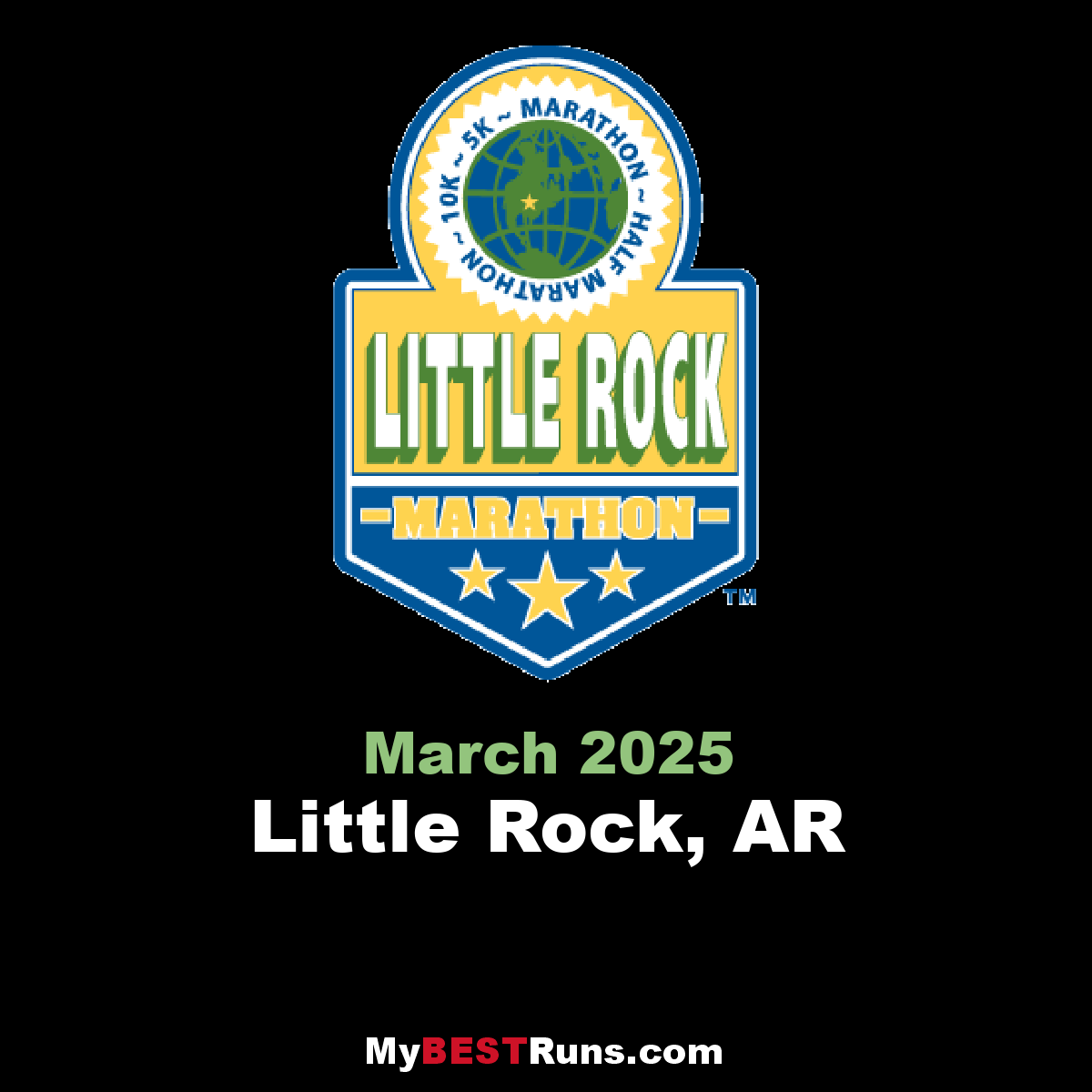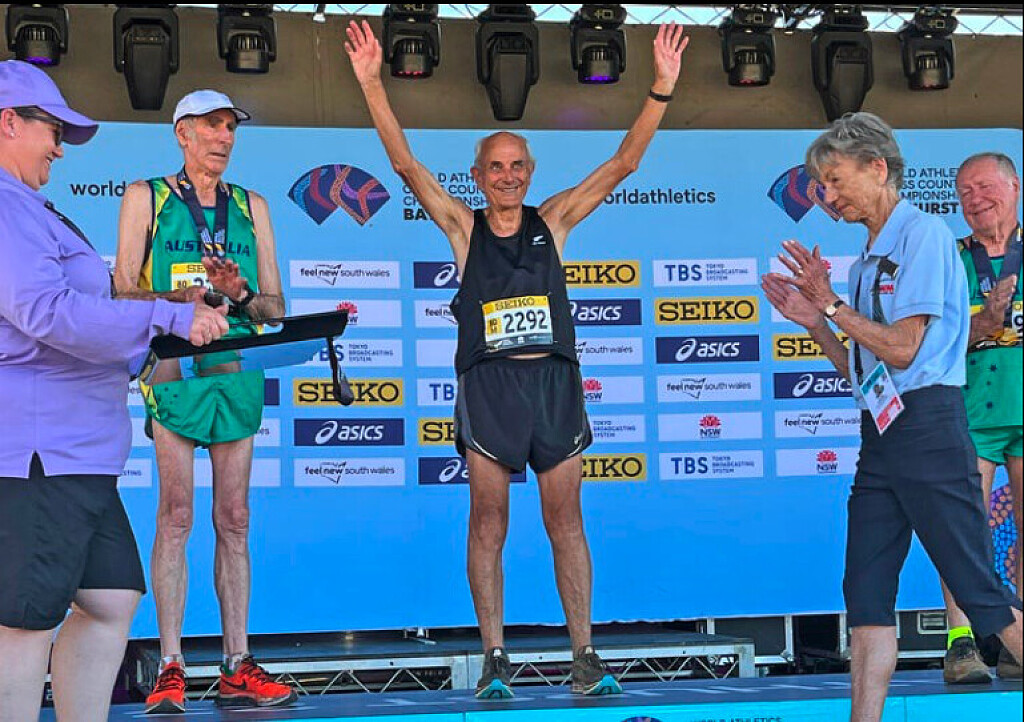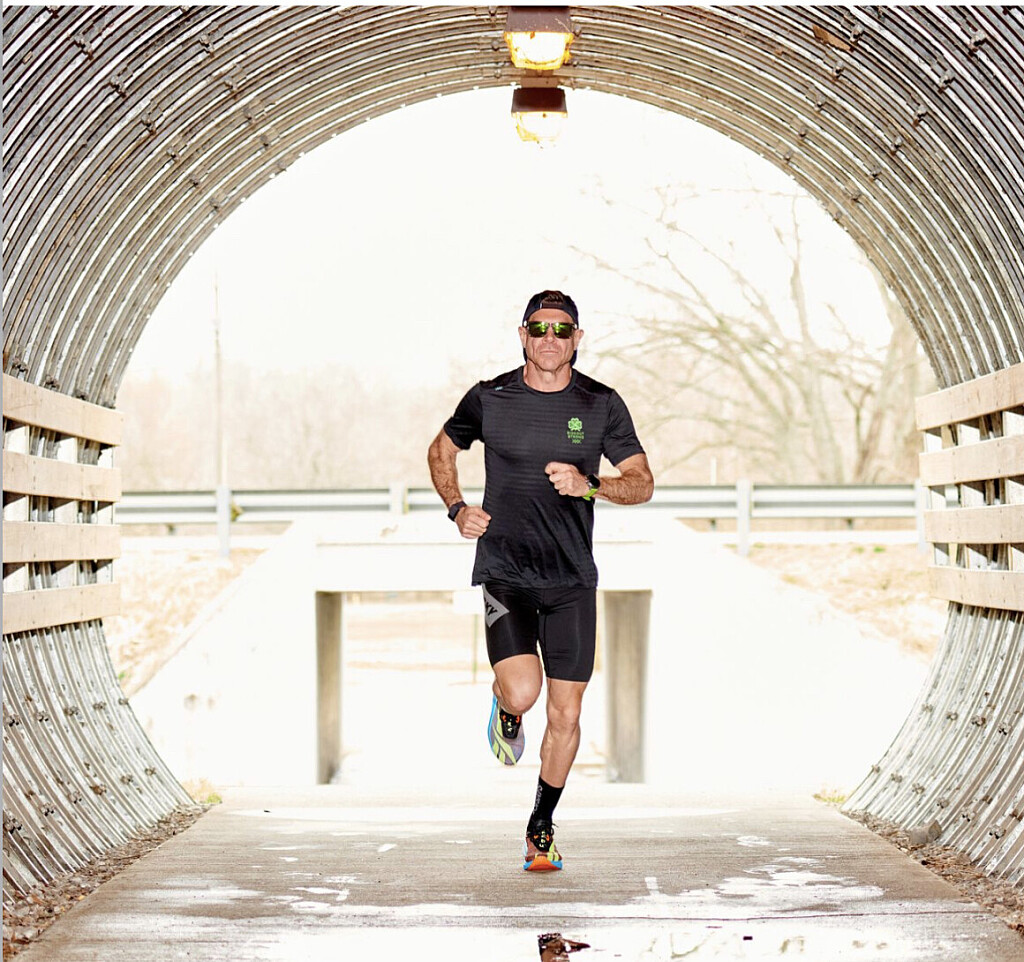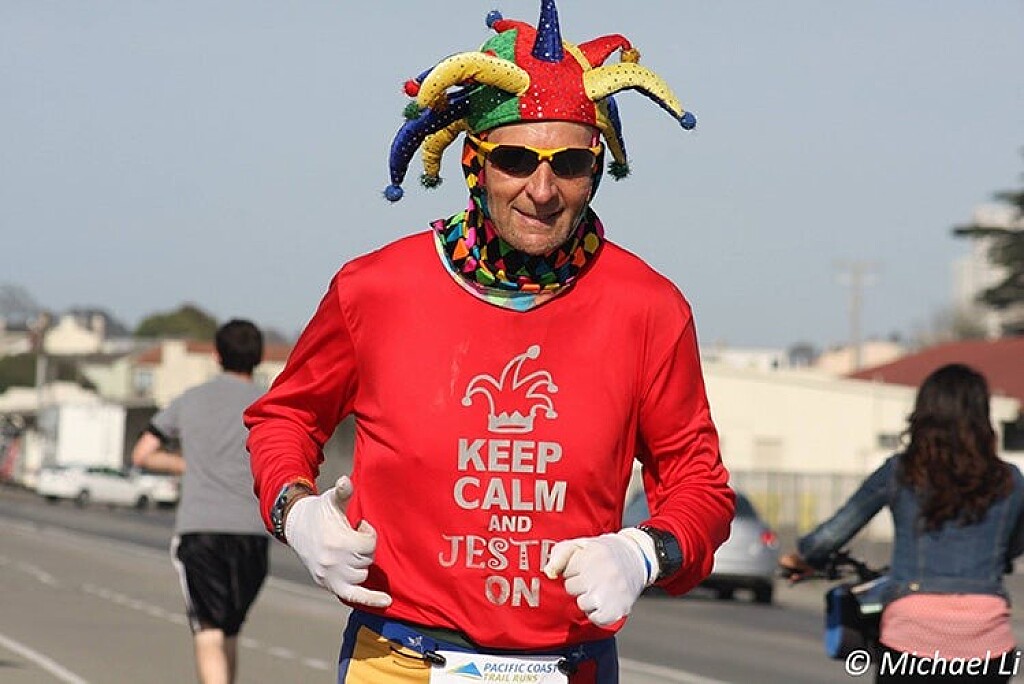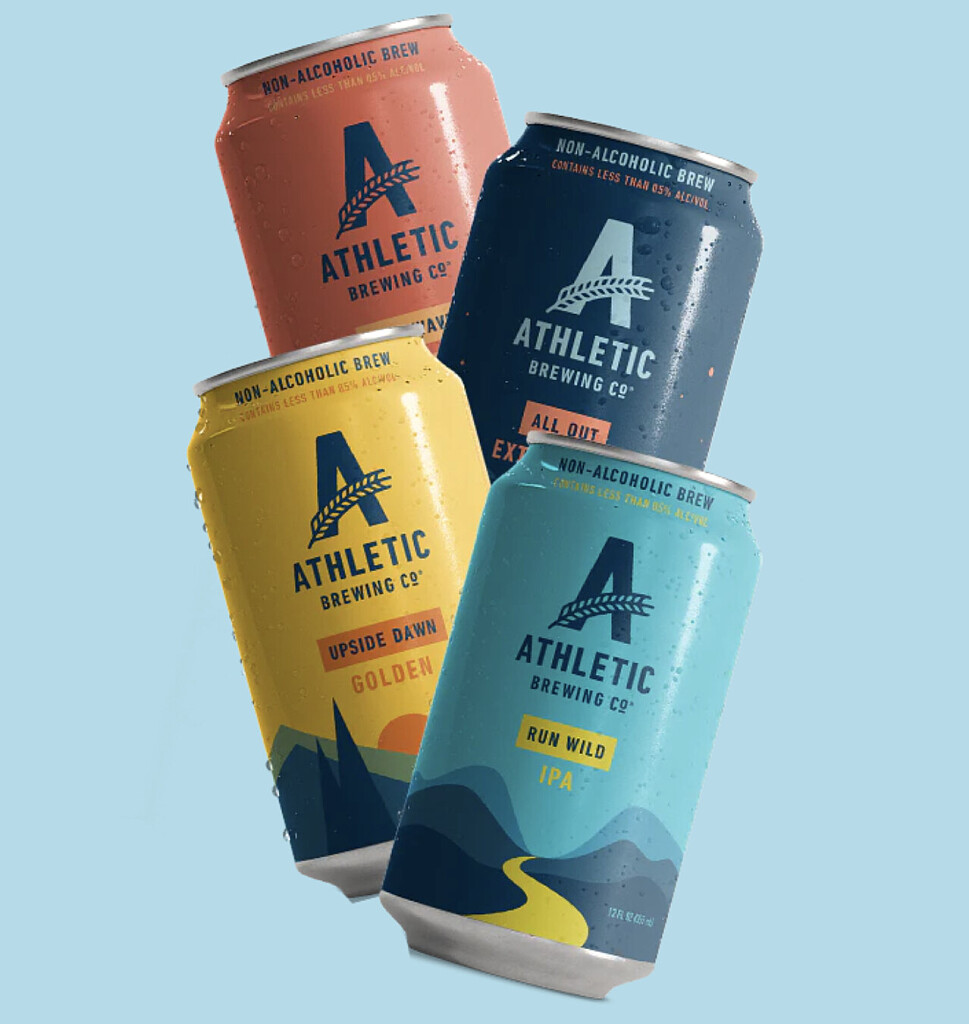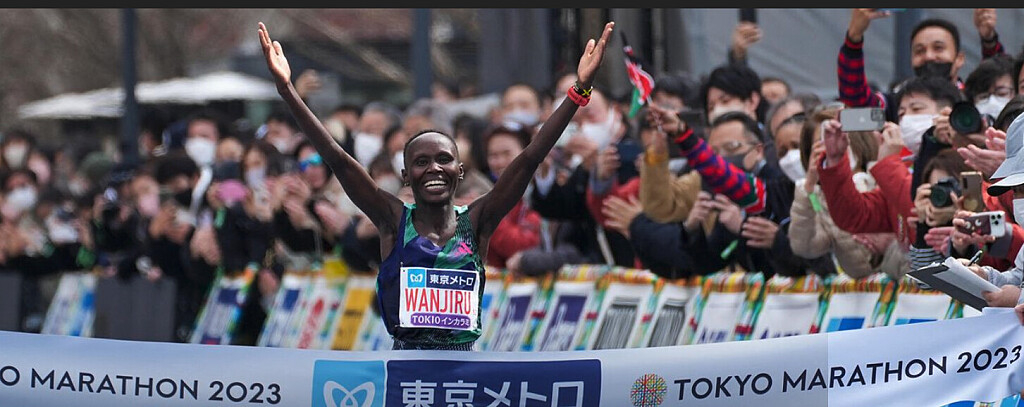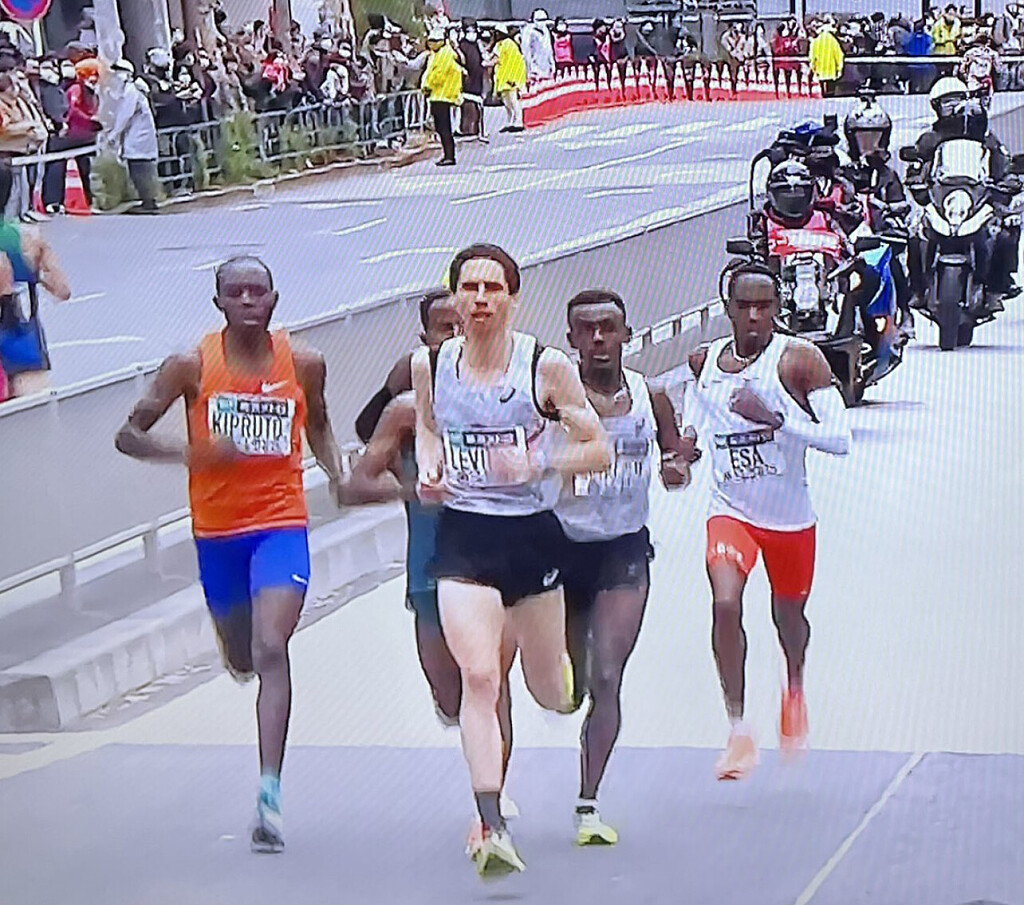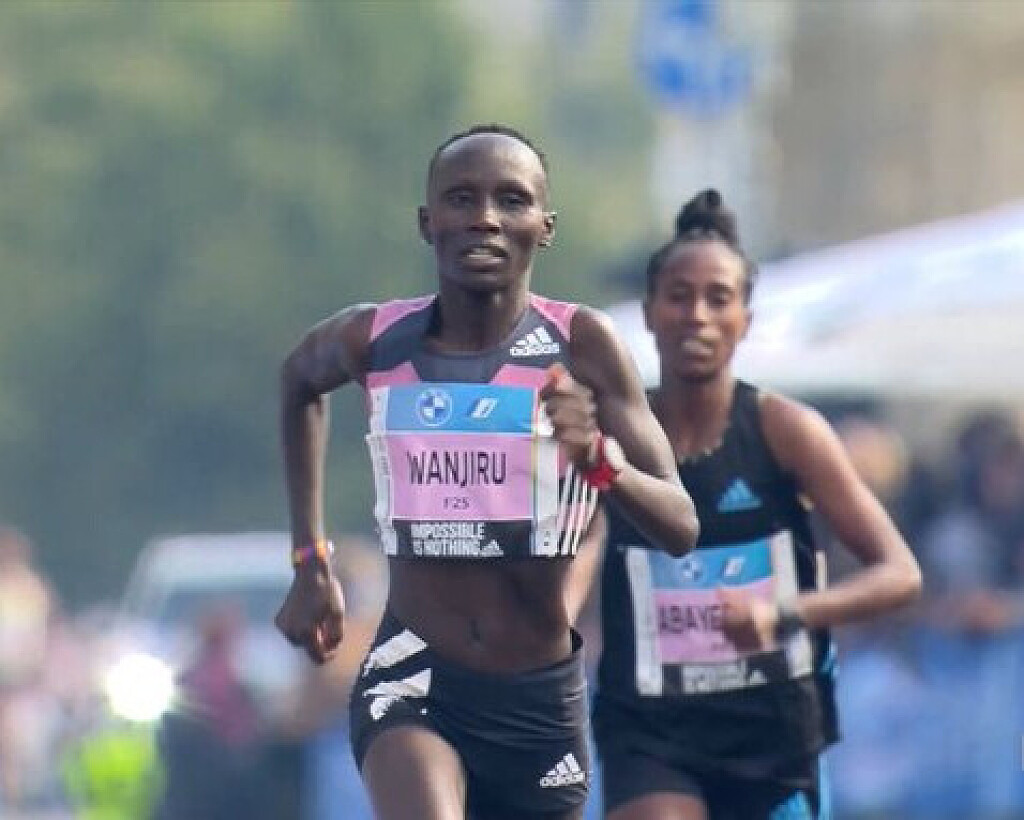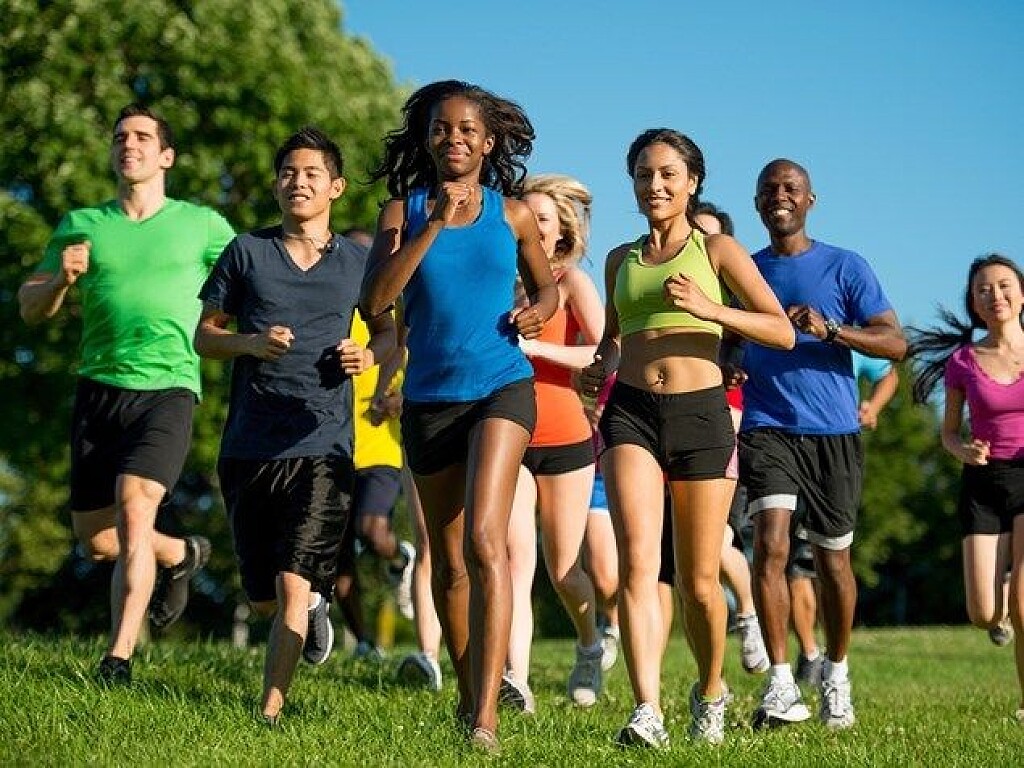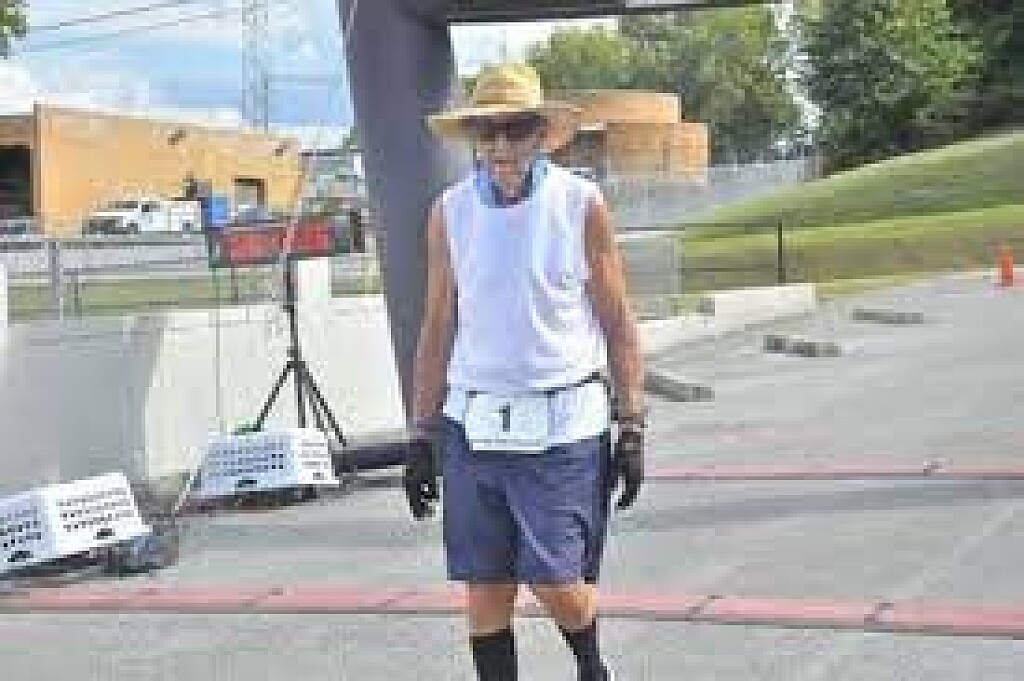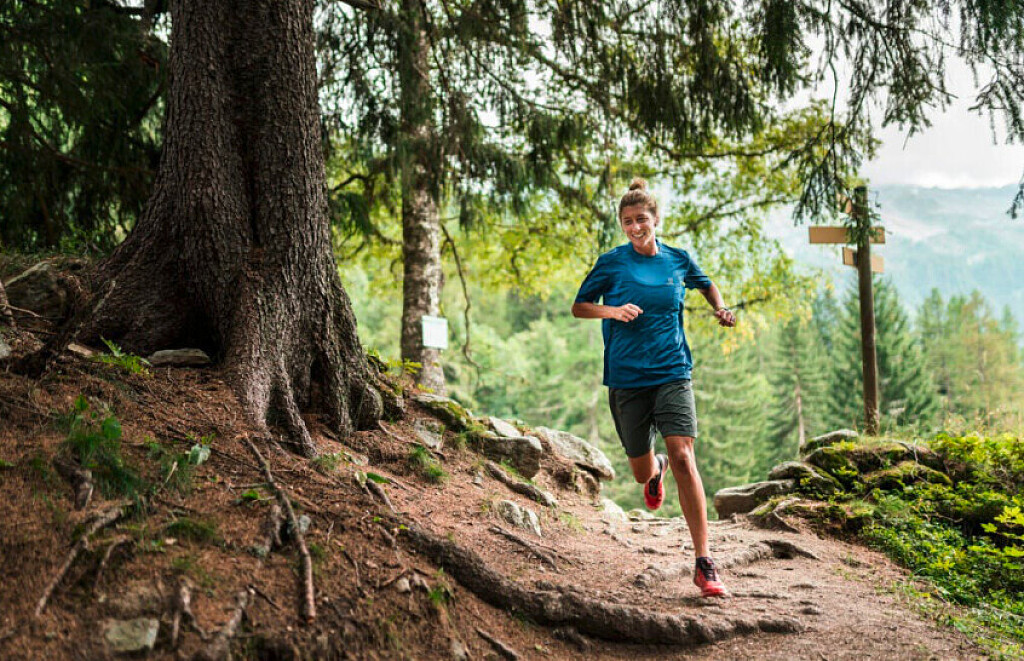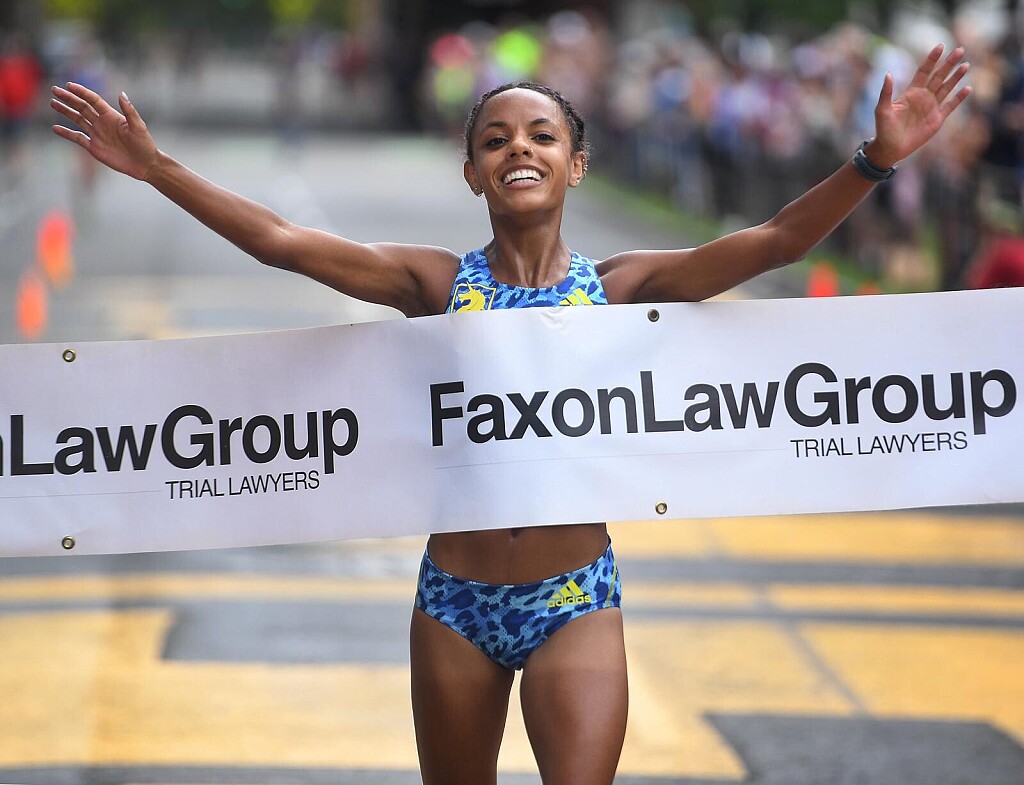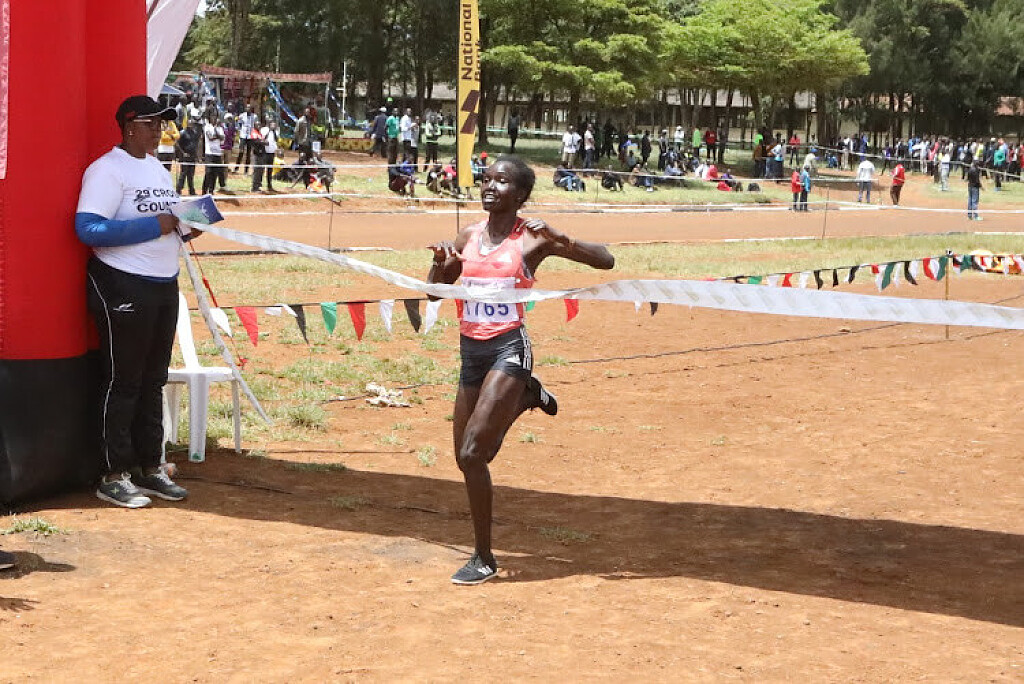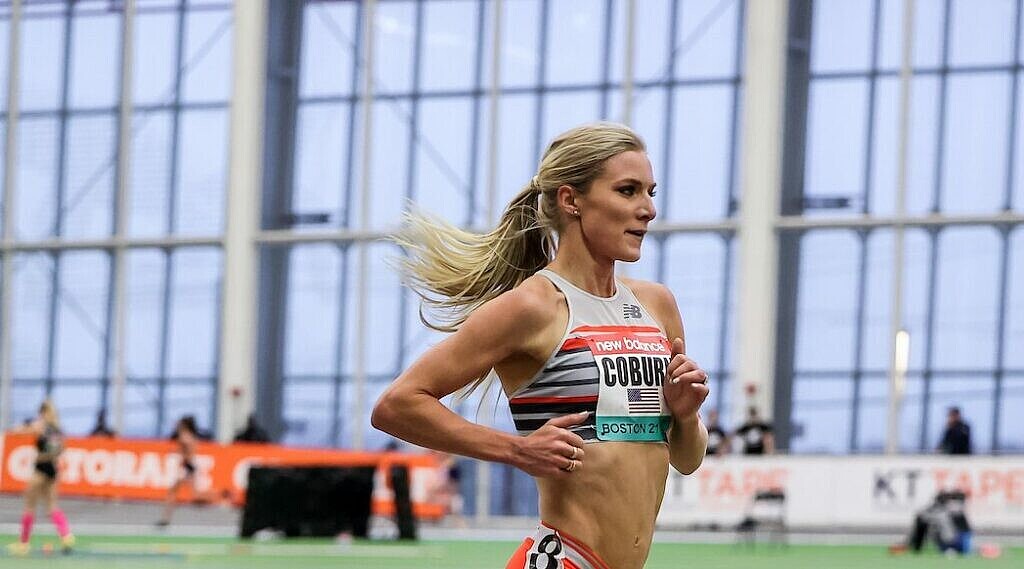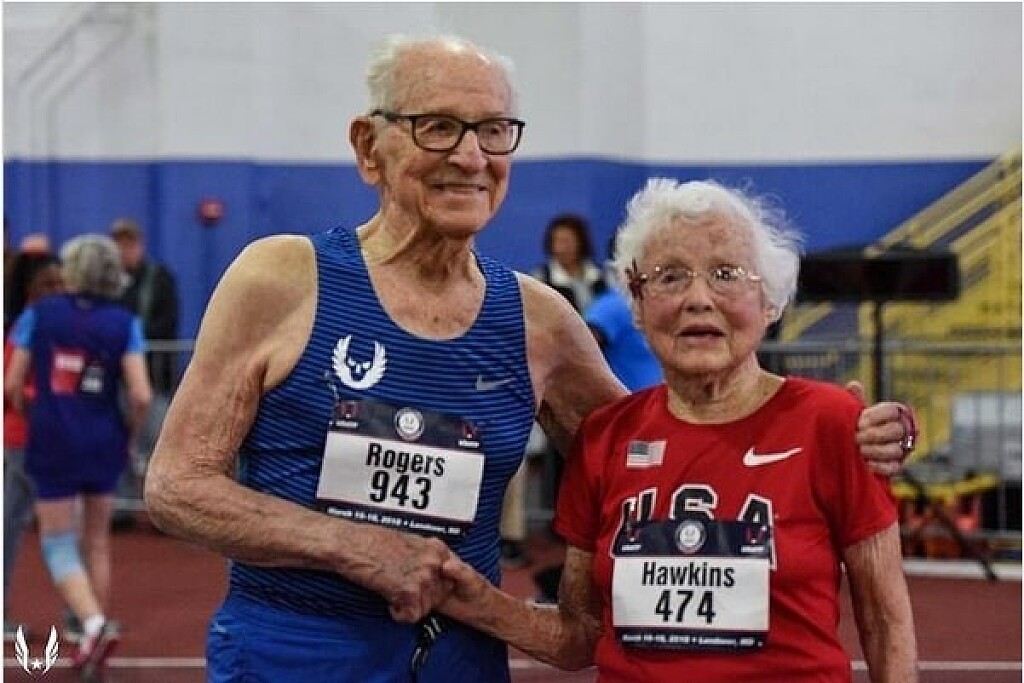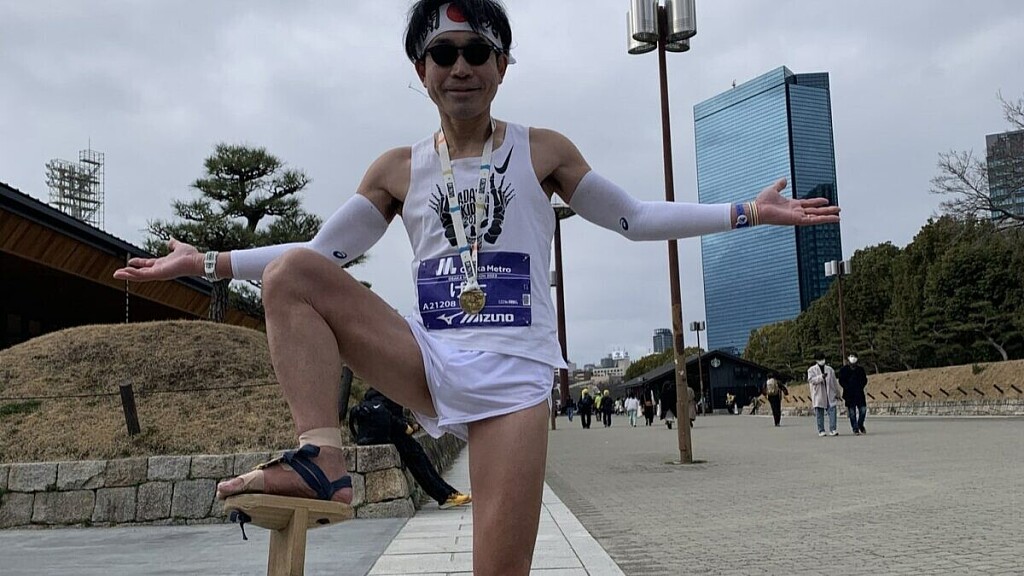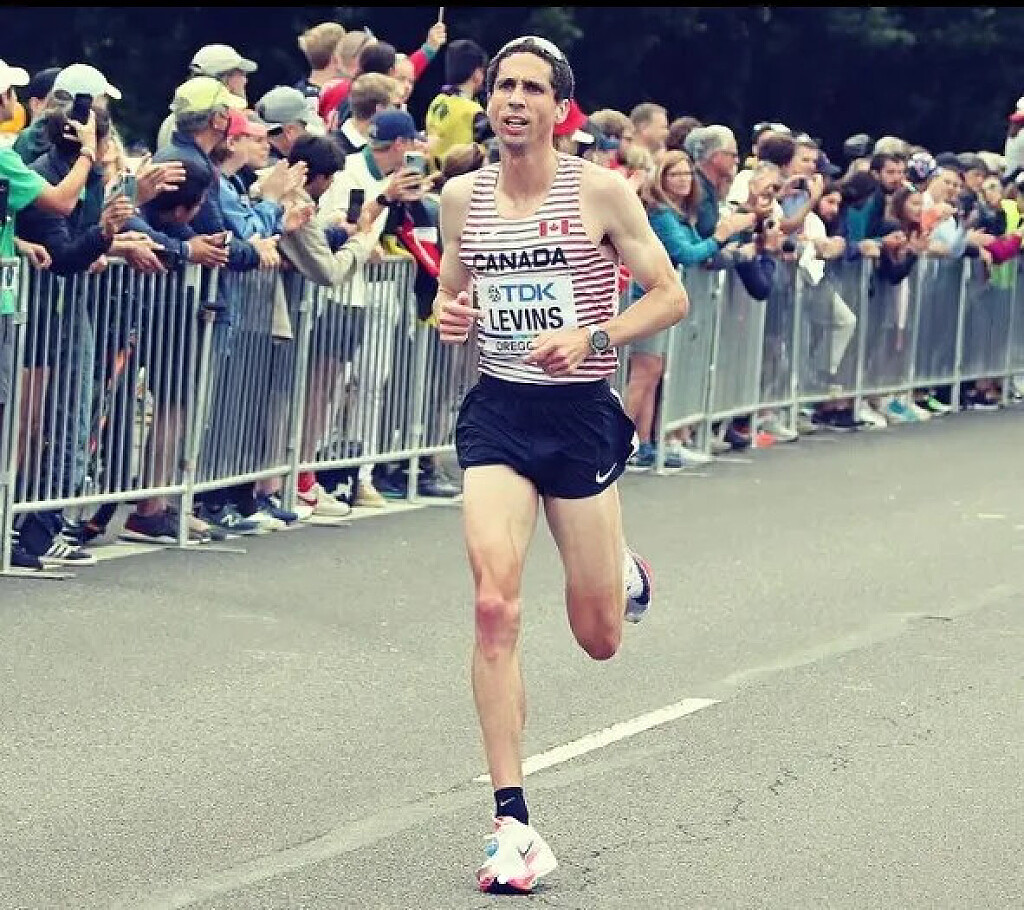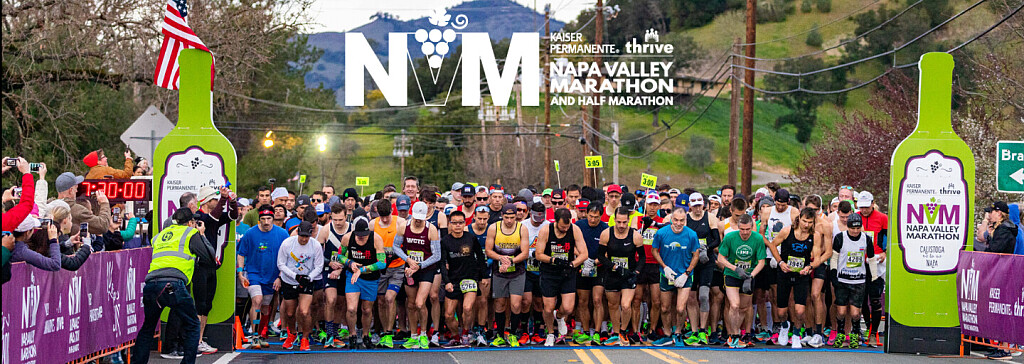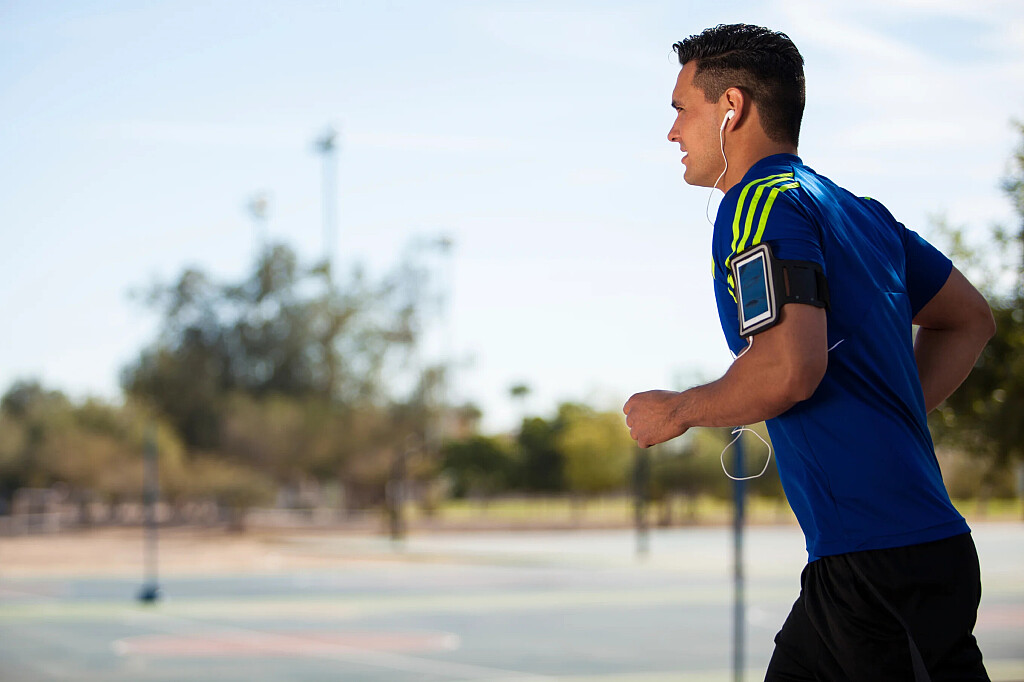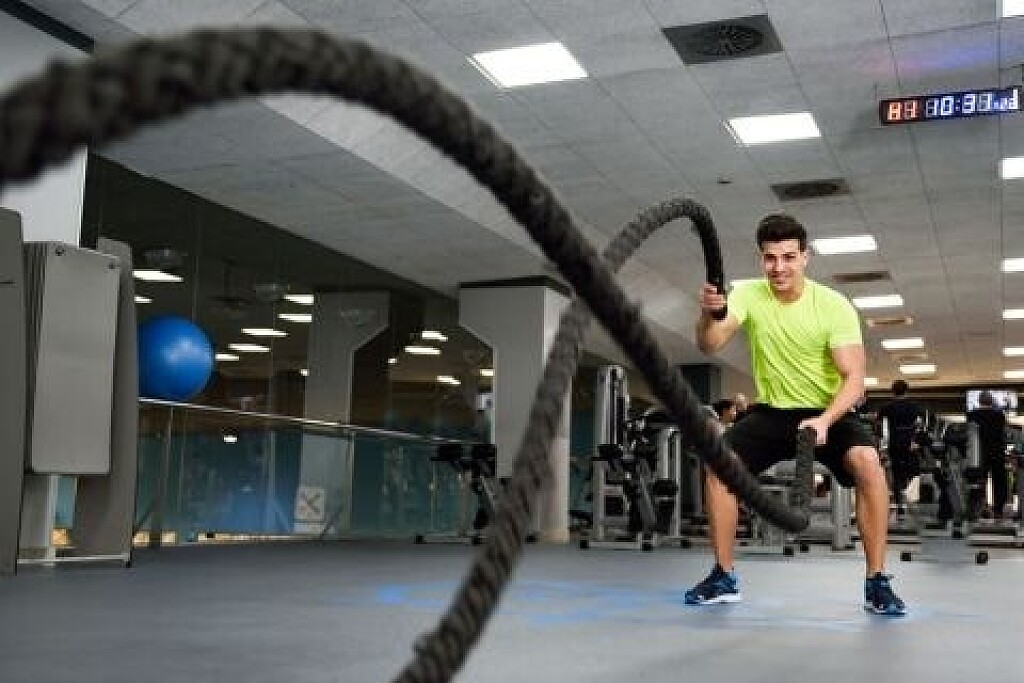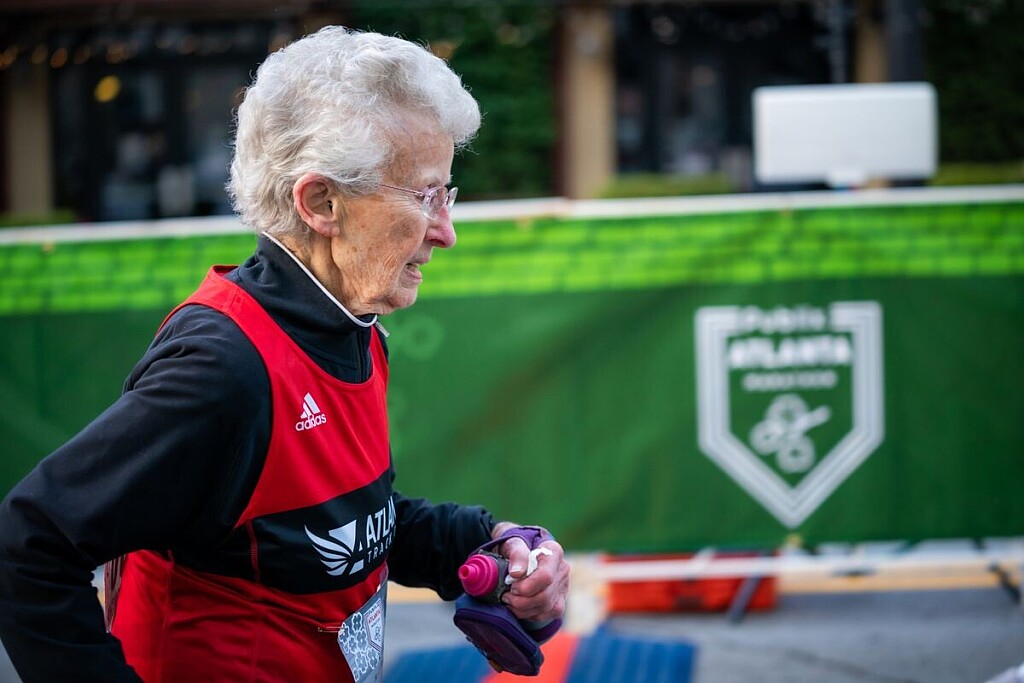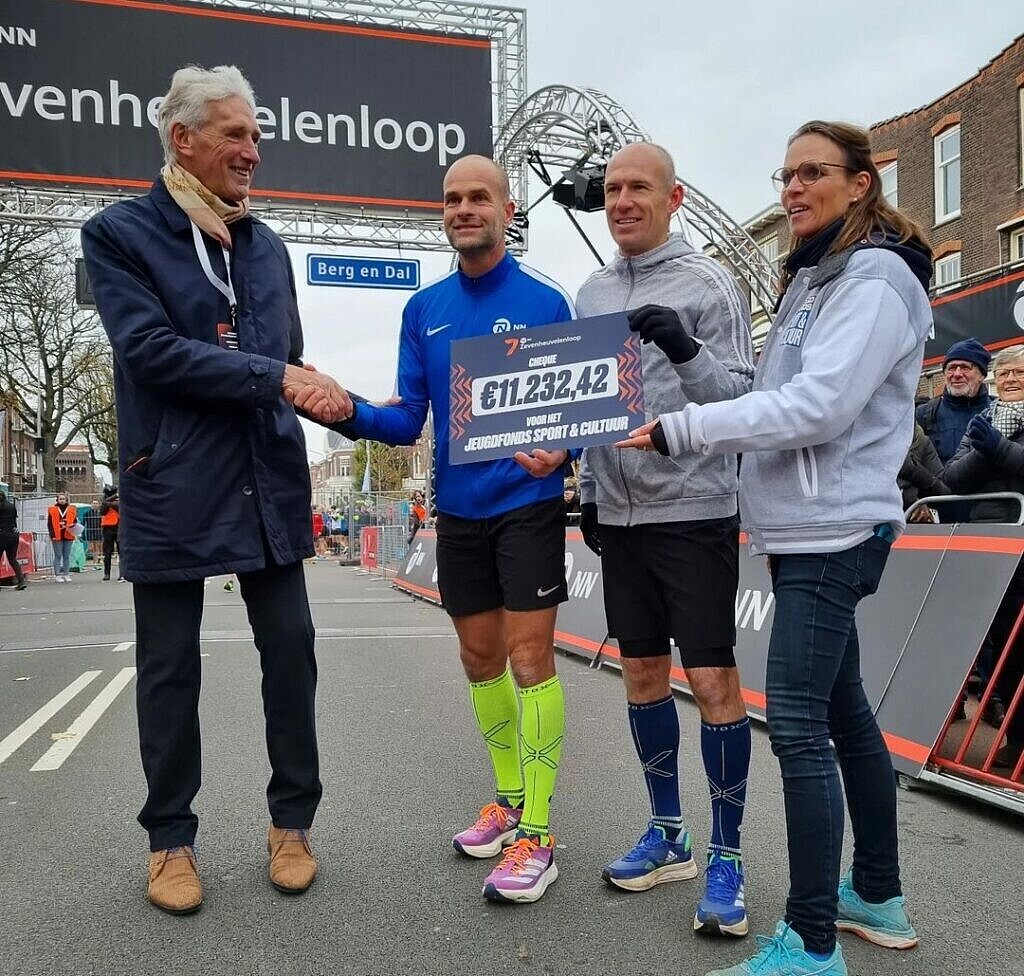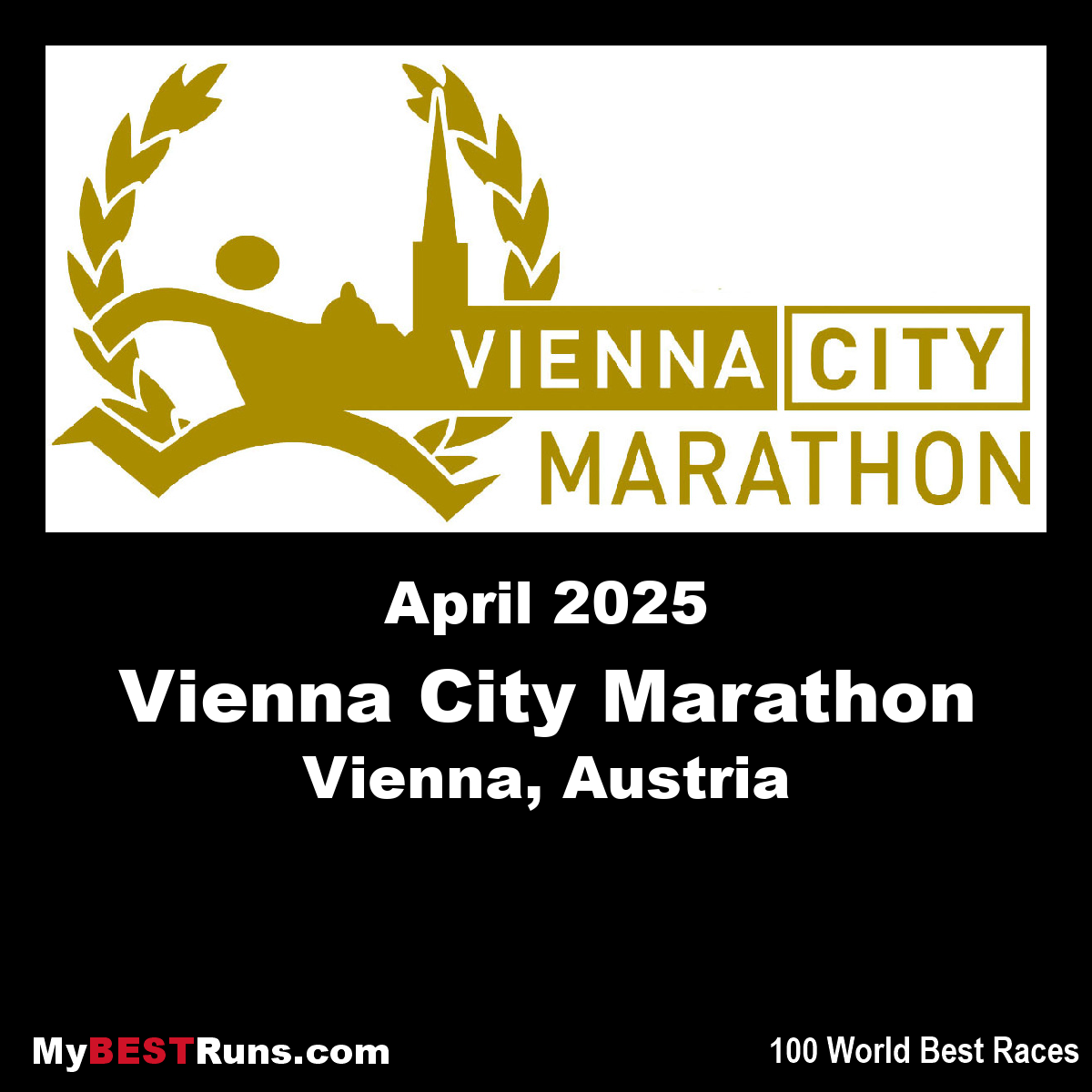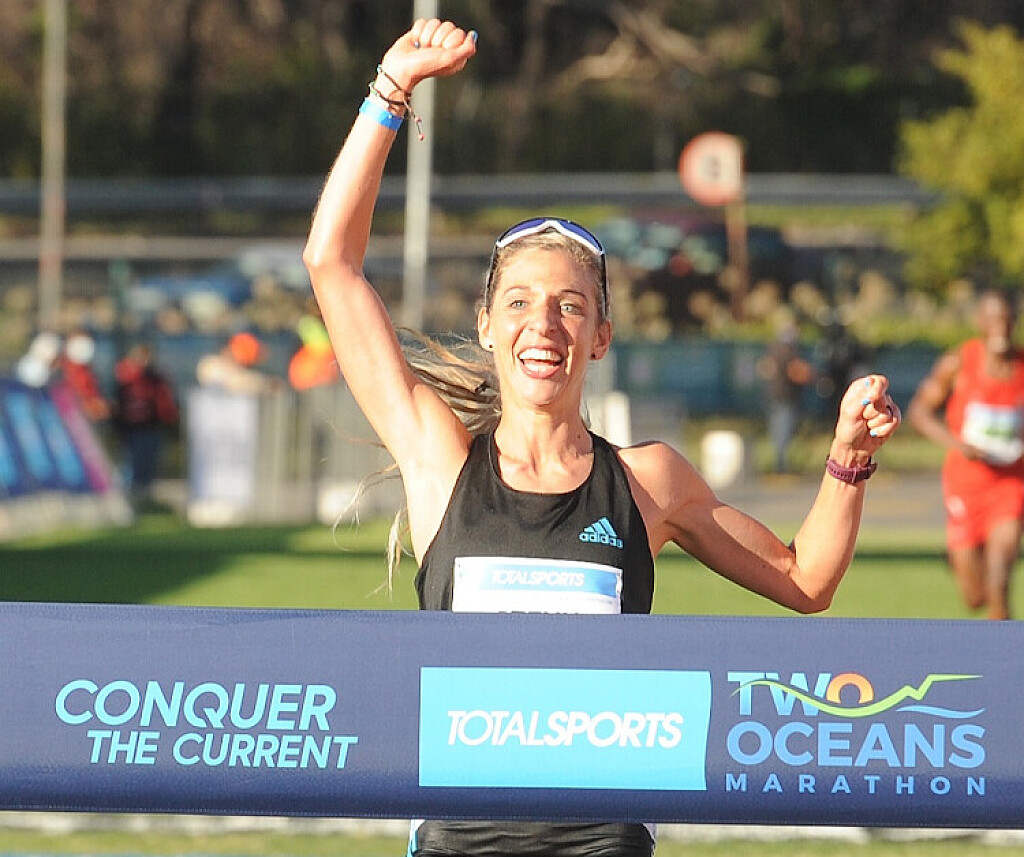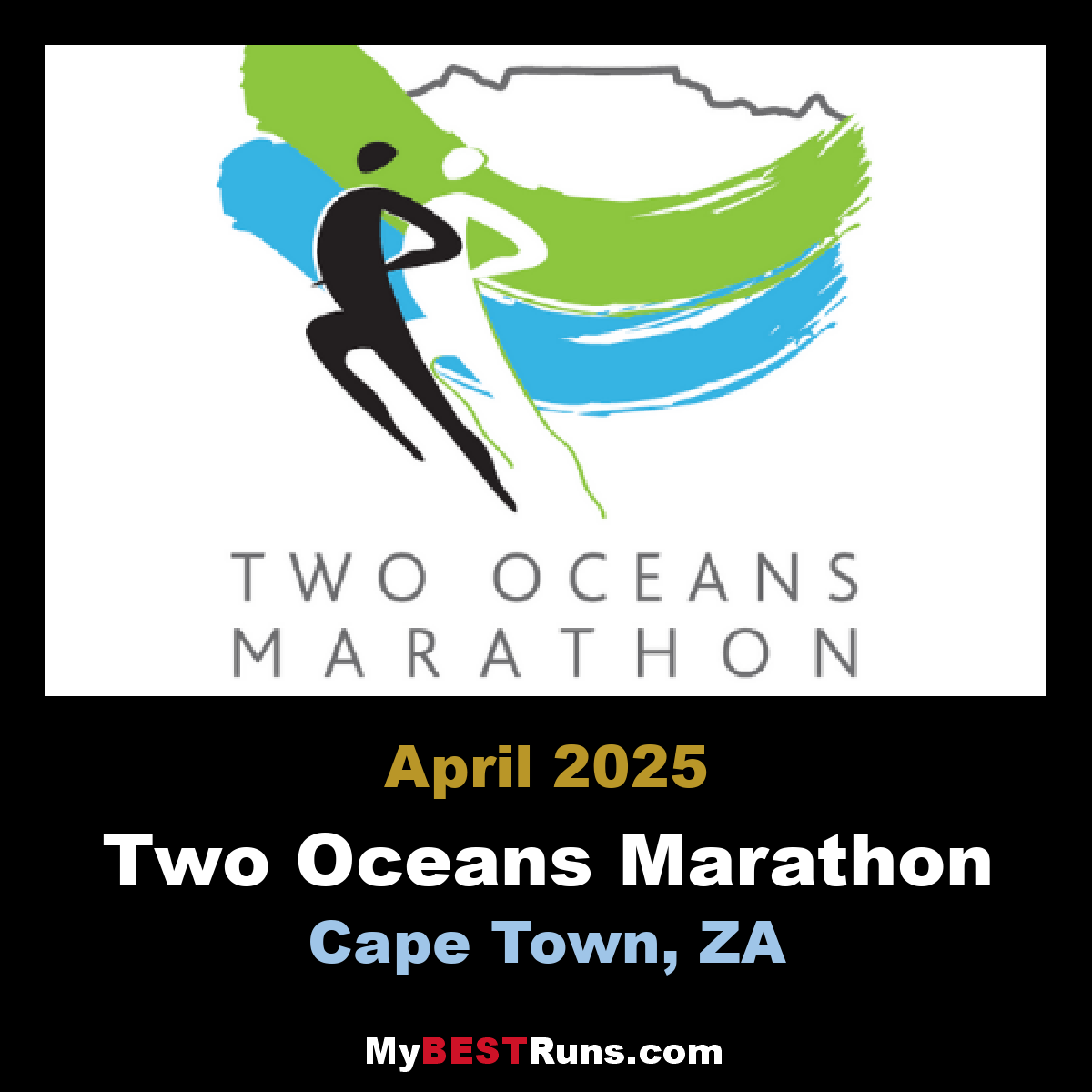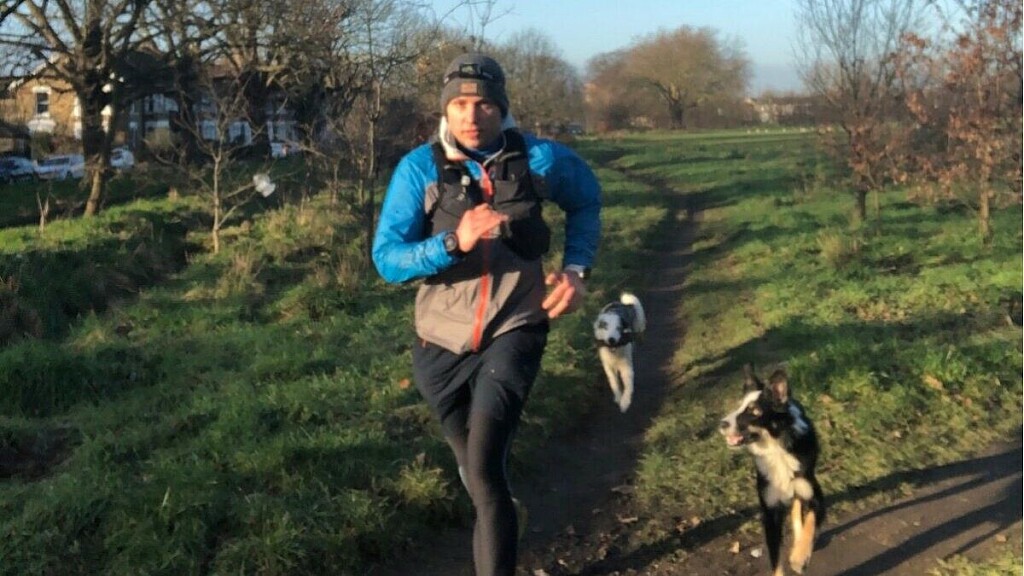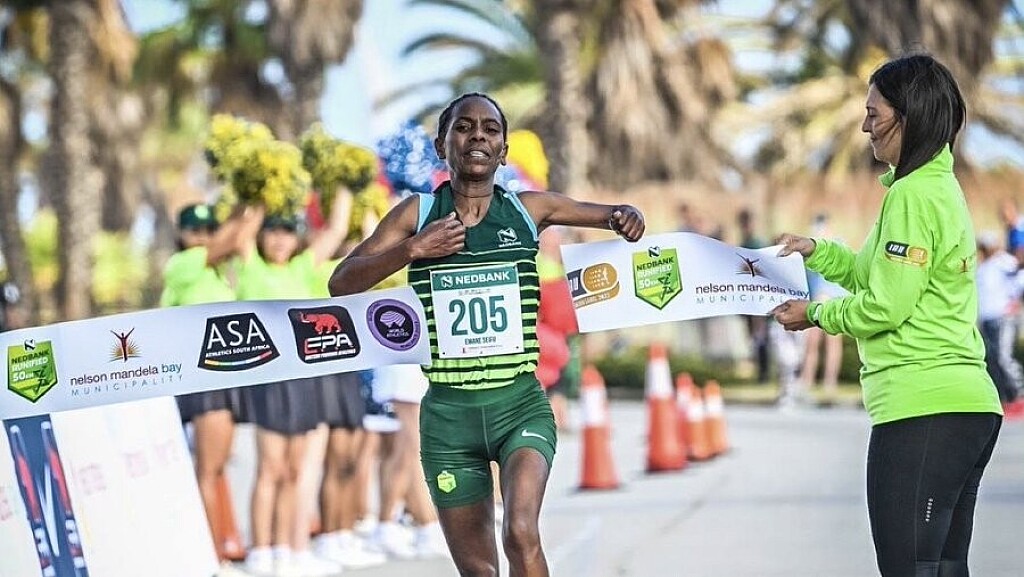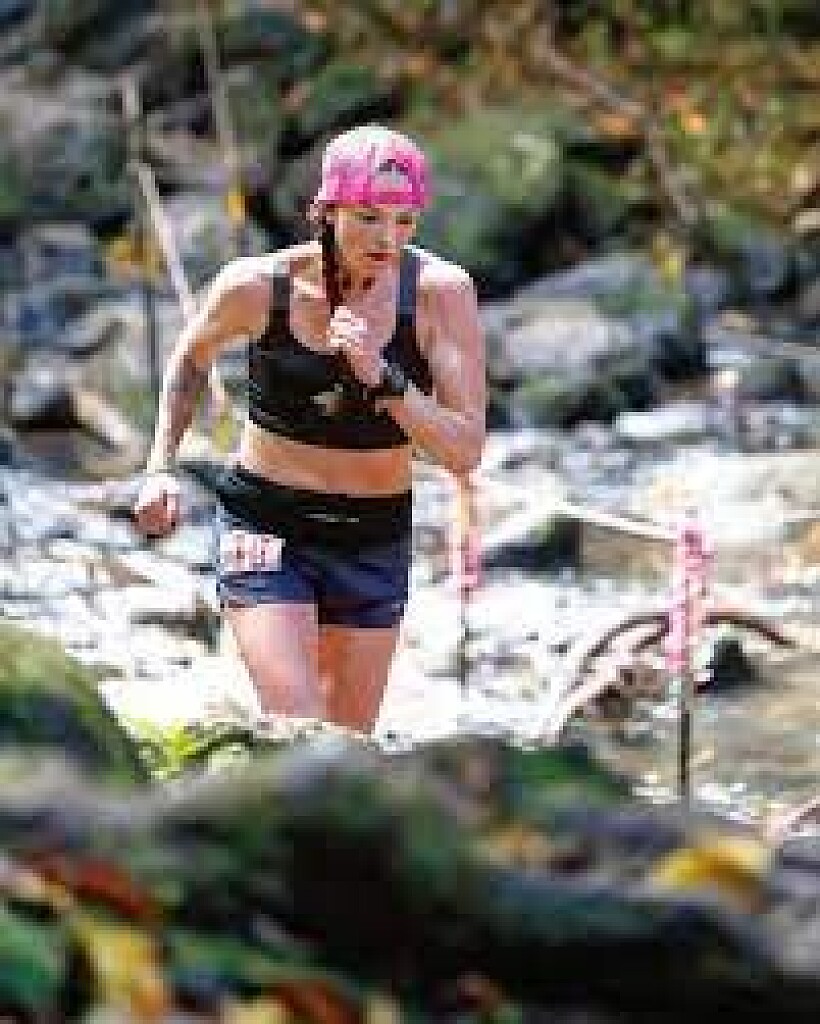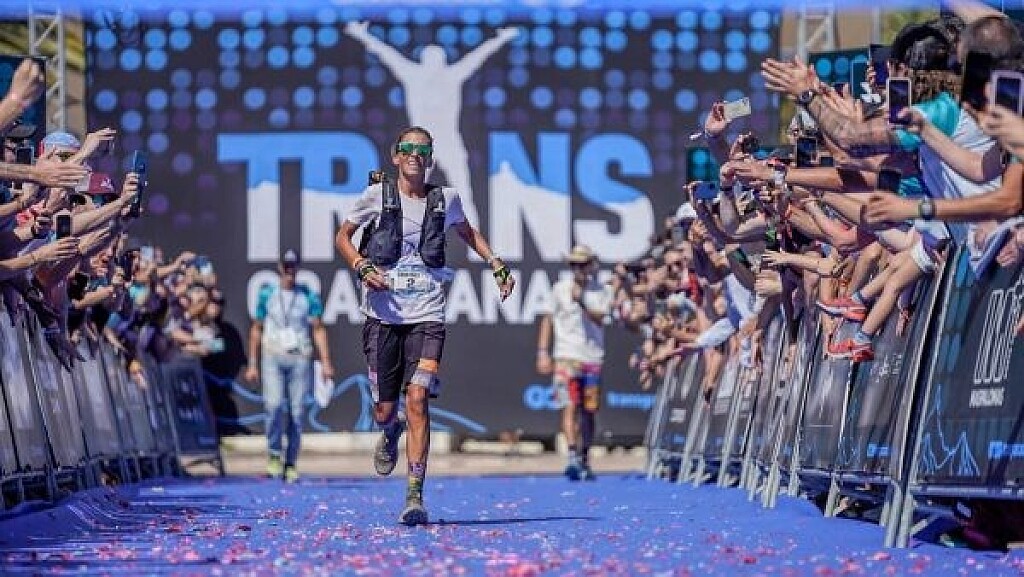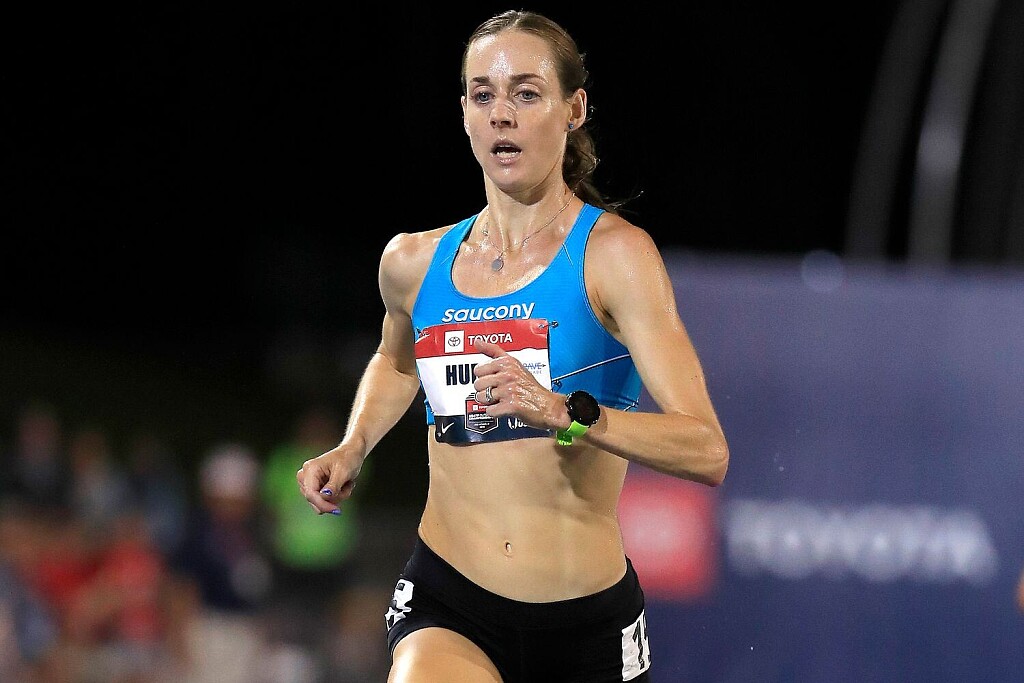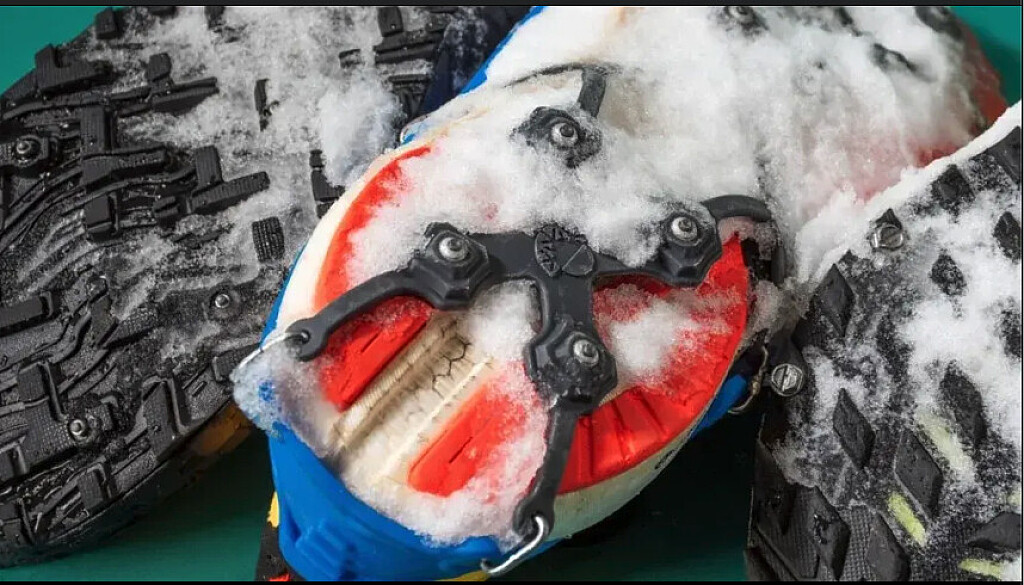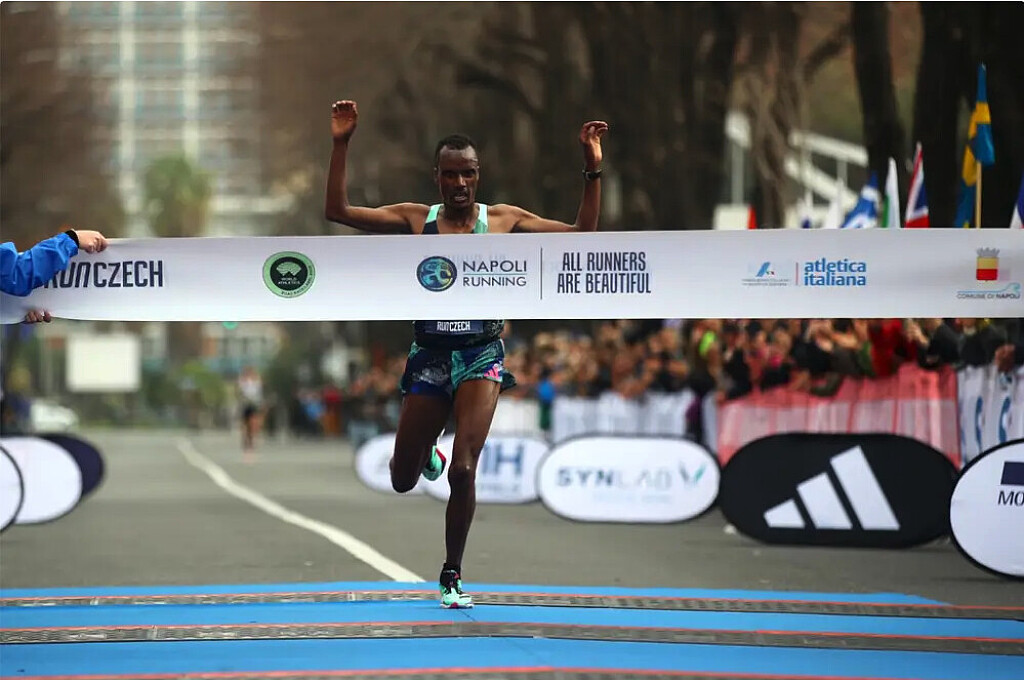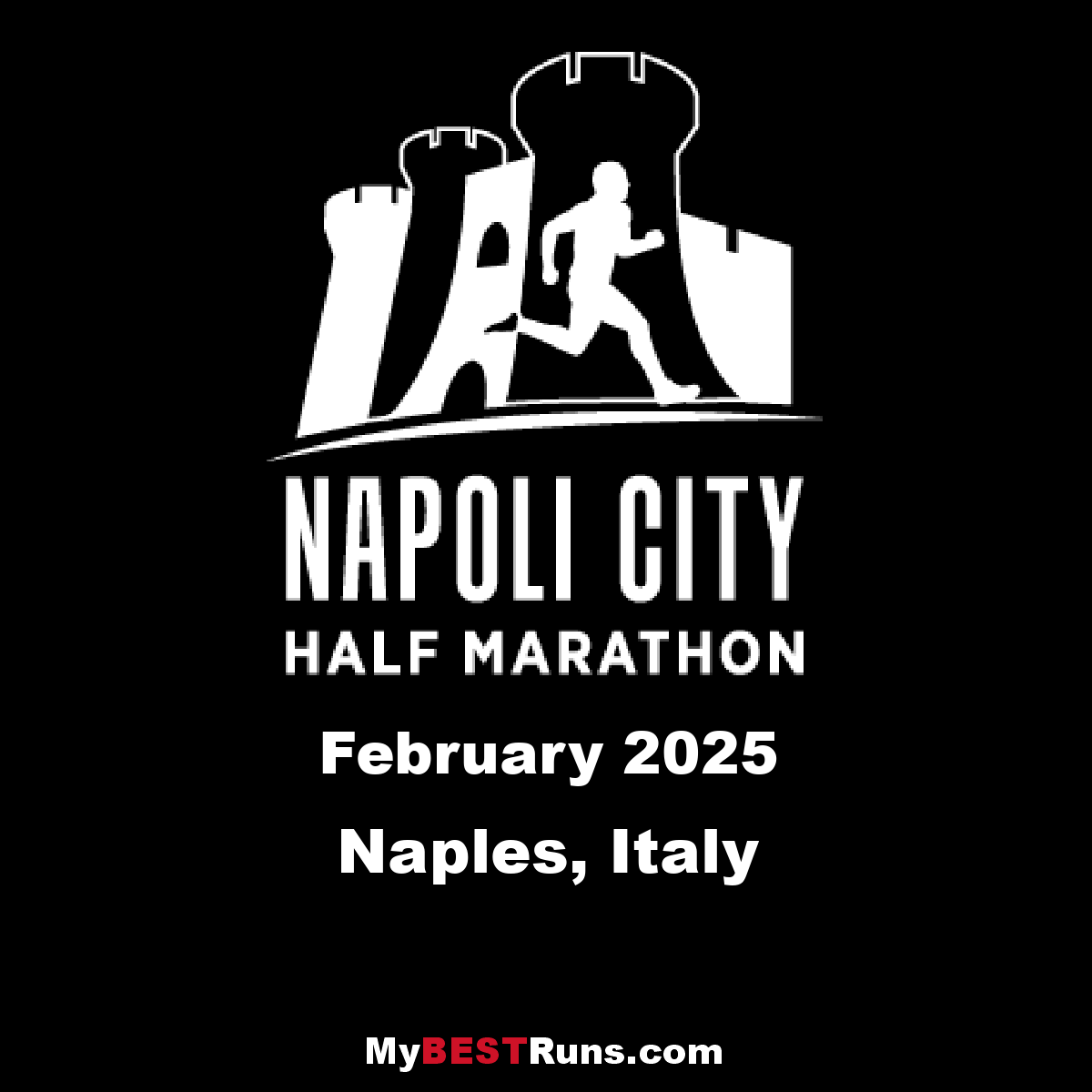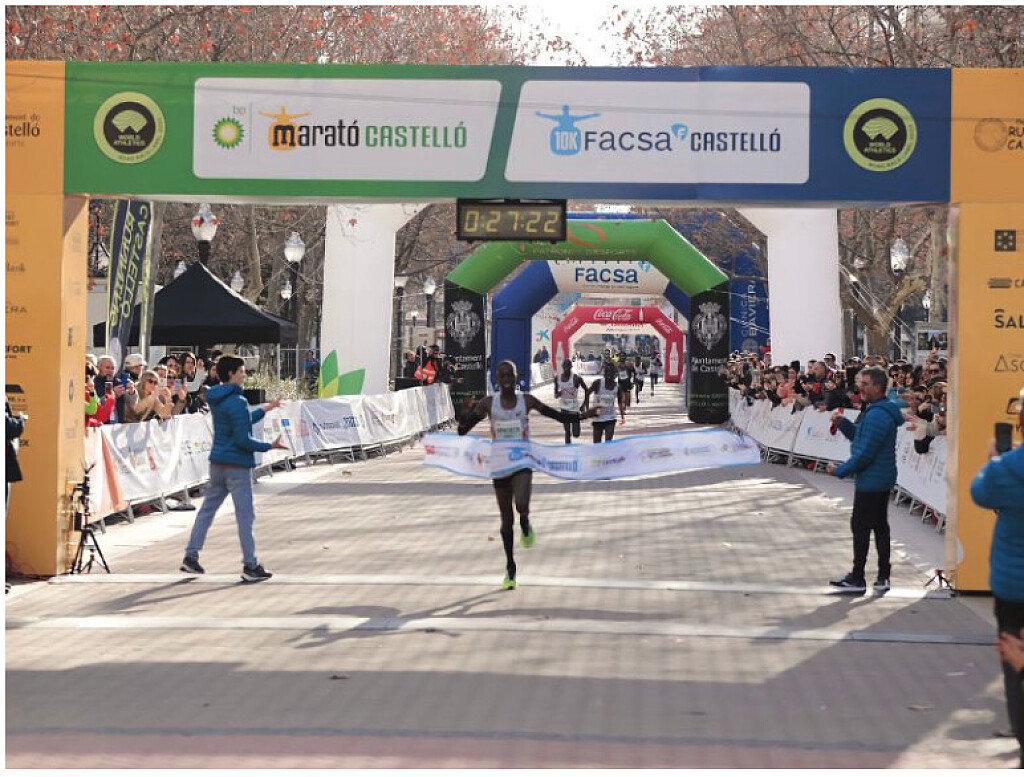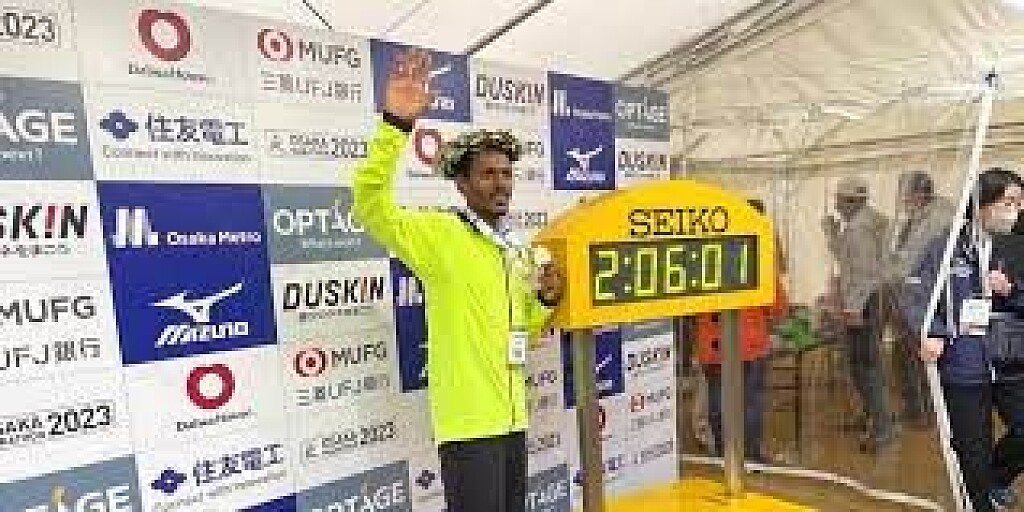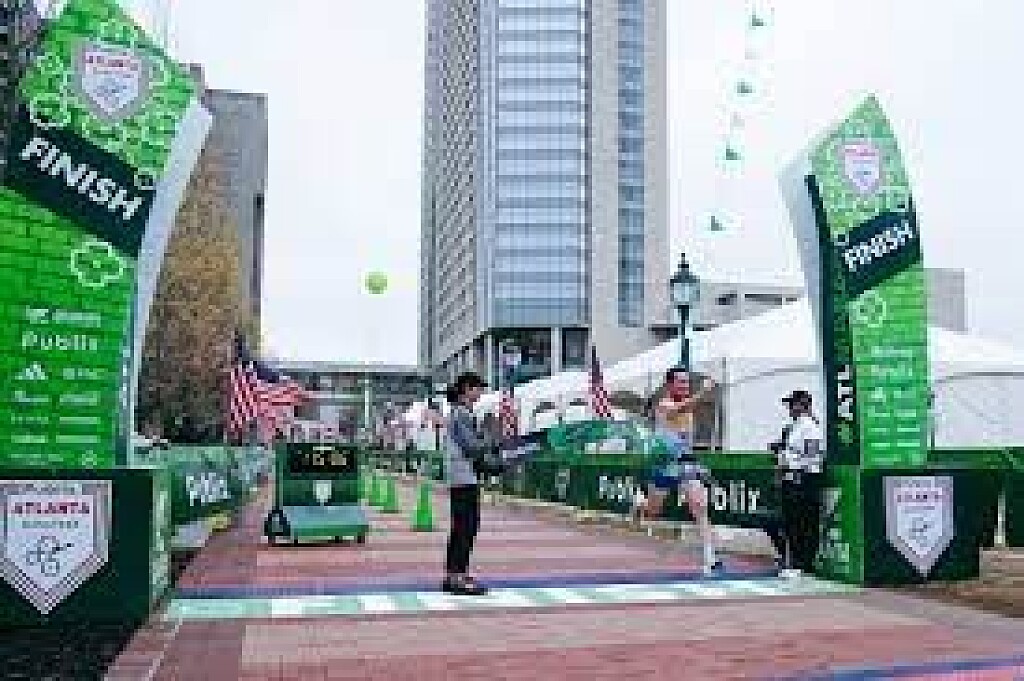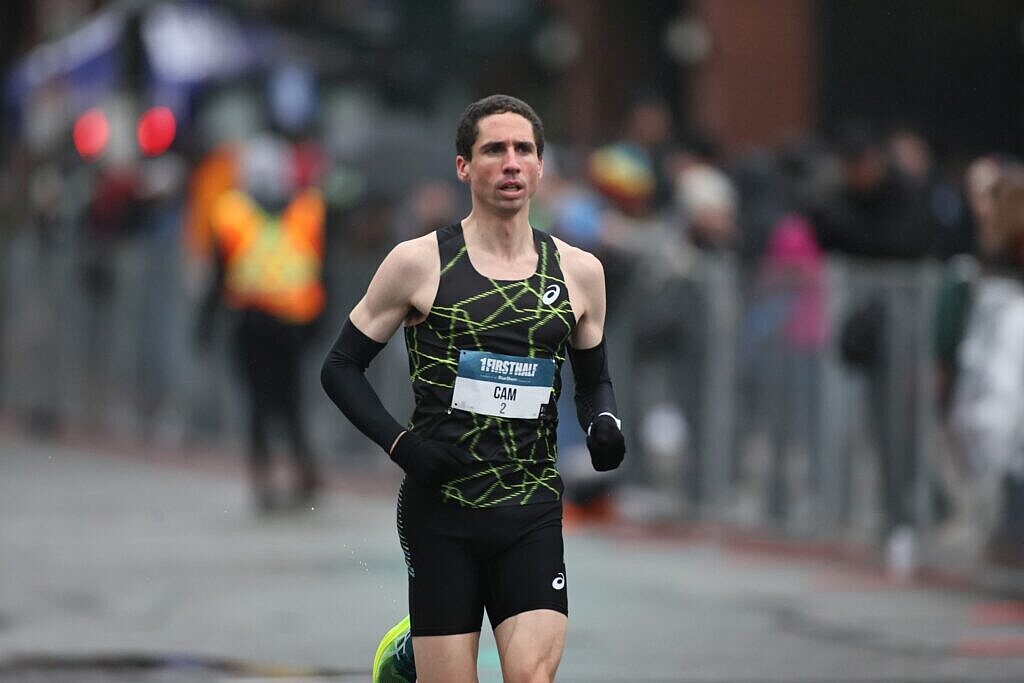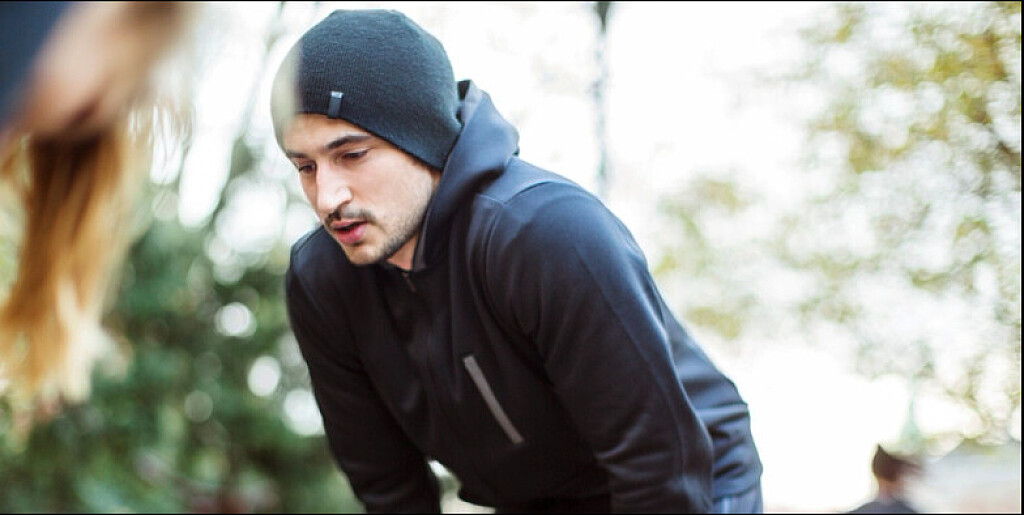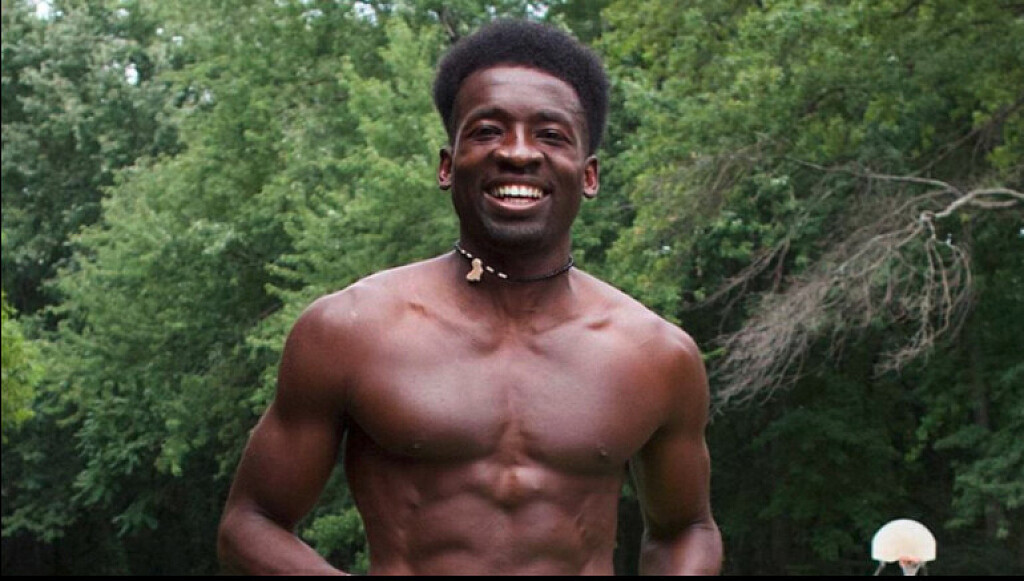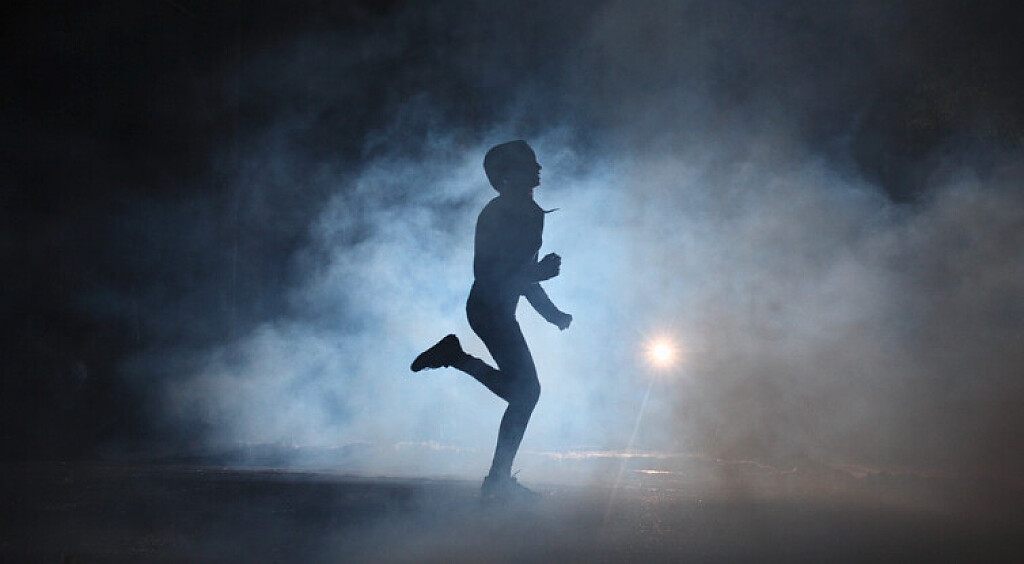Running News Daily
Running News Daily is edited by Bob Anderson. Send your news items to bob@mybestruns.com Advertising opportunities available. Train the Kenyan Way at KATA Kenya and Portugal owned and operated by Bob Anderson. Be sure to catch our movie A Long Run the movie KATA Running Camps and KATA Potato Farms - 31 now open in Kenya! https://kata.ke/
Index to Daily Posts · Sign Up For Updates · Run The World Feed
Colin Boerger and Jessy Sorrick win 2023 Little Rock Marathon
Colin Boerger and Jessy Sorrick are the winners of the 2023 Little Rock Marathon.
Beginning shortly after 11 a.m. Sunday and continuing into the afternoon, finishers of the 21st Little Rock Marathon will trickle across the finish line on La Harpe Boulevard.
Their legs plenty tired after completing the 26.2-mile course, runners will take a couple hundred more steps, following the signs directing them inside the back of the Statehouse Convention Center.

The runners will pose for pictures, then go grab a snack to refuel or some more water. Others might go for a celebratory Michelob Ultra -- or two -- before seeking out their friends and family for a hug.
But before any of that, each finisher will find a smiling volunteer and bow their head, awaiting one of the hundreds of oversized, sparkly, brightly-colored medals that will be placed around their neck.
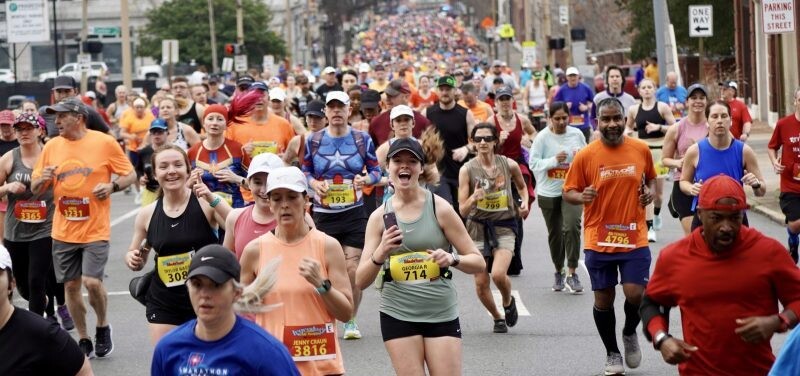
Since its third edition in 2005, the Little Rock Marathon has awarded those who complete the race with a distinct, intricate prize -- enormous in size while also extravagant in detail.
This year's medal is no different, measuring in at more than 8 inches wide and nearly 3 pounds. Inspired by the theme, "Peace, Love, Little Rock Marathon," it features an interlocking peace sign and heart surrounded by symbols associated with the hippie movement such as flowers, doves, music and a van, brought to life with an array of bright, sparkly colors as is tradition for executive director Geneva Lamm.
Year after year, Lamm attempts to one-up herself with a unique and elaborate design, ensuring that each runner -- everyone from Searcy native Tia Stone, winner in five of the last seven women's races, to the final finisher -- has something to appropriately commemorate their accomplishment.
The idea spawned from a race Lamm ran in southern Texas shortly after beginning her role with the Little Rock Marathon in 2002. Lamm had just finished the marathon and her friend had completed the 5K race.
"When we finished, we got the same medal, and I was like, 'Oh, no, no, I did the marathon. I didn't do the 5K,' Lamm recalled. "They're like, 'No, that's the medal for everybody.' "
That didn't sit right with Lamm. She believed that everyone should get a medal the size of their individual achievement.
So, Lamm set out to make that the case for her race in Little Rock. She sketched out what she wanted of the first medal -- mostly in stick figures -- but quickly discovered that the companies bidding to produce them had a different idea of what it would actually look like.
That led Lamm to teach herself how to use the Adobe Creative Suite so she could specifically design the medals on her own. In 2006, she produced a sparkly version of the race's corporate logo, which Lamm calls "The Shield."
From there, the medals took on a life of their own, and each year, Lamm tasks herself with designing something one-of-a-kind to fit that race's theme.
In 2008, it was "Six in the City" to celebrate the race's sixth edition. In 2012, the theme was disco. The 2015 race was pirate-themed -- perhaps Lamm's favorite to date -- and as is the case each year, Lamm and race organizers encourage runners to dress in costume.
But idealizing and designing the medals is one thing. It's another to produce them, especially as the race has grown as large as 10,000 total runners across the different competitions -- marathon, half-marathon, 10K and 5K.
Steve Hasty, owner of Hasty Awards in Ottawa, Kan., has worked in conjunction with Lamm on and off for the last 12 years. It's not guaranteed Hasty will be the one chosen to produce the medals each race -- because the Little Rock Marathon is a fundraiser for the City of Little Rock's Parks and Recreation Department, Lamm has to run an annual blind-bidding process to determine who will get the contract for a given year.
But Hasty holds a special place in his heart for Little Rock because the medals are such a passion project for Lamm.
"There's no question that the Little Rock Marathon is the most fun race," Hasty told the Arkansas Democrat-Gazette. "[Geneva] is an educated customer, which makes it a lot easier."
The bidding typically begins in June, and for an early March race, Hasty likes to begin production no later than September.
For the marathon medals, the die-casting process begins by forcing each of the different colors of zinc-based alloy into the molds. Each of the different colors, many with glitter -- a Lamm specialty -- is allowed to dry before Hasty moves on to the next color.
All told, creating the Little Rock Marathon medal takes about 50 days. That's before the ribbon is hand-sewn on, all adding up to a cost of $13 per medal and leaving little profit margin for Hasty.
The goal is then to have all the medals completed and in Little Rock no later than January. Across the different competitions, that's between 9,000 and 10,000 medals -- almost a 400% increase from the 2,502 that participated in the inaugural race in 2003.
Lamm keeps a notepad on her desk at home with ideas for future themes, and she's already thinking about concepts and designs of medals for at least the next five years.
After 19 years, it's nothing but "a labor of love."
"It's always on my mind," Lamm said. "We're always trying to figure out how to do something better and new. ... The payoff for me and my staff is seeing those people cross the finish line."
(03/06/2023) ⚡AMPby Mitchell Gladstone
Little Rock Marathon
The mission of the Little Rock Marathon is provide a premier event open to athletes of all abilities, while promoting a healthy lifestyle through running and walking and raising money for Little Rock Parks & Recreation. Since inception in 2003, more than $1,093,000 has been donated to Little Rock Parks & Recreation. Little Rock Marathon Race Weekend is held the...
more...How I Won the World Cross-Country Championship at Age 83
Seventy years after his first cross-country race and 46 years after competing as an elite runner, the author competes—and triumphs—on a tough Australian course
Last weekend, in Bathurst, Australia, I did something I thought I would never do again: I ran once more in the World Cross-Country Championship. Not the main men’s open race, in which I competed for England in 1966 and New Zealand in 1977. Not at age 83. But for the first time, the World Athletics federation added Masters championships, and—almost like a dream—I not only participated again, but raced at the front of the M80 field and managed to outlast a stubborn Australian for the win.
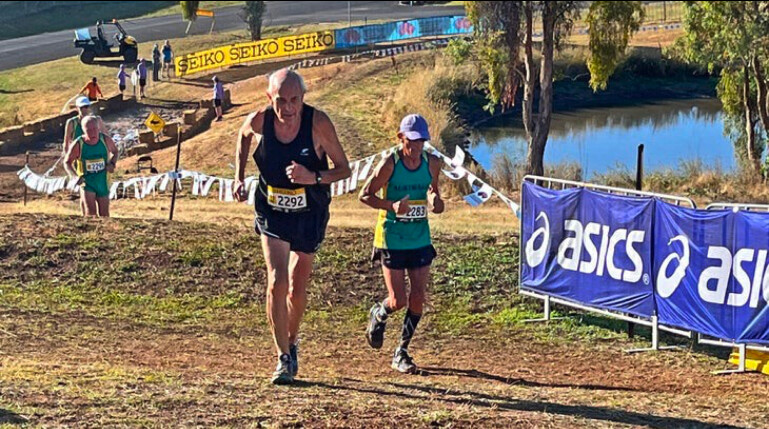
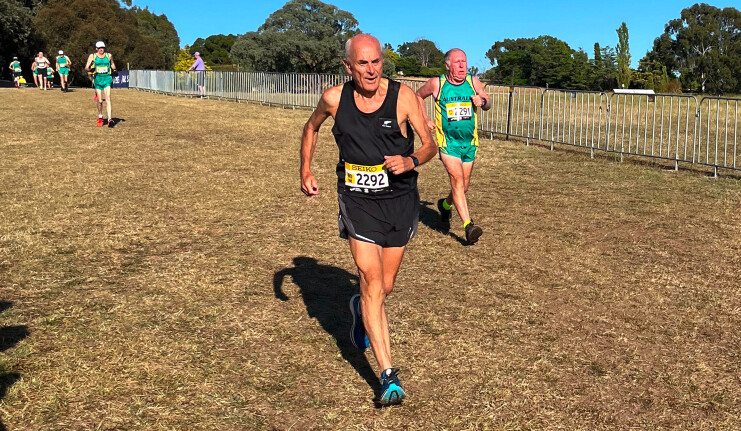
If you believe that running after eighty is about leisurely slow toddling, wait till you’re up there, racing to your limit, and you make the sharp u-turn at halfway and see that you are being closely stalked by a lean lanky Aussie with M80 on his bib and a threatening scowl like Mel Gibson in Lethal Weapon.
He is called James Harrison, and he made me work for it. I have won and lost many hard races over the years, and this was one of the hardest. The only possible tactic was unrelieved pressure. I finally broke him three-quarters through the four-kilometer distance, on the second two-kilometer lap, as we gasped up a big steep rough-surfaced hill that broke many hearts that weekend. At last, I sensed him drop. It took tenacity, months of focused training (including hill repeats), and years of learning the wiles that true cross-country demands.
This was a course where every decision counted about where you placed your next stride. Every sharp oxygen-draining uphill demanded that you keep momentum over the crest, every downhill was there for attack, not recovery, every tight turn required poise and pace. Those things don’t come easily after age eighty (and on two replaced knees in my case), but it was a World Championship of cross-country running, and we were there to take those tests.
I won’t claim the sheer thrill of winning the race was the same as ever. But it was real, and it had a private significance. I ran below my best in the senior world championship in the past. Nothing can change those results, but it felt good this time to get it right. And the sense of achievement is something that few things in the last years of life are ever likely to equal.
World Athletics, under President Seb Coe (who learned cross-country in England in his early teens), has grown tired of holding its cross-country championships on boring flat safe horse-race circuits, like those I encountered in my days in the main race. They decided to take some security risks to revitalize the sport. American senior administrator David Katz now acts as course consultant for each World Cross-Country, and insists on the real thing.
“Cross-country has one distinctive thing, the course. That has to be the talking point, and each one must be unique as the race moves around the world. The media and the public need to understand that cross-country is special in its challenges, not just another long race,” Katz said in Bathurst.
The previous championships in 2019 in Aarhus, Denmark, set the world chattering about a course that included loops over the steeply-sloping grassed roof of the Moesgaard Museum. This time (after several Covid-related postponements) the Aussies gave us a course that was a raw slice of the Australian outback. On the side of Mount Panorama, it was broken and unpredictable, rusty dirt, grey raggedy scrub grass, and diabolical hills. Scattered blue gum trees provided the only shade. Each morning, you could find fresh kangaroo poop.
They added some challenges to make it even more uniquely Australian. There was a “billabong,” of treacherous ankle-deep wet mud that caused many runners to skid and flop to a slimy downfall. (Some of the slower kids in the scholastic races lay down and daubed themselves heroically.) There was a dash through the straight vines of a winery, followed by tight turns, and, in honor of Bathurst’s motor-race circuit, a “chicane” where you had to steer through a forest of car tires.
High on a dry hillside there was a stretch named “Bondi Beach,” deep shifting sand decorated with lifeguard flags and “Beware of Sharks” signs. An Aussie joke, yet for the runners, another testing change of racing rhythm, another response to the challenge of contours and terrain. No other kind of running does that. Cross-country is the closest our sport gets to true interaction with the earth.
Added to all that was the Outback summer heat, 95 degrees for the main races on the Saturday late afternoon. In the different races, several runners were taken to hospital, and at least four passed out during the race, including, it seemed, the women’s favorite and race leader, Letesenbet Gidey (Ethiopia), who collapsed dramatically and glazy-eyed as she was passed by Beatrice Chebet (Kenya) within strides of the finish.
As a serious evening storm approached, its clouds like dark riders, the men’s race was hastily moved forward, and 22-year-old Ugandan Jacob Kiplimo had to win his first major title while lightning flashed behind the mountain and brutal wind gusts sent runners staggering. Slower runners were caught in torrential rain. Australia does nothing by half measures.
For me and many others, Australia was an unexpected opportunity. Three months before the race, World Athletics and World Masters Athletics announced that they were combining to add masters championships, part of a new and excellent policy to make the event a full cross-country festival, as well as the world’s elite team and individual championships. Hundreds of spectators doubled as competitors. I met so many old friends out there, it was like a global runners’ reunion.
In addition to the usual competitors from Europe, North America and Africa, there were teams from Fiji, Papua New Guinea, Tonga, and other Pacific nations, none of them obvious participants in a sport that is essentially one of cold winter.
I guess an 83-year-old who last ran the World Cross-Country in 1977 was another less-than-obvious participant. I never imagined it. I gave up cross-country for good, I believed, when my orthopedic surgeon confessed, after he watched me and the knee he had implanted struggle over a muddy course, that it gave him nightmares for weeks.
But a lifetime of racing has taught me that you have to seize the moment. Before committing, I watched videos of the course, which like a good actor came across looking much more attractive than it was. When I actually saw the steep downhills, I thought I was out of my mind. But another thing I have learned is that in running, only one thing is absolutely certain—you won’t run well if you’re not in the race.
I registered. I did the work. I seized my moment. I got the sheer thrill of winning a race. I was lucky in that the course’s surface proved (mostly) not too lumpy or too soft, and I was lucky in some top Europeans and South Americans not making the journey. In every race, you can only compete against those who show up.
Young readers, please note. In January 1953, aged 13, I ran my first cross-country race, in my high school’s inter-house league, well back in the field. Seventy years a runner. You never know what a high school race might lead to.
Being called world champion at 83 is a nice way to celebrate that small private anniversary—and at this age, I can surely be forgiven a memory lapse, if sometimes I forget to add “over-80.” It could also be a nice way to round off seventy years of running. Round off, except for the next race, that is.
(Roger Robinson ran the world cross-country championship for England and later New Zealand, and set a Masters record of 2:20:15 at the Boston Marathon. He is regarded as the outstanding historical writer on running. He recaptures history from personal observation in When Running Made History (Syracuse University Press) and he researches vivid and accurate accounts of the sport’s best stories in his new book, Running Throughout Time: the Greatest Running Stories Ever Told (Meyer & Meyer). Available through Amazon and all online outlets and bookstores.)
(03/05/2023) ⚡AMPby Outside (Roger Robinson)
How 51-year-old Ken Rideout Runs Sub-2:30 Marathons
Relentless dedication and strength training are some of the keys to his success
Ken Rideout insists he’s just an average guy who likes to run marathons as fast as he possibly can.

He admits he’s never been a great athlete, but, at the same time, his commitment to training and his results are extraordinary. The 51-year-old resident of Nashville, Tennessee, has blossomed into one of the world’s top masters runners with a fierce competitiveness that has helped to consistently run some astonishingly fast times at World Marathon Majors races over the past several years.
He won the 50-and-over division at the New York City Marathon (2:33:31) in 2021 and the Boston Marathon (2:30:21) in 2022 and he has come in second in that age division in London (2:29:54), Chicago (2:29:53) and Berlin (2:35:48). He also won the 2021 Myrtle Beach Marathon outright in 2:30:58 just before turning 50.
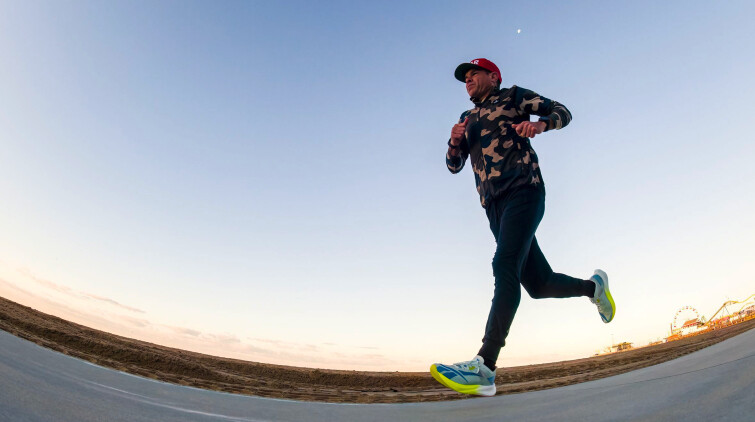
On March 5, he’ll toe the starting line at the Tokyo Marathon in an attempt to once again compete for a podium finish in his age division. He ran 2:29:14 to win his division in Tokyo.
At 5-foot-10, with a muscular physique, Rideout breaks the mold of both typical elite runners and faster recreational runners. It’s his relentlessness to being the best he can be — including and especially his strength training — that sets him apart as an age-group runner and not any inherent talent as an endurance athlete.
“When I am in a race, my mindset gets to the point that I’m gonna run until I collapse,” Rideout says unapologetically about his steadfast approach. “I’m gonna give every ounce of energy until there’s nothing left to give. Win or die trying, that’s the message. If you have that mindset, you can’t lose.”
Growing up in a troubled family in a rough suburb of Boston and taking up boxing at an early age, Rideout has applied a fighter’s mentality and a notorious work ethic to every challenge he’s faced in life, sometimes to his own demise.
As a teen, he took a job as a prison guard where his dad and brother were incarcerated. He worked his way through college, eventually earning a sociology degree from Framingham State University. Although he became a self-made, overachiever as a financial services sales executive, he admitted he suffered from imposter’s syndrome working alongside many Ivy League colleagues and eventually struggled with burn-out, and was diagnosed with substance use disorder tied to his excessive opioid use.
After working through a recovery program, Rideout found a more balanced path in life, channeling his energy into endurance sports, following a mostly vegan diet and the joy he shares with his wife and their four young children.
Rideout first applied his intensity to triathlon and qualified for the Ironman World Championships three times and won the 40-44 age division at Ironman Wisconsin in 2015 with a 9:36:15 effort. But that sport took too much time away from his family, so he turned his focus to marathons in 2019.
So how does someone who started running in his late 30s and didn’t really focus on it until his 40s become fast enough to run 5:45 pace for a marathon after turning 50? Being unabated in his approach every single day.
“I’ve heard some people say I’m lucky to be able to do this at my age, and I’m like, ‘I’m not lucky,’ I work my ass off every day,” he says. “I eat a perfect diet during the week. I work out twice a day. I’m a freaking lunatic with this stuff. I live this full-time.”
Despite his exuberance and intensity, Rideout says he’s grateful that most of his running brings a Zen-like calm to him. He admits he doesn’t want his energy to lead him to a dark place again. When he can, he listens to podcasts or audiobooks while he’s running because he wants to be able to maximize his time to train and learn something at the same time.
“This is just my outlet,” he says. “Running is one of the things that makes me feel good about myself.”
When Rideout turned his focus to running five years ago, his training initially consisted of a 10-mile out-and-back run with 1,200 feet of vertical gain six days a in the Pacific Palisades neighborhood of Los Angeles. The other day of the week he’d typically run 20 miles as hard as possible. While that helped continue to build his aerobic base and led him to a 2:40 effort at the Los Angeles Marathon, it only got him so far.
In 2019, he hired coach Mario Frailoli, who added structure to his training by increasing the length and adding specificity to his long runs, implementing speedier workouts into his routine and also encouraging him to slow down on his easy days that help optimize recovery. He also makes sure that he stays between 70 and 80 miles per week. Since then, he’s run 2:36 or faster six times, including a 2:28:25 personal best at the age of 48 at the 2019 California International Marathon.
In addition to his run training, he works on strength in his home gym four days a week with a circuit that includes pull-ups, squats, bench press and numerous core exercises, as well as boxing drills — including punching a heavy bag. His functional strength and athleticism are among his biggest assets, something that many recreational runners lack, Fraioli says.
Plus, because he’s not burdened by having 35 years of running in his legs, he still has considerable elastic recoil in his legs. (And yes, his carbon-fiber plated Reebok Floatride Energy X shoes also help, Rideout says.)
“He’s doing it right, and honestly, he has been doing it all long,” Fraioli says. “He has more than 10 years of aerobic development under his belt and a lot of that came on a bike and in the pool. And I think the strength training really just helps to keep him in one piece. It’s giving him that structure and that guidance and honestly just keeping him from, you know, completely running himself into the ground.”
Although he still works in the financial world, Rideout has also helped train mixed martial arts fighters and boxers, and is the co-host of the combat sports podcast, “The Fight with Teddy Atlas.” Because of his success and notoriety, he has been all over the media in recent years, including appearances on high-level podcasts with Rich Roll, Joe Rogan, Samantha Nivens, Dr. Andrew Huberman and Fraioli’s “The Morning Shakeout” weekly running show a couple of times.
Rideout has been eager to share his story — and fans and followers seem to appreciate his vulnerability — but insists he’s not special or extraordinary, especially as an athlete.
“Everyone has what I have. I’m an average guy” says Rideout, who played hockey and football in college. “The only thing I do that other people don’t do is I try as hard as I can, I dedicate myself to being the best I can be. And I would say that if there’s one metric that matters above everything — and you don’t need to be a rocket scientist to know this — it’s that consistency is the most important thing. Show up every day.”
(03/05/2023) ⚡AMPby Outside
Love Advice from the Non-Runner Significant Other
Runners love runners, and while runners often date and marry other runners, some runners date non-runners who despise running.
My fiance is the latter. Running isn't for her. It isn't for everyone. A large part of me wishes we could share the miles and time together, and she wishes we could actually spend a Saturday morning together instead of me going on a long run only to come back, eat, and nap.
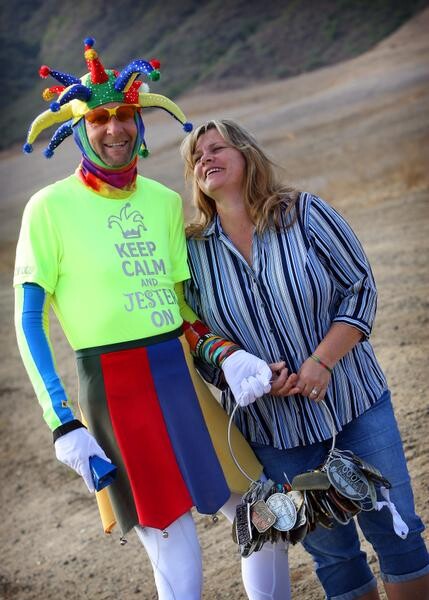
There's give and take in any relationship, but with any passion comes sacrifice. We see the passion on display everyday, but little do we hear about the sacrifice, the unfiltered thoughts of those who might not share the same affinity for run culture.
This Valentine's Day, we give them the mic. To my fiance, and to anyone else in similar situations, I hope you feel seen today.
Forty Years and 200+ Hundred Milers
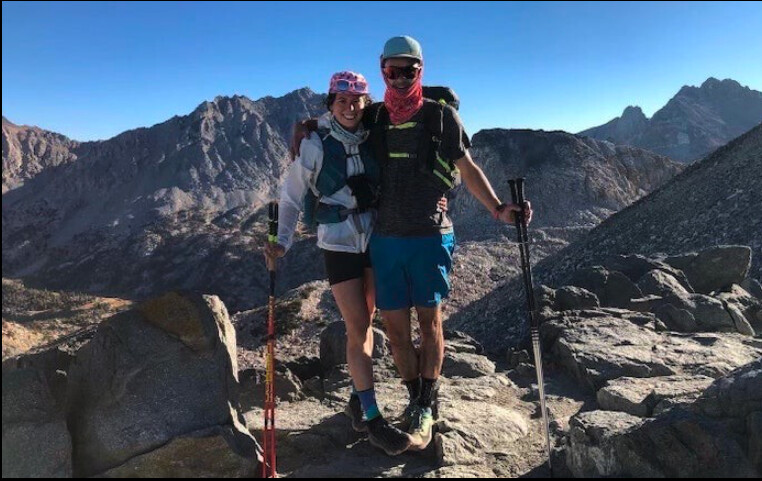
If anyone can understand the grind and sacrifice of supporting an ultrarunner, it's Martha Ettinghausen. Her husband, Ed, 60, has logged more than two hundred 100-plus milers since his first in 2009-one of three people ever to hit that milestone.
For the vast majority of those races, the couple from Murieta, California, has done it all stride for stride. Martha was crew chief, sacrificing weekends, birthdays, and Mother's Days for her runner. It also included nights at home waiting to eat dinner until late hours, delayed romantic evenings on vacation due to Ed being "lost in the moment" of a run, and endless time and money poured into the sport.
"It really has cost us a fortune," Martha said. "There's so much sacrifice, if you want to call it that, that was given up for Ed to pursue his dream. I look at the time and money spent over the years. Sometimes I say, 'This could be our new car,' or, 'This could be an amazing vacation.' Really, it's kind of a selfish hobby, but so is any hobby."
But that's not what Martha takes away from Ed's passion. It has taken years to find balance, and also to recognize that you can be supportive without having to attend every race like she did at first. Now, she goes when she wants to.
"For the first 19 years of marriage, I don't think we spent one night apart," Martha said. "That was a lot of time together. We did everything together, and I like that connection, but in order to find my own life outside of it while he's off doing his thing, I had to learn to do my own thing. He's pursuing his passion; I can pursue mine also."
This has taken various forms: Saturday morning walks with her friends, starting her own business, not waiting to eat meals, even walking 104 miles herself last April at Beyond Limits in California. A big reason she pursued most of these passions was Ed's inspiration.
"One of the biggest things I've learned from Ed doing ultras is going in with a positive mindset and believing you can do it," Martha said. "Never be negative or allow doubt. That carries into every aspect of life. Don't take it so seriously. Watching Ed, I'm like, "You know what? I can do anything.'"
These are lessons learned from 40 years of marriage and 14 years of ultras. While it has its pros and cons and still requires conversations and compromises from both, Martha said the best advice she has for a non-runner significant other is letting each other know what makes the other happy and working toward those goals.
"I would never ask him not to run because that would be like taking his soul away," Martha said. "It's about finding a balance, about what's going to make both people happy. It's sitting down and asking, 'Can we satisfy the runner's desires and passion with the partner's desires and passions?'"
We Don't Talk About Trail Running
When you love something, you want to share it with those you love. Take running. Runners love sharing their goals, training, miles, tales from run group, what the pros are doing, what they read, listened to, or saw about running, *insert endless examples here.*
If you paused at any point during that and sighed, you've likely been on the receiving end of a runner, and Stephen Ettinger, 33, wants you to know something:
"I've gotten the impression that it's a widespread problem among ultrarunners," he said. "Corrine and I have this anecdote that, at some point, I was like, 'You have to find some other people in the trail running community to talk about this stuff. Find an outlet. Talk about trail running with them because I can't listen to you talk about trail running all the time. It's driving me bonkers.'"
He's (mostly) kidding, but he's not wrong. If you put a quarter in a runner's jukebox, that song will play in its entirety. His wife, pro runner Corrine Malcolm, was guilty of it, and she heard that feedback. She's now a podcaster, author, editor-in-chief of FreeTrail, race announcer, Pro Trail Runners Association board member, and various other trail adjacent projects.
Ettinger gets his ultra stories in moderation now, and, with someone who lives and breathes the sport, he knows how important it is for her. It's a lot, but it's a healthy outlet runner's need, especially as Malcolm faced injuries in recent years.
"An injured runner is an unhappy runner," Ettinger said. "It's super frustrating for them, and it's hard to be the partner of someone who's frustrated because you don't want them to be sad and bummed out. How can you not when you can't do the thing you love? Like anyone, they need an outlet."
Ettinger has found his own outlet in recent years. It wasn't something he expected after retiring from professional mountain biking and going to medical school and doing his residency in San Francisco. But when the trails in the city weren't as accessible to bikes as running was, he ran with it.
Before that, the couple split up at trailheads to bike and run. Going together, he says, brought them closer. They understand that Ettinger could spend that time reviewing charts and Malcolm could be going faster to train.
He's not sure why, but he said he might even sign up for an ultra this summer.
"It's not my most favorite thing, but I do enjoy it," Ettinger said. His parting advice: "Never expect 10 toe nails. Expect weird tan lines, and make sure to give your dog a break from running every now and then."
Balancing 'Me Time' and 'Us Time'
Char Ozanic, 46, of Grand Junction, Colorado, is not a fan of running. She recalled bad experiences with the required elementary school mile. When asked if she'd ever run a race again now, she said, "I'm giggling so much it hurts. No."
Ultrarunning found its way into her life through her husband, Matt, 48. They have two boys, and when they moved out, running filled his rediscovered free time as a work destresser.
"By the time the boys left, we had already been in the schedule mode of practices, dinners, and booked weekends so we fell back into that rhythm again quickly," Char said. "But, instead of the boys, it was Matt."
There were mixed feelings initially. Matt had found a passion, but it involved hours they could otherwise spend together or visiting their boys. If this was going to be their life, compromises were a must. Mostly, they had to prioritize scheduling things they wanted or needed around, and not over, those of the other.
"We had a lot of sit-downs," Char said. "You can't get your feelings hurt about every moment you're expecting to get [with your partner] because I also have a life of my own. It's our schedule. It belongs to both of us. You just need to be mindful of each other."
Part of the adjustment was significant amounts of "me time," Char said. Matt usually does two 100 milers a year. This year, one is the Moab 240. Many nights after work and long-run weekends add up fast for Matt.
"You have to genuinely be okay with being by yourself," Char said. "I go see movies by myself all the time, especially movies Matt might hate, or have a spa day. I do a lot of mental health stuff when he's trekking some big miles."
Sometimes it can be tough to find time together, especially in big mileage weeks. Char said that sometimes that means combining "me time" with "us time."
"If I'm craving more us time, I'll go to the trail with him and aid him along the way," she said. "I get my 'me time' and I get time with him. Other times, I like kicking him out the door to read a good book. It's all about balance."
This is also the case for races. Char has only missed one ever for Matt. Travel, she says, is her favorite perk. "It brings us to so many places," Char said. "He'll sign up for a race in, like, Beaver Canyon, Utah. I've never heard of it. Then we go and it's so beautiful. When he's racing, I can go on these small hikes and venture out to do what I want, too. I Google things I can try."
His best advice for anyone dating a distance runner: "Always have snacks around. Easy to grab. Runners can go from wanting a snack to ragingly starving quickly. Trust me. Snacks."
Never Run to Impress
Who hasn't done something to impress a person they're dating? Justin Charboneau, 33, can relate. When he started dating his now-wife, Brittany, 34, in 2016, she was qualifying for the 2020 U.S. Olympic Marathon Trials with sites on going pro.
So, Justin did what any love-struck person would do in that situation: sign up for a half marathon. He completed it, plus some other races and triathlons, too. It wasn't his thing, but he kept up the charade because he thought Brittany wanted him to run.
But in 2022, they hadthe talk.
"I started a cookie company in 2019 and running stopped," he said. "I still do Peloton and cycling now, but I kept running sometimes, and it got to a point where Brit's like, 'Do you like running?' I said no. She was like, 'You don't have to be a runner.' It was a huge weight off my shoulders."
Though he doesn't run anymore, Justin admires the work Brit, and other runners, put in to complete these long distances. He experienced running firsthand, and he wasn't a fan, but what Brittany does inspires him. At the same time, it can be a challenge. Being Denver-based with most friends from the running community, running can dominate the conversation and the attention.
"I've felt a little bit not heard or lonely because Brit does so much," he said. "There were times early on when it felt like Brit was doing all these awesome things and everyone's telling me my wife is so amazing. I got to a point where I'm like, 'What can I do to get some attention?' Eventually, I stepped back and realized that this is us. It's our life. Everything either of us do is for both of us. She inspires me, and it makes me excited to celebrate with her and be her support system."
That same friend group has no judgments since Justin stopped running. He joins them for "Fun Club" after runs and he's heartily welcomed, he said. The only other challenge, Justin says, is working around a runner's schedule. Brit goes to bed early and Justin is a social night owl, so compromising is a must.
"Being social after work fills my bucket. Sometimes, that's completely opposite of what Brit needs during training," Justin said. "It's an interesting thing to navigate because we still want to spend time together, so how can we find those things that fill both our buckets? It's a challenge, but definitely doable."
Finally, his best advice for anyone dating a distance runner: "Always have snacks around. Easy to grab. Runners can go from wanting a snack to ragingly starving quickly. Trust me. Snacks."
Young Love on the Trails
We conclude with our youngest couple: Heidi Strickler, 33, and Hannah Gordon, 38, of Seattle, Washington, an 11-month-old relationship between two passionate outdoor lovers. Strickler is more the runner of the two, competing in ultras and spending days in the mountains. Gordon enjoys a three- to six-mile run here and there, but is more of an outdoor generalist with passions for hiking, biking, and rock climbing.
Together, they find love on and off the trails.
"I view our relationship as three relationships: Heidi with herself, me with myself, and us," Gordon said. "I think we're pretty aligned. We both have interests in certain things and would like to pursue those, and also share them. But that doesn't mean the other person needs to be 100 percent in it."
Each part of that trio requires intentionality and attention, Gordon adds. When she goes on her adventures, or Strickler goes on hers, they both return fulfilled in their passion and, in turn, better versions for their partners.
"I almost wonder if there's an independence level in both parties that works well for people who are partnered, with ultrarunning or some big passion," Gordon said.
At the same time, scheduling becomes intentional, too. Planning their passions is as important as planning to be together. For example, Tuesdays are set aside for just them. Outside of that, they work around friends, work, and being outside, to spend time together. Through communicating ahead of time, they make it work. One thing they haven't experienced yet, Gordon and Strickler said, was a big training block for Strickler.
"I see the potential conflict depending on how many races per year are being trained for if that gets in the way of what we're hoping for intentional time together," Gordon said. "I think I could see that would be something we would just need to talk about. I think it's still solvable."
Additionally, Gordon says that having someone with inner drive to do things like ultras is attractive.
"Watching Heidi, I see such joy and exuberance when she comes back from the mountain," she added. "For me as a partner, I am very thankful that I am with somebody who finds so much joy in the activity that she's born to do. I can see the joy on her face when she comes back and brings in the mud and she's just smiling and beaming that she got to get so dirty and run 30 miles in the cold - which makes no logical sense to me."
(03/05/2023) ⚡AMPby Trail Runner Magazine
You Need to Fuel Strength Training Differently. Here's How to Do It Right.
In the off-season, many runners head to the weight room for a strength-focused training block. Strength training is a different stimulus for the body than the aerobic nature of running, and therefore requires a different kind of fueling. Most people associate weightlifting with protein powders, and for good reason: dietary protein triggers the metabolic adaptation and rebuilding of muscle, a process known as muscle protein synthesis (MPS). But eating for strength is not quite as simple as just eating more protein.
The nutrition strategies for muscle building and strength are complex and interrelated. To get the most out of your work in the weight room, lean into these important factors when planning your strength training and daily diet.

Timing of protein intake
Not only is it critical to meet your daily protein and energy needs, but the timing of protein and carbohydrates is key to optimizing strength gains and recovery.
The window of anabolic opportunity begins in the hour before a strength session and lasts up to 24 hours after resistance training.
Pre-workout
Consume 15-20g protein, 25-50 grams of carbohydrates (carbs), and 16-24oz of water in the hour before resistance training. If an aerobic endurance session follows your resistance training, increase carb intake to kickstart glycogen replenishment.
During a workout
Fueling during a strength session depends on whether you are coming from an endurance session, missed the pre-workout snack, or are going into an endurance workout next. Generally, it is not necessary to fuel during a session unless you need some energy. In that case, a sports drink with carbohydrates is a good idea. Regardless, plan on bringing water and always start your workout well-hydrated.
Post-workout
To enhance muscle repair, accelerate glycogen repletion, and promote favorable changes in body composition, plan for a snack or meal containing both protein and carbohydrate.
In the early recovery phase (0-45 minutes after a workout), consume 15-25 grams of protein along with 25-50 grams of carbs and 20 ounces of fluid per pound of weight lost during the session. It's worth noting that consuming more than 40 grams of protein at once has not been shown to enhance the muscle rebuilding response. Just because the body-building world glamorizes the consumption of protein, more is not necessarily better. If you consume more protein than is needed, the extra protein is either burned for energy, which is not very efficient, or stored as fat, which is likely not desirable.
Your nutritional choices around training are often influenced by convenience and practicality. Unless you are going into a meal, aim for on-the-go food such as Greek yogurt with fruit, peanut butter and honey or jelly sandwich, low-fat cheese, and crackers, chocolate milk, or a protein bar.
Daily Nutrition
Since muscle protein rebuilding is ongoing for at least 24 hours, consuming adequate nutrition to support MPS long after the workout is recommended.
The athlete's size and age are determining factors in how much to consume at one time. Smaller athletes' may need only 15-20g, whereas larger athletes with more muscle mass and higher energy output can easily incorporate up to 30-35g protein at one meal. Older athletes (>55-60 years old) require more protein to achieve the same effect due to the progressive loss of muscle mass associated with the aging process.
To maximize physical adaptation and maintain a robust immune system, the timing and amount of protein/carbohydrate are critical. Here is a general guideline.
Meals
Include protein at each meal (15-35 grams, depending on size and age of athlete).
Snacks
Bridge the gap between meals that are more than four-five hours apart. Include 10-15g of protein in snacks.
Bedtime snack
Dairy protein (made up of whey and casein) is ideal due to casein's slow-releasing nature and the fast-releasing nature of whey. In addition, the whey/casein pairing supports muscle building/repair during the overnight fast.
(03/05/2023) ⚡AMPby Trail Runner Magazine
Are Non-Alcoholic Beverages the Future of Post-Race Recovery?
Imagine your favorite post-run beer, maybe a piney or grapefruity IPA. Or perhaps you prefer wine, in search of that perfect, full-bodied red or crisp chardonnay. For many endurance athletes, imbibing in these post-training drinks is a primary ritual to celebrate their work, to congregate with friends over libations after a hard session.
But while adult beverages can be, in moderation, a healthy and fulfilling part of any endurance athlete's diet, many runners have begun reaching for non-alcoholic (NA) alternatives instead, for several reasons. Though they still only make up a small percentage of the market, NA beverages are more widely available, and delicious, than ever. And that's not slowing down. According to a recent market analysis, the growth of NA beer is expected to go up by 6 percent in the next decade.

So, why the transition? Are there specific benefits to overall wellness and recovery, specifically for runners? Let's break down the nutrition, health, and performance implications of alcohol, and look at ways that non-alcoholic options might offer an alternative.
Immune System
During exercise, the body undergoes training stress which increases inflammation and risk of infection. Add in alcohol and it could spell a recipe for more cold and flu incidences. In a 2012 study on a group of runners in Medicine and Science in Sport and Exercise, non-alcoholic beer consumption regularly, pre- and post-marathon, resulted in a reduction in inflammation and reduced incident of upper respiratory infections. Polyphenols, antioxidants also found in beer and wine, were attributed to the effects and suggest that non-alcoholic beverages could offer more than just a solid rehydration option for endurance athletes. Opting for an NA option might just strengthen the immune system and save runners from missing out on consistent training due to sickness.
Glycogen Synthesis
In order to have carbohydrates available to the body for energy production when needed, the body stores some in the muscles and liver, in the form of glycogen. Faster glycogen replenishment rates are beneficial for endurance runners wanting to reduce muscle soreness and improve the ability to get back out there and train the next day. While more research is needed, current studies indicate that glycogen replenishment rates may be impaired by post-exercise alcohol consumption. While both alcoholic and non-alcoholic beverages provide post-workout carbs, grabbing an NA beverage could allow runners to take full advantage of filling up those post-workout glycogen stores.
Muscle Recovery
Trying to optimize post-exercise muscle protein synthesis rates (or rate of muscle repair and rebuilding) can offer benefits to the trail runner who wants to try to avoid injury and build strength to handle off-road training stressors. Alcohol can inhibit protein synthetic pathways, which has been demonstrated in strength athletes post-lifting. Instead, athletes can combine an NA beverage with a post-run protein shake for an optimal post-workout recovery option. This, along with studies on how alcohol affects heart rate variability and sleep quality, provide a strong case to incorporate non-alcoholic alternatives into any endurance recovery program.
Here Are Some Favorite Non-Alcoholic Beverage Options:
Gruvi Wine and Beer
This Colorado-based NA beer and wine company has a mission of giving an option for those who don't want to miss out on social events, but also want to make choices to benefit health, wellbeing, and adventures. To brew their beer, they use a process called "arrested fermentation," which stops the fermentation process before alcohol is produced. The wines use a vacuum distillation process to remove alcohol from their carefully chosen grape products.
Best Day Brewing
Born in Northern California, this brewer believes in "celebrating the now," a nod to celebrating life's positive moments. They've got three tasty options, including two IPAs and a Kolsch to satisfy your palate.
Athletic Brewing
This is one of the original NA craft brew options. Athletic Brewing was born in 2017 out of a love for athletic activity and great suds. Founded by partners Bill Schufelt and John Walker, Athletic Brewing now has NA brewing facilities on both the east coast and the west coast. With over ten varieties of beer and many Special Edition brews, Athletic Brewing is at the top of the game in the NA beer world.
Parch Cocktails
If you are looking for an alternative to NA beer, look no further than Parch. The company developed their NA cocktails with Southwestern and Mexican cultures in mind. Full of flavor, the beverages include a whole host of adaptogenic herbs (stress-balancing) including ashwagandha, l-theanine, and ginseng, that will satisfy any post-adventure celebration.
Partake Brewing
With a whole host of beer options (including fruit varieties), award-winning Partake was started by Ted Fleming, who was diagnosed with Crohn's Disease but didn't want to give up drinking as a social event. As a result, Partake was born. With options from a Red Ale to a Peach Gose, you will find anything to quench your thirst.
(Author's note: This article is not meant to shame anyone and their choices, but rather provide guidance on the benefits of choosing non-alcoholic beverages post-exercise.)
(03/05/2023) ⚡AMPWanjiru and Gelmisa triumph in Tokyo Marathon
Rosemary Wanjiru surged to No.6 on the women’s world marathon all-time list, while Deso Gelmisa prevailed in a men’s race sprint finish at the Tokyo Marathon, a World Athletics Platinum Label road race, on Sunday (5).
Kenya’s Wanjiru ran 2:16:28 for the seventh-fastest women’s marathon performance in history, winning by 28 seconds ahead of Ethiopia’s Tsehay Gemechu who also dipped under 2:17, herself becoming just the eighth woman to ever achieve the feat. Gelmisa, meanwhile, held off a strong challenge from his compatriots Mohamed Esa and Tsegaye Getachew to lead an Ethiopian top three in 2:05:22.
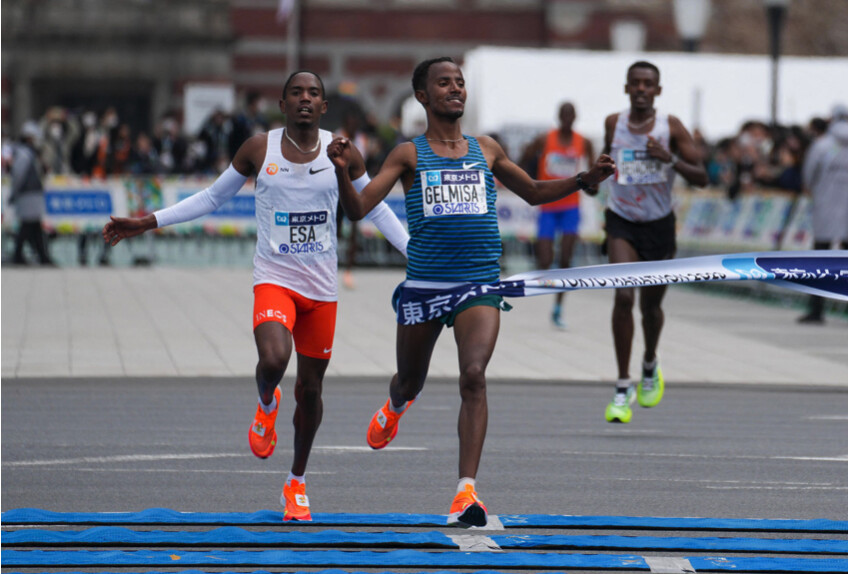
Contesting the second marathon of her career after a 2:18:00 debut for the runner-up spot in Berlin last year, long-time Japan based Wanjiru was always among the leaders.
A seven-strong pack went through 5km in 16:19, Wanjiru running with last year’s runner-up Ashete Bekere and her Ethiopian compatriots Tigist Abayechew, Worknesh Edesa and Gemechu, as well as Japan’s Mizuki Matsuda, through 10km in in 32:34.
Japan’s woman-only national record-holder Mao Ichiyama, who ran 2:20:29 in Nagoya in 2020, had explained at the pre-event press conference that she fractured a rib in December and she dropped back by 10km, running 23 seconds behind the leaders.
Matsuda was the next to lose touch but was still on Japanese record pace as the speed picked up again, a sub-16:00 5km split taking the leaders to 15km in 48:32.
The women’s race was down to four by 20km, the tempo having eased slightly as Wanjiru, Edesa, Bekere and Gemechu reached that point in 1:04:44. Matsuda was just over a minute behind them, clocking 1:05:52.
The leading quartet remained together behind the two pacemakers through 25km in 1:21:07, but a few kilometres later that group of four, led by Wanjiru, decided to leave the pacers behind.
The tempo had slipped to 2:17 pace at 30km, reached in 1:37:25, but Wanjiru and Gemechu forged ahead over the next couple of kilometres.
Wanjiru was running solo by 39km but upped her pace to a projected 2:16:20 finish at the 40km mark, passed in 2:09:14, and she had a 19-second lead over Gemechu.
Wanjiru continued to glance over her shoulder during the closing kilometre but she had nothing to worry about and she crossed the finish line well clear, evidently elated with her victory and big 2:16:28 PB.Gemechu also broke 2:17, finishing 28 seconds back in 2:16:56, while Bekere was third in 2:19:11 and Edesa fourth in 2:20.13.
The 2016 Olympic 10,000m fifth-place finisher Betsy Saina, racing her first marathon as a US citizen and as a mother, worked her way through the field to finish fifth in a PB of 2:21:40, while Matsuda was sixth in 2:21:44 and the top 11 all dipped under 2:30. One week after finishing fourth in the Osaka Marathon in 2:23:15, Australia's Lisa Weightman clocked 2:31:42.In the men’s race, a huge group featuring all of the favourites was led through 5km in 14:45. The field started to break up as the pace picked up slightly, 10km reached in 29:21 and 15km in 44:03, but 30 runners remained together, the group spread by five seconds, as 20km was hit in 58:54.
Those 30 athletes remained on 2:04 pace through half way.
The tempo maintained through 25km in 1:13:45 and 30km in 1:28:39, with athletes at the back of the pack unable to stick with it.
Japan’s Ichitaka Yamashita moved to the fore around 33km into the race and by 35km, reached in 1:43:47, the lead group was down to 12.
A group of six – Kenya’s Titus Kipruto and Canada’s Cameron Levins, plus Ethiopia’s Gelmisa, Getachew, Deme Tadu Abate and Esa – broke away by the final turnaround point at around 37km and Levins hit the front a short while later. He took the leaders through 40km in 1:58:54 but was unable to hold on as Gelmisa, Esa, Getachew and Kipruto started their surge for home.
Gelmisa, Esa and Getachew kicked again and in a three-way sprint to the finish it was last year's Paris Marathon winner Gelmisa who had the strongest finish.
Leaving himself just enough opportunity to celebrate on his approach to the tape, he won in 2:05:22, narrowly pipping Esa, who recorded the same time.
Getachew was three seconds back to complete an Ethiopian top three, while Kipruto finished fourth in 2:05:32.
In fifth, Levins took two seconds off the North American record, clocking 2:05:36 to improve a mark set by Khalid Khannouchi in London in 2002. Levins’ previous best had been the Canadian record of 2:07:09 he set when finishing fourth in last year’s World Championships marathon in Oregon.
Abate finished sixth in 2:05:38, while Yamashita was the leading Japanese finisher in a PB of 2:05:51 for seventh place as Japan’s Kenya Sonota also dipped under 2:06 and a total of 20 athletes went sub-2:10.
(03/05/2023) ⚡AMPTokyo Marathon
The Tokyo Marathon is a world-renowned annual marathon held in Tokyo, Japan. As one of the prestigious Abbott World Marathon Majors, it attracts elite and amateur runners from around the globe. The race holds World Athletics Platinum Label status, recognizing its high competitive standards, top-tier organization, and international appeal. Sponsored by Tokyo Metro, the Tokyo Marathon has grown into one...
more...Cam Levins becomes the first Canadian runner to break 2:06, running to a fifth-place finish in Tokyo
On Sunday morning in Tokyo, Cam Levins of Campbell River, B.C., solidified himself as the fastest marathoner in North American history at the 2023 Tokyo Marathon, placing fifth in 2:05:36 to shatter his previous Canadian record of 2:07:09 and breaking the long-standing North American record of 2:05:38.
The 33-year-old marathoner has put Canadian distance running on the map, once again, nearly winning the Tokyo Marathon. Levins ran the perfect race, staying patient early on and making all the right moves to contend for the victory.

With one kilometre to go, Levins was in a group of five runners vying for the win, but Ethiopia’s Deso Gelmisa sprinted away with 400m left, winning the 2023 Tokyo Marathon.
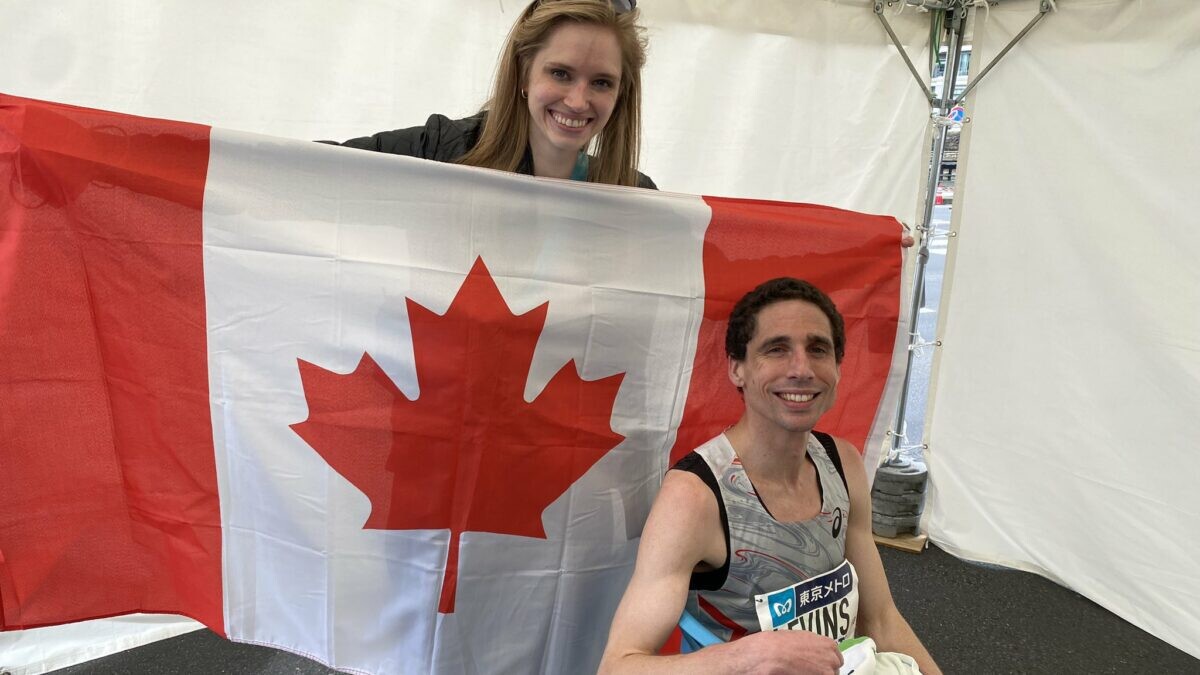
It was an Ethiopian sweep of the podium in Tokyo, with Gelmisa taking the win in his first Abbott World Marathon Major, in 2:05:22. His compatriot, Mohamed Esa, finished one second back for second, and Tsegaye Getachew was third (2:05:25).
Levins said, going into the race, that he was shooting for a time of 2:05 after his spectacular half-marathon record run of 60:18 in early February.
His time of 2:05:36 (pending ratification), breaks U.S. marathoner Khalid Khannouchi’s North American record of 2:05:38 from the 2002 Tokyo Marathon. American Ryan Hall is the only athlete to run faster than Levins, 2:04:58 at the 2011 Boston Marathon (though Boston is considered non-record-eligible by World Athletics since it is a net downhill, point-to-point course).
Cam Levins now has four of the six fastest Canadian marathon times in history.
In potentially her last major marathon, Canada’sKrista DuChene ran her fastest time in four years, clocking 2:38:53 for 19th overall. The last time DuChene, 46, broke the 2:40 mark was at the 2019 Berlin Marathon, where she ran 2:32:27.
(03/04/2023) ⚡AMPby Running Magazine
Tokyo Marathon
The Tokyo Marathon is a world-renowned annual marathon held in Tokyo, Japan. As one of the prestigious Abbott World Marathon Majors, it attracts elite and amateur runners from around the globe. The race holds World Athletics Platinum Label status, recognizing its high competitive standards, top-tier organization, and international appeal. Sponsored by Tokyo Metro, the Tokyo Marathon has grown into one...
more...Koech, Wanjiru spearhead Team Kenya in Sunday's Tokyo race
Bernard Koech will lead a strong Kenyan contingent for the Tokyo Marathon this Sunday.
Koech, who has a personal best of 2:04:09 set at the Amsterdam Marathon in 2021, where he finished second.
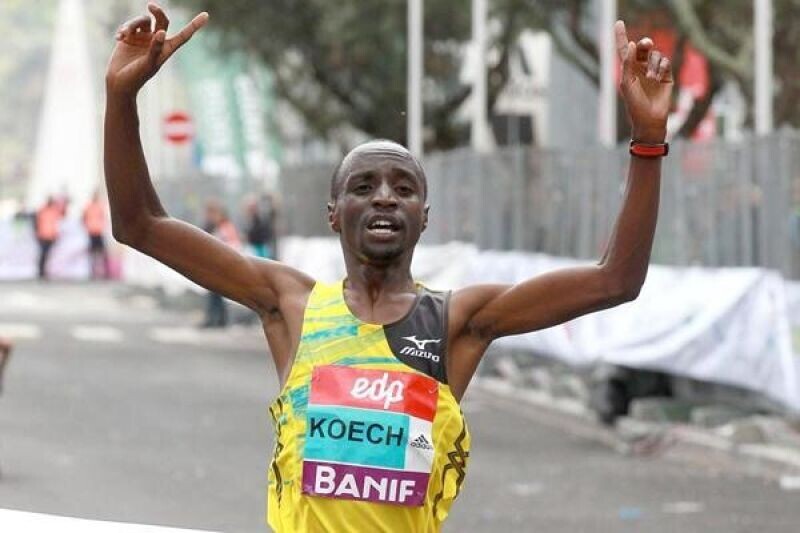
Kenya's Mike Kipruto Boit, Brimin Misoi and Vincent Raimoi are also contenders for the title.
The Kenyan quarter will, however, face a stern test from 2021 London Marathon champion Sisay Lemma of Ethiopia.
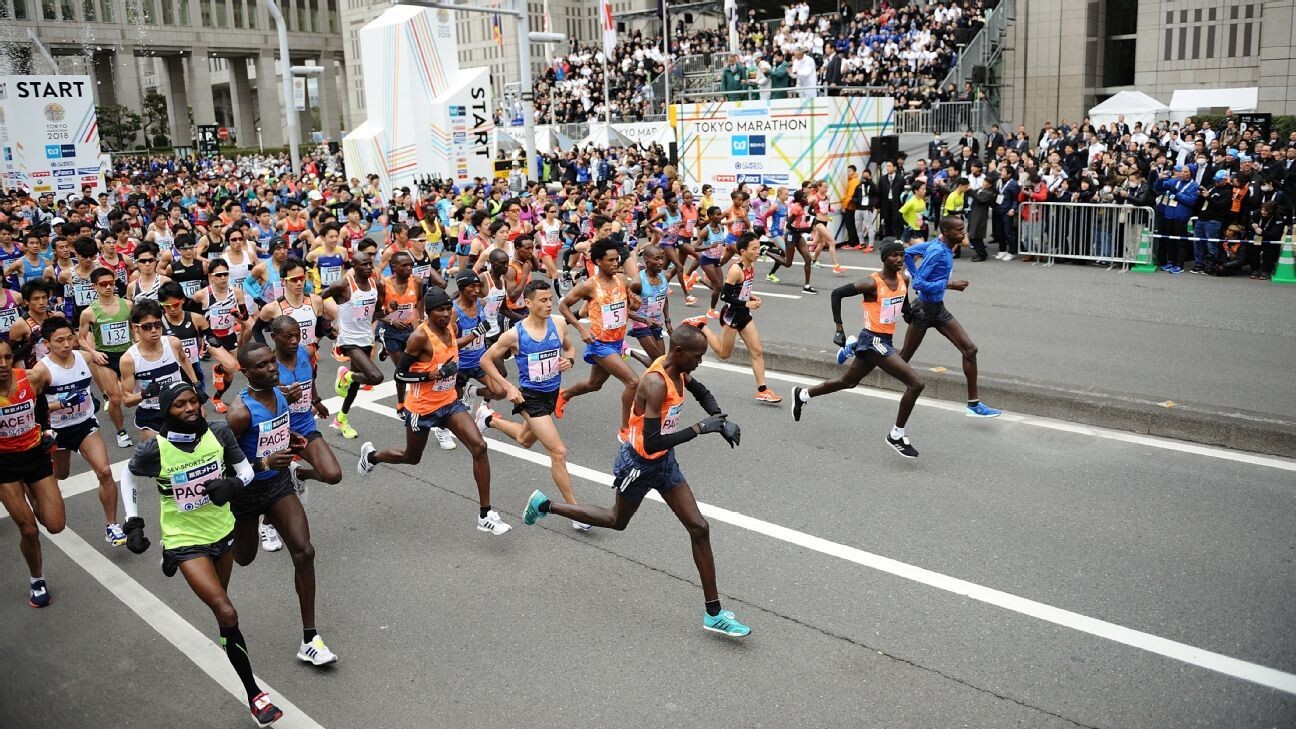
Lemma won the London Marathon in 2:04:01 and will have compatriots Tsegaye Getachew, Mohamed Esa, and Deme Tadu Abate for the company as he seeks to add another feather to his hat.
Getachew has a personal best of 2:04:49 posted while winning the Amsterdam Marathon last year while Esa's PB is 2:05:05 recorded while placing fifth in Amsterdam in 2022. Abate's PB of 2:06:28 was achieved in Berlin, where he placed third last year.
Japan had entered the last three national record holders, Kengo Suzuki, Suguru Osako and Yuta Shitara but the withdrawal of Suzuki last month leaves two to battle for the honours.
Osako is the fastest Japanese man in the field with a 2:05:29 set in Tokyo three years ago.
Hidekazu Hijikata, Kyohei Hosoya, Ryu Takaku and Hiroto Inoue have all run 2:06 and another nine Japanese men on the list have run 2:07.
At the pre-race press conference, Japan's most consistent marathoner over the last few years, Hosoya said he is in great shape and will be going for the Japanese NR and at a minimum the top Japanese spot.
In the women's category, Rosemary Wanjiru will spearhead Kenya's quest for glory in the Japanese capital.
Wanjiru has a personal best of 2:18:00 posted when she finished second in the Berlin Marathon last year.
She will have fellow Kenyan and 2022 Toronto Marathon champion Antonina Kwambai for the company. Another Kenyan Betsy Saina will be among the athletes to watch. Saina is back from maternity leave and ran a promising 1:08:25 for the win at the Seville Half Marathon earlier this year.
Ashete Bekere of Ethiopia is the race favourite with a personal best time of 2:17:58 when finishing second at the event in 2021.
Others to look out for the title include compatriots Tigist Abaychew and Worknesh Edesa.
(03/04/2023) ⚡AMPby William Njuguna
Tokyo Marathon
The Tokyo Marathon is a world-renowned annual marathon held in Tokyo, Japan. As one of the prestigious Abbott World Marathon Majors, it attracts elite and amateur runners from around the globe. The race holds World Athletics Platinum Label status, recognizing its high competitive standards, top-tier organization, and international appeal. Sponsored by Tokyo Metro, the Tokyo Marathon has grown into one...
more...Two easy ways for beginners to add speed, these simple speedwork sessions introduce faster running in small doses
Speedwork can sound intimidating, and new runners often avoid it until they’ve been logging regular miles for years. Even if you’re fairly new to running, speedwork is an essential addition to your weekly mileage–and it doesn’t mean you’ll be sprinting around a track until exhaustion. You can do your speedwork on the road, trails, track, or even the treadmill.
If you’ve been running for about six months and are injury-free, it’s safe to start incorporating short speed sessions into your training. Try these two simple workouts to get your legs used to moving quickly. As you get more comfortable, you can add repeats or lengthen intervals.

Strides
Strides are a great way to begin adding speed to your sessions. Tack them on to the end of any easy run. Strides are like the multi-purpose tool of speedwork–runners training for very long distances will add them to training runs to remind their legs what it feels like to go at top speed. If you’ve never tried strides before, don’t worry: it’s hard to go wrong.
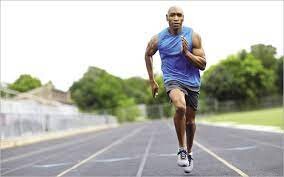
Start your strides running by going easy, focusing on a short, quick stride, and then gradually increase your speed by lengthening your stride. Focus on staying relaxed and running smoothly. It should feel like a controlled faster pace, not a sprint.
The workout:
Easy run (approx 30 minutes)
Four to five strides of 15 to 30 seconds each, 45 seconds rest in between.
Short intervals
If this workout looks too daunting, simply shorten your intervals so that they seem manageable–30 seconds fast with a one-minute recovery is just fine. If you need to walk to recover, go for it. Don’t worry about your pace throughout the intervals, simply go by effort.
The workout:
Warm up with 10 minutes easy running
Five to eight repeats of one minute hard followed by two minutes easy running or walking to recover
Cool down with five to 10 minutes easy running
Recovery is a key component of speedwork, whether you are a beginner or an experienced runner. In these beginner speed workouts, the recovery intervals are longer in duration than the hard intervals. As you build strength, you can cut down recovery time to make the workouts more challenging. Speed workouts are considered hard training days so you will need a very easy recovery running or rest day following one.
(03/04/2023) ⚡AMPby Keeley Milne
Running your first race? Tips to make the most of the experience
Running a race can be an intimidating experience. There are the logistics: where it starts; where it ends, the timing, the course, etc. There are plenty of people including runners, volunteers and spectators to contend with. There are rules to consider, both official and unwritten. Not to mention that you have to do something that is physically and mentally really hard.
Especially for beginners, running a race can make one feel anxious, nervous and possibly even afraid. Pre-race nerves are experienced by almost every runner so know you are not alone. There is also tremendous value in acknowledging those nerves and reframing them as excitement and anticipation for what you are about to do.

Here we present some of the most common concerns runners–both new and experienced–report from their race experiences and offer a number of solutions and strategies to overcome them in order to make the most of your running and racing:
Before the race…
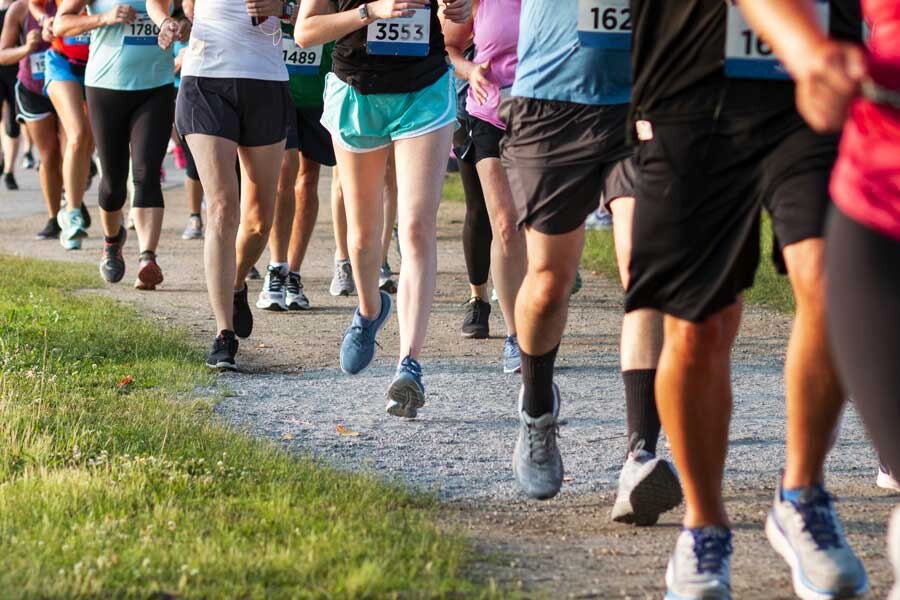
Getting a good night’s sleep the night before a race is useful but not essential. Rather, aim to get as much quality sleep as you can the entire week before your race.
Set an alarm and get up early so you don’t feel rushed on race morning.
Have your running stuff–gear, apparel, shoes, accessories–all laid out and ready to go. This includes pinning your bib to your shirt, singlet or jacket.
Follow a pre-run/race routine that you’ve used before and that works for you. Eat the same foods for breakfast. Wear gear you’ve tested before. Do the same stretches or warm-up. The best advice you can possibly take: Nothing new on race day!
Know exactly where you’re going and how you’ll get there as well as where you’ll park. Also, have an exit strategy in mind.
Once you arrive…
Aim to arrive early so you don’t feel rushed. This will also allow you to get a sense of the start (and finish) area before it gets busy. Become familiar with key locations such as the start and finish line, the registration/bib pick-up, bag check, the washrooms (usually porta-potties), first aid and medical services, etc.
Know the schedule and create a timeline. When does the race start and how long will it take you to line up/get into your corral? Working backward, give yourself enough time to use the washroom (there are always lines), check your bag, warm-up properly and anything else you know you need to do.
If you’re not a fan of large crowds or feeling overwhelmed, remove yourself from the scene until you absolutely have too. Remain at your car, find a quiet coffee shop nearby or warm-up/stretch on a side street.
Consider using earphones before the race to listen to music, the radio, a podcast, whatever you prefer. This will help distract you from the commotion of the crowds.
Once you join the rest of the runners, try to focus on yourself, on how you’re feeling and use a variety of calming and meditative exercises to think about your upcoming run.
Line up according to ability. The faster you are, the closer you should be to the start line. In larger races with hundreds of participants, events often use corrals to separate runners based on their expected finish times. If you don’t know where you should be, look for pace bunnies or ask a fellow runner for guidance. For the safety of others, be sure to line up appropriately as not to obstruct faster runners.
Running your best race…
Hopefully you have some idea of how you plan to run your race. How long it will take; what pace you’ll run at; if/how often you’ll hydrate and/or consume fuel. Having a race plan is always a good idea and better still, have a backup plan in the event that weather/conditions are not ideal.
Most races have aid stations with water, electrolyte/energy drinks and possibly even fuel (bars or gels) along the course. Depending on the length of the race or whether you carry your own, plan to use these to stay hydrated and fuelled.
As mentioned, have a plan regarding how fast you plan to run. Know your desired pace and do your best to stick to it. Avoid going out too fast at the start–THE most common mistake made by ALL runners in a race–and if anything, aim to start slower than you need to and plan to pick up the pace as the race goes on.
At/after the finish–Congratulations!
Once you cross the line, it’s important you keep moving forward to avoid obstructing those behind you.
Take a few minutes to collect yourself, catch your breath and try to take a moment to truly appreciate the moment.
You’ll likely be handed a finishers medal and ushered toward some refreshments. Try to drink and eat something to kick-start the recovery process.
If you’re not feeling well, seek out a race official or volunteer who can help you get some medical attention. Some races also offer post-race massage.
Once you’re starting to feel yourself again, proceed to pick up your bag, meet your friends and family and enjoy the entertainment or post-race festivities.
(03/04/2023) ⚡AMPby Dan Way
Mission-Forward Running Brands Janji and Oiselle Announce New Partnership
Janji and Oiselle, two mission-driven brands in the running space, have announced they are merging in a "partnership of equals."
There are some brands that stand out as pioneers in the running industry, and both Janji and Oiselle stand tall. Janji's story has always prioritized a sustainability message and tapped into artists from underrepresented communities from its inception. Likewise, Oiselle entered center stage with its sights set on providing female athletes apparel that not only met their performance and style needs but was a statement for building strong female voices in running and beyond.

With this new partnership, the two brands will continue to operate as sole entities-Oiselle in Seattle and Janji in Boston-but the magic will be in leveraging their combined power to build bigger running communities and reach more runners with a larger distribution network.
"By coming together, both brands can grow their communities, lean in on their strengths, and continue their unique mission: to support runners and make the world a better place through running," said Janji co-founder, Dave Spandorfer. "This merger allows us to think incredibly long-term and support our communities, the Volee and the Collective, even more."
Oiselle founder Sally Bergesen will be stepping down into an advisory role and long-time Oiselle president Atsuko Tamura will continue to lead the brand and strengthen partnerships with elite athletes.
"Runners truly understand the value of community and connection, that hard efforts are best done as a group! I'm thrilled to be joining forces with our friends at Janji, who share our passion for the sport and its people," said Bergesen. "I'm equally happy that Oiselle will remain a women-led company, something that has defined us since day one, and will continue to be who we are and what we stand for well into the future."
Janji's co-founders, Mike Burnstein and Dave Spandorfer, who will stay in their roles, built Janji with a focus on community and giving back. The company works with local artists around the globe for each collection and gives 2 percent of sales back to water projects in those communities.
Together, both of these brands are a powerful combination to foster their distinct running communities - Oiselle's Volee is a global community of thousands of women with diverse backgrounds and different goals, connected by the common thread of running, and Janji Collective is a community of like-minded runners and adventurers who are encouraged to explore, connect, and give back through running.
Athlete Lauren Fleshman, who has been a key part of the Oiselle team since its early days said, "The work of these two mission-driven companies is so important, and in many ways, it's only just begun. The bird of humanity flies best with two strong wings, and this partnership combines us in a way that makes soaring inevitable."
(03/04/2023) ⚡AMPby Trail Runner Magazine
Should Endurance Athletes be Donating Blood?
Blood donation remains one of the most selfless and altruistic things that a person can do. Despite the myriad advances by drug companies over the years, no drugs have ever been developed that come close to accomplishing what our own blood can do. Consequently, we remain dependent on the generosity of donors who take a half-hour or so to give up a pint of this incredibly valuable, lifesaving fluid.
But that dependence makes the availability of this valuable resource very precarious. In January of 2022, in response to plummeting donations in the face of surging COVID infections as a result of the Omicron surge, the Red Cross issued its first-ever "Blood Crisis" in which the organization desperately appealed for donors to help shore up critically low supplies. Fortunately, the crisis was short-lived as donors responded and blood banks were able to achieve low but sustainable levels in short order.
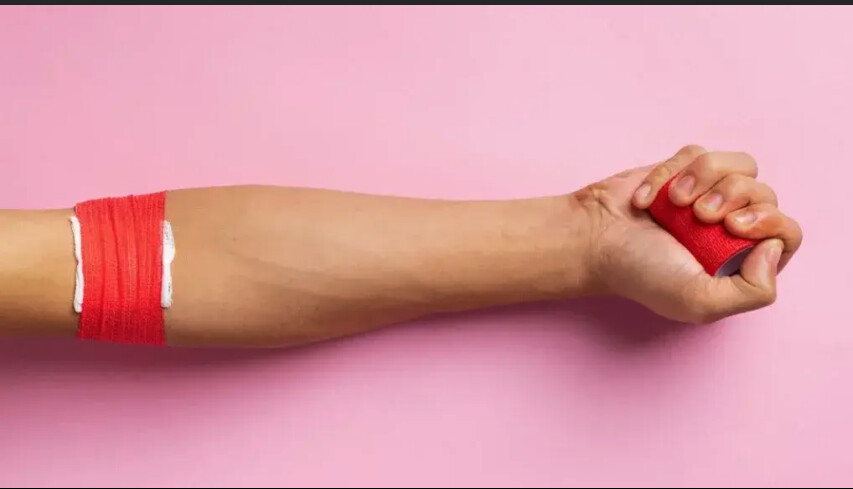
However, the supply of blood is continuously under threat. Even today, multiple blood banks across the country are reporting shortages, from New Jersey to Kentucky and California. Because blood has a limited shelf life and the demand is unpredictable, any change in the number of donors can dramatically impact supply. At any given time in the United States, as many as one in five medical centers are operating with a one-day supply of blood products, putting patients at significant risk.
So why is blood such an important resource for medical care? Blood is made up of several components and serves many purposes. After donation, whole blood is separated into its component parts so that each can be used for recipients who have specific needs.
Blood donation, explained
Red blood cells containing the oxygen carrying molecule hemoglobin are separated and made into a unit of PRBC-packed red blood cells, so that they can be reconstituted with saline and infused into patients with anemia for any number of reasons. Trauma victims, cancer patients, and patients undergoing major operations are just some examples of the people who benefit from PRBC. Platelets are important for blood clotting and various conditions can drop patient platelet counts dangerously low in which case bleeding can become an issue. Platelet transfusions may be life saving for them. Finally, the protein-rich plasma has many possible roles and can be given to patients with various types of ailments including autoimmune processes like Guillain Barre syndrome or Myasthenia Gravis or more recently, for patients with severe COVID-19-related illness.
Each year, 45 million units of blood are donated at blood banks throughout the western world, according to the American Red Cross. However, these donations are made by 4% only of the population. There are myriad reasons for why more people don't give blood, from fear of needles, to a lack of knowledge of the need and benefits of donating and for some, a perception that donating blood can have detrimental effects such as exposing the donor to the risk of infection (it does not).
But for endurance athletes training for a race, a common concern is how donating blood will affect their ability to train and race. When is is safe to exercise after giving blood and what should you expect as far as your performance?
How does donating blood affect athletic performance?
Endurance athletes have long known that receiving blood transfusions may enhance exercise performance by increasing hemoglobin concentration and allowing for improved oxygen delivery to the cells. So the logic stands that many athletes wonder if donating blood can have the opposite effect: Can lowering hemoglobin concentration by donating blood negatively impact exercise performance? Fortunately, there is a reasonable body of evidence on the subject that can help athletes make an educated decision on this important question.
After a typical blood donation, hemoglobin levels do indeed predictably decrease by an average of 7 percent and remain depressed for at least 14 days after donation. By then, they have recovered by about half, to a 4 percent decrease from pre-donation levels, according to a 2017 study in Transfusion. Hematocrit, or the measure of what percentage of blood volume is made up of red blood cells, also decreases for the first few days after a donation. Hematocrit also decreases by 5 percent 48 hours after donation, recovers within two weeks after the donation. This is because the new cells that have been synthesized in that two-week period contain less hemoglobin than more mature cells. As a result, the hematocrit recovers more quickly than the hemoglobin concentration.
Because hemoglobin is needed for carrying oxygen to tissues in the body, the decrease in hemoglobin seen with blood donation is associated with a decrease in oxygen-carrying capacity and delivery, accounting for a measurable 7 percent decrease in VO2 max in the 24-48 hours after donation. Interestingly, this decrease completely disappears by day three, suggesting that blood volume has re-expanded by that point and increases in heart rate likely compensate for the decreased hemoglobin to restore oxygen delivery to normal. Because VO2 max is a measure of oxygen utilization by peripheral tissues, if oxygen delivery is restored to near-normal levels by the third day after a donation, then it makes sense that VO2 max would recover, as cellular metabolism is unaffected by hemoglobin levels alone.
Along with the decrease in VO2 max, measured maximal exercise capacity as well as time to exhaustion when performing at threshold also decreases by about 10 percent after a blood donation, then fully recovers by one week. Submaximal efforts have never effectively been studied, so no clear conclusions can be made about efforts in that range after blood donation.
Taken together, these findings suggest that blood donation is indeed associated with a measurable decrease in exercise performance, principally at the highest levels of exertion. This effect is maximal for the first two days after a donation, and has disappeared by fourteen days after donation.
When can I exercise after donating blood?
Clearly, blood donation is compatible with endurance training. Athletes need only to incorporate such donations into their schedule so that they do not have high-intensity training for several days to a week after a donation, and certainly should not donate within two weeks of a race.
The satisfaction gained from the knowledge of having helped others in this way should be more than sufficient motivation to arrange one's schedule to make this possible. Please donate and do your part to help save a life.
(03/04/2023) ⚡AMPby Trail Runner Magazine
The 90-Year-Old Man Who Still Crushes 100 Milers
Don Jans clipped the curb with his car as he pulled into a rest stop in Texas. It was a minor incident that likely stemmed from the exhaustion of a solo, 2,000-mile drive home to Florida, after completing 127 miles at January's Across the Years in Phoenix.
Inspecting the damage, the 90-year-old Florida man was relieved to see none. So, he hopped in his sleeping bag for a few hours before waking up around 3 A.M. to get back on the road. A few miles later, the car rebelled.
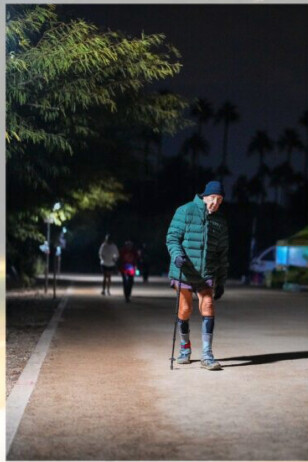
"The temperature gauge was at the max, so I pulled off the interstate and shut it down," Jans said. "Around three or four in the morning, I get towed to a mechanic in Ozana, Texas, which is in the middle of nowhere. When I got there, I climbed back in my sleeping bag and the mechanics arrived around 7 A.M. and found me there. Unfortunately, they didn't do radiators."
Jans received another tow to another mechanic in town and was back on the road the next day after sleeping in that mechanic's lot that night. He would make it home a day or so later.
In a way, it's a fitting description of Jans as runner and person. At 90 years old, Jans finds ways and reasons to keep moving in his 10th decade on Earth, and his fifth running.
If he can do it, he'll do it. It might take a little longer than it used to, or, using one of Jans's many sayings and mottos, "Don't be getting in a hurry."
"I have no explanation for why I should keep running, but I highly recommend it to everybody," he said. "It's just great to be out there on the course, in the fresh air, and the training isn't a burden. I mean, if it's something you like to do, it's not punishment. If it's punishment, you need to find something you like. That's what we're here for right? To have fun."
A Wife, a Man, and a Van
Endurance goals have been top of mind for Jans since 1980. Then 48, he started running to lose weight. Realizing he enjoyed the challenge, he became a triathlete. One race turned into another, and he eventually qualified for and ran Kona in 1987.
The same happened when he transitioned to trails in the 1990s. He found new challenges and a community in running.
"The people in the ultra and running community are such a wonderful bunch to be around," Jans said. "Everybody helps everybody. They're just the salt of the earth. I said to myself that this was the place to be."
With the help of his wife Dorothy, they packed into the family van and found races to run and volunteer at all over the country. Though never a runner herself, Dorothy became the "ultimate crew chief" for Jans. She took extensive notes, took pictures of what Jans wore so he had a reference for future races, and stocked the van like a mini aid station on wheels for other runners in need.
"She was a super mom," said Sharon Jans, 67, Jans's daughter. "I have three brothers and three sisters, and caretaking people out was kind of her life. She just extended that to runners. She helped a lot of people here and there at so many races. Whatever they needed, she had it somewhere in that van. She loved it. It kept her busy."
While they mostly stuck to the Southeast near their Clearwater, Florida home, Jans racked up multiple ultra finishes a year after 1990, including the Umstead 100 (eight times), JFK 50 (also eight times), and Ancient Oaks 100, to name a few. He was in his 60s and 70s for the majority of these.
Then, it all came to a halt in 2009.
They first noticed it at a race. Jans came into an aid station and found Dorothy asleep in the van. She had never missed him or been asleep at any aid station before.
Soon after, Dorothy was diagnosed with lymphoma. When that seemed to be cured, another diagnosis followed.
"We went through a battle for five to six years," Jans said. "You lose track of time, and I'm not blaming the medical people. Once you think you're over one hurdle, there's another one. There's a continual series of disappointments, if you want to call it that. You just do it. We had been married for 60-some years, and for these next years, I was a full-time caregiver. Nothing else. You just do it."
When Dorothy passed away in October 2015, Jans didn't know what to do. He hadn't run in years while tending to his wife and best friend. He had a hip replacement and had done some swimming and walking, but nothing near what he used to. He wasn't sure if he'd ever run like he did.
A Comeback Story
Looking for something to occupy his mind and time, one conversation led to rediscovering his goals through discovering a new race.
Depending on who you ask in the family, you'll get a different story. Jans goes with his version in which one of his daughters, Marilyn Jans Schupbach, 69, alerted him to the existence of A Race for the Ages (ARFTA). The Tennessee-based race is essentially a timed, multi-day race but with a couple twists. Everyone 40 and younger gets to run the final 40 hours of the race. Anyone 41 and older is allotted a number of hours equal to their age. In 2018, that meant Jans, who was 85, got 85 hours to run.
"I was just trying to recoup mentally from losing my wife, so it was a distraction, get your mind onto something worthwhile," Jans said. "Marilyn told me, 'Why don't you try this and see how it goes?'"
Intrigued by the concept, Jans signed up, training around the roads in his new home in The Villages, Florida. He was also motivated by having someone to race with: Marilyn.
Jans had inspired her and Sharon to get into ultras in the 1990s, and Marilyn wanted to see if she could catch her dad. I signed up with him," Marilyn said. "That was my first and last time. I'm so much younger and he started 21 or 22 hours ahead of me. I never caught up with him. He ran 120 miles and I had 104. He was like 85 at the time, by the way."
While Marilyn hasn't returned, Jans has become a fixture at the event. He's run every single one since 2018, including 119 miles in 2022. He's also been able to convince his other daughter, Sharon, to join him for the last two.It may help that he pays her race entry and signs her up.
"I didn't think I could ever do that race," Sharon said. "Then, he just paid for my race entry and told me, 'You can do it. Give it a try.' I had done some 50Ks, but I had never tried anything like it. Since then, I've done a couple 100 milers. I even did Long Haul 100 in January with Marilyn. Dad missed it because he was tired from the drive home [from Across the Years]."
"I beat him by one mile," Sharon said. "He's 25 years older than me, and it took me until the final hour to catch up. He rests, but he never stops."
Most recently, he added Across the Years to his annual race calendar. At his inaugural run at age 90, he ran 127 miles during the six-day race. Rainy weather and cooler temperatures caused some hiccups, like a "frog strangling downpour," he said, leading to him "being old in a 1010 dome tent with wet clothes and cold weather."
Despite the conditions, he said it was one of his favorite race experiences. He said he'll just have to "come back next year with a different plan," which includes not driving home right after the race ends.
Going Further
Not everyone is blessed with mobility later in life. Genetics, previous injuries, and the wear and tear of life can build up.. For Jans, his abilities at 90 are a blessing, and he recognizes that.
Though not as fast as the people who, quite literally, run circles around him, he gets out there everyday anyway. Most importantly, he shows up on race day.
"Truth be told, you don't feel like you're 90," Jans said. "It's just a number. Even though you can't perform like you did 10, 15 years ago, I still feel the same way. When I wake up in the morning, I do. I don't say, 'Oh golly, I have to train.' I say, 'I want to go train.' It's a delight, not a punishment. I'm sure it's the same way for the guy who won the last-person-standing race at ATY. We wake up and say, 'Oh boy! We get another to go for a run.'"
His biggest opponent right now is cutoffs. The standard 30 to 36 hours aren't conducive for runners who need more time to hit their goals. While events can't go on forever, we are seeing more events that tailor to these needs.
In fact, Jans is seeking out his first 10-day race, and not because he wants more time to hit 100. His next goal after that?
"I'd like to do a 200-miler," he said. "I think I'd need a 10-day race to do it, which I don't think that's in the cards. A lot of races keep talking about doing a 10-day event, but I don't know if that's just scuttlebutt. I'll just keep trying to do my best if I can't find 10-day events. Just keep going."
(03/04/2023) ⚡AMPby Trail Runner Magazine
How Courtney Dauwalter Keeps Running Simple
In a world where fitness tracking devices and high-tech training plans dominate the running scene, ultrarunner Courtney Dauwalter has found success by keeping things simple.
Dauwalter's love for running started at a young age, with the Presidential Fitness Test in elementary school.

"I started running in elementary school when we had to run the mile for gym class," she said. "I remember loving it. I really liked how it felt to run, and I really liked how I could push myself as hard as I wanted."
In 1997, Dauwalter's passion for running evolved when she joined the cross-country team at her Minnesota high school. "When I joined the cross-country team, a whole social element got added to running that made me fall in love with it even more," she said.
But as many runners know, it's easy to lose sight of the joy of running amidst the pressure to achieve personal records and track every metric imaginable. Unlike many in the endurance space, Dauwalter does not use Strava, but she does still think it's a great tool for others.
Dauwalter, now the top women's ultrarunner in the world, has found success by sticking to her roots and embracing a simple approach to training. She has not worked with a running coach since she her high school cross-country days. Her strategy includes a flexible training plan that allows for rest days, spontaneous runs, and a mindset that focuses on the joy of the movement. "I think it's important to stay in touch with why you love running," Dauwalter said.Dauwalter's evergreen approach is atypical. But should it be?
Her process has paid off, with impressive performances in ultra-marathons. But Dauwalter's success is not just measured in podiums and race times. For her, running is a way to connect with nature and others who share her love for the sport.
As we continue to navigate the complexities of modern fitness culture, perhaps we can learn something from Dauwalter's approach. By embracing the childlike joy of running and simplifying our approach to training, we may find that the movement becomes more meaningful and enjoyable.
Keeping Things Loose (After Coffee)
Unlike many of her peers, Dauwalter shuns the rigidity of a training regimen and doesn't obsess over the particulars.
"Every morning after coffee, I'll decide what my run is for the day based on how my body and brain are feeling," she said. "Sometimes that's a long run on some of my favorite trails, or summiting a local peak, or it might feel like a great day for hill repeats or intervals, and some days I won't really know what I'm doing until I leave the house and let my feet choose the route."
Her daily runs typically last between two and four hours, and, while she may know when a race is coming up, she decides what her training will look like based on how she feels physically and mentally.
"There are so many ways to train, enjoy, and go after running goals. Having a training plan, using devices and analyzing data, or not doing any of those things, are all great options," she explained. "I think it depends on the person and how they find joy. But I also think there is no downside to occasionally leaving the watch at home and heading out the door for a run where you just listen to your body and not worry about metrics."
Her general approach involves listening to her body and not following a predetermined plan, allowing her to focus on the experience rather than the results. For instance, if she's training for a race with a lot of climbing, she'll incorporate more mountain runs into her routine.Over the years, Dauwalter has focused on being more adaptive to her body. She stays in tune with her emotions and doesn't take things too seriously. She approaches her training with a sense of playfulness, which keeps her motivated and engaged.
Dauwalter's cheerfully unconcerned approach to training is the exact opposite of what you might expect from a world-class athlete. Rather than obsessing over sleep metrics and biomarkers, she keeps her routine flexible and listens to her body. She doesn't overthink her diet, instead opting to eat what looks good, sounds good, or is most convenient. Some of her favorites include nachos, pancakes, gummy bears, Snickers, root beer, etc.
"I almost always just go running without a structured plan. I am usually wearing a watch that can tell me data, but I am not looking at this during my run," said Dauwalter. "I find the most joy when I leave my house and let my feet be the tour guides."Without a predetermined plan, she's learned to tune in to her body and react accordingly. Her approach permits her to pay close attention to what her body tells her and avoid disregarding symptoms or signs that she should change course.
The basics of enjoying the processes are essential for Dauwalter. She does better when she's not holding too tightly to any piece of running. The flexibility of her training keeps things fresh and fun
Take a Break from the Gadgets
"Sometimes our gadgets can get in the way of our enjoyment of the run," said Dauwalter. "The gadgets are cool, but so is the simplicity of running."
Her primary approach helps in races when things inevitably get challenging. She speaks about turning to her mental "filing cabinet" and "telling herself jokes" to overcome the obstacles of the mind and body she's trained in.
Moreover, her decluttered training style extends to the simplicity of using breathing and mindfulness exercises to focus on the calm of the trails. Keeping it simple helps push through demanding times. Focusing on her breathing or looking at the trail where she's headed can bring peace in trying moments.
Dauwalter's intuitive running style may not be for everyone, but the approach can provide a refreshing change of pace. Dauwalter's lower-intensity mindset offers a powerful reminder that running can be as simple as putting on our shoes and heading out the door.
"It really can be just you out in nature with the sound of your breathing and footsteps, rolling with the terrain at whatever pace feels good that day," she said. "I try to run like this as much as possible."
(03/04/2023) ⚡AMPby Trail Runner Magazine
U.S. Champion Erika Kemp is set for Boston Marathon debut
Erika Kemp has lived in Boston since 2018, training with the Boston Athletic Association’s pro team. But she has never trained on the Boston Marathon course. Why would she? Most of her training was for track and road 5Ks and 10Ks and the occasional longer distance, like the U.S. 20K championships, which she won in 2021.
Now that Kemp’s making her marathon debut—at Boston—she and her new coach, Kurt Benninger, who is based in Providence, Rhode Island, figured it was time to put some long runs in on the road she’ll be racing in April. The plan on February 26 was for her to run 20 miles, the longest run she’s ever gone, starting at mile 3 of the course and getting through the Newton hills. It’s a straight shot—at least for most people.
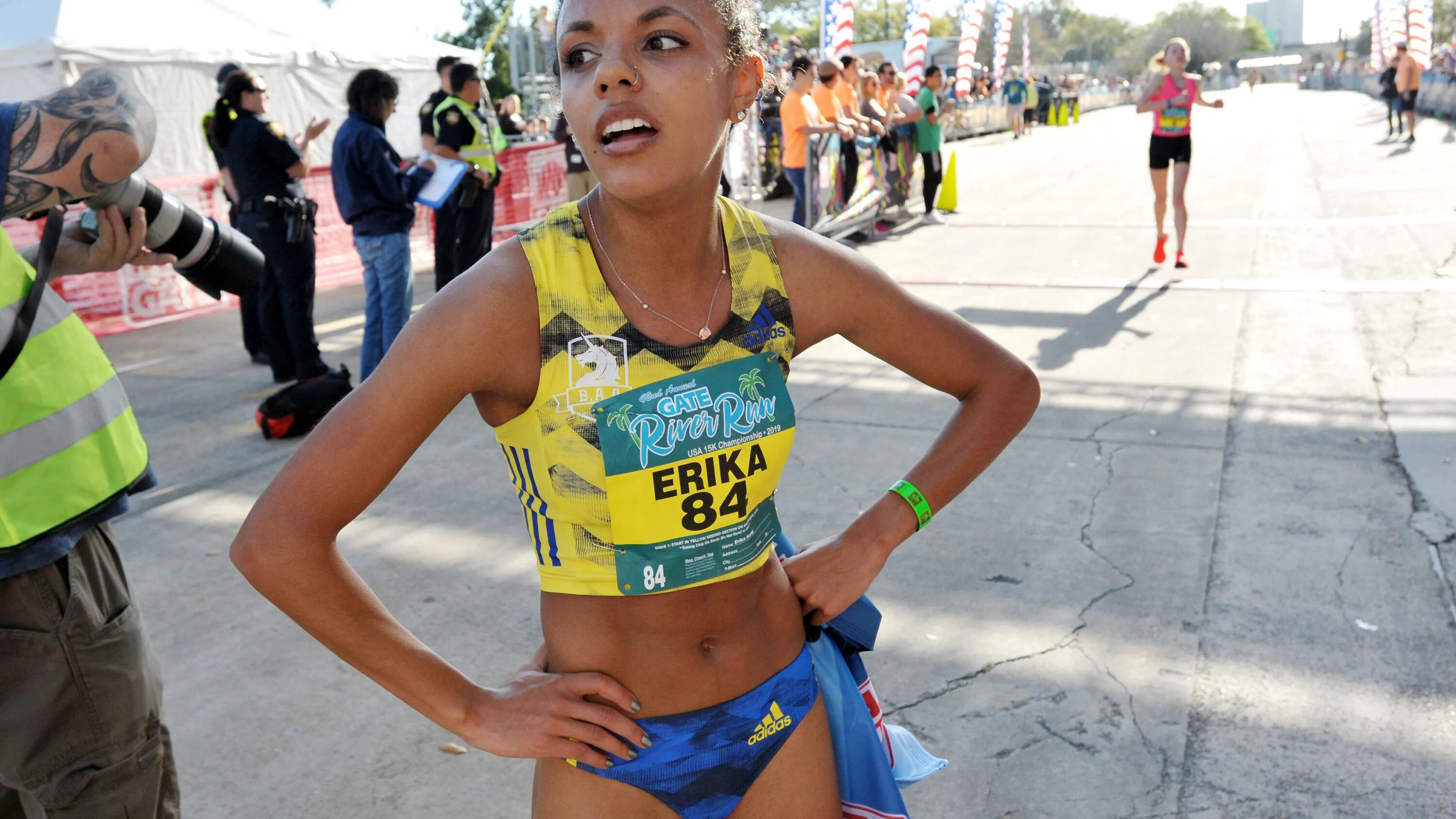
But Kemp, 28, who admits she gets lost easily, was running on the right side of the road through the town of Wellesley when she inadvertently got off course. She ran onto Route 9, an unappealing stretch of road with office parks, car dealerships, and a 50-mile-per-hour speed limit. She didn’t realize she was on the wrong road until 6 miles later. By the time she got back to her home in Boston’s Allston neighborhood, she had exceeded 23 miles—and she never did see those Newton hills.
She put in a call to Benninger.
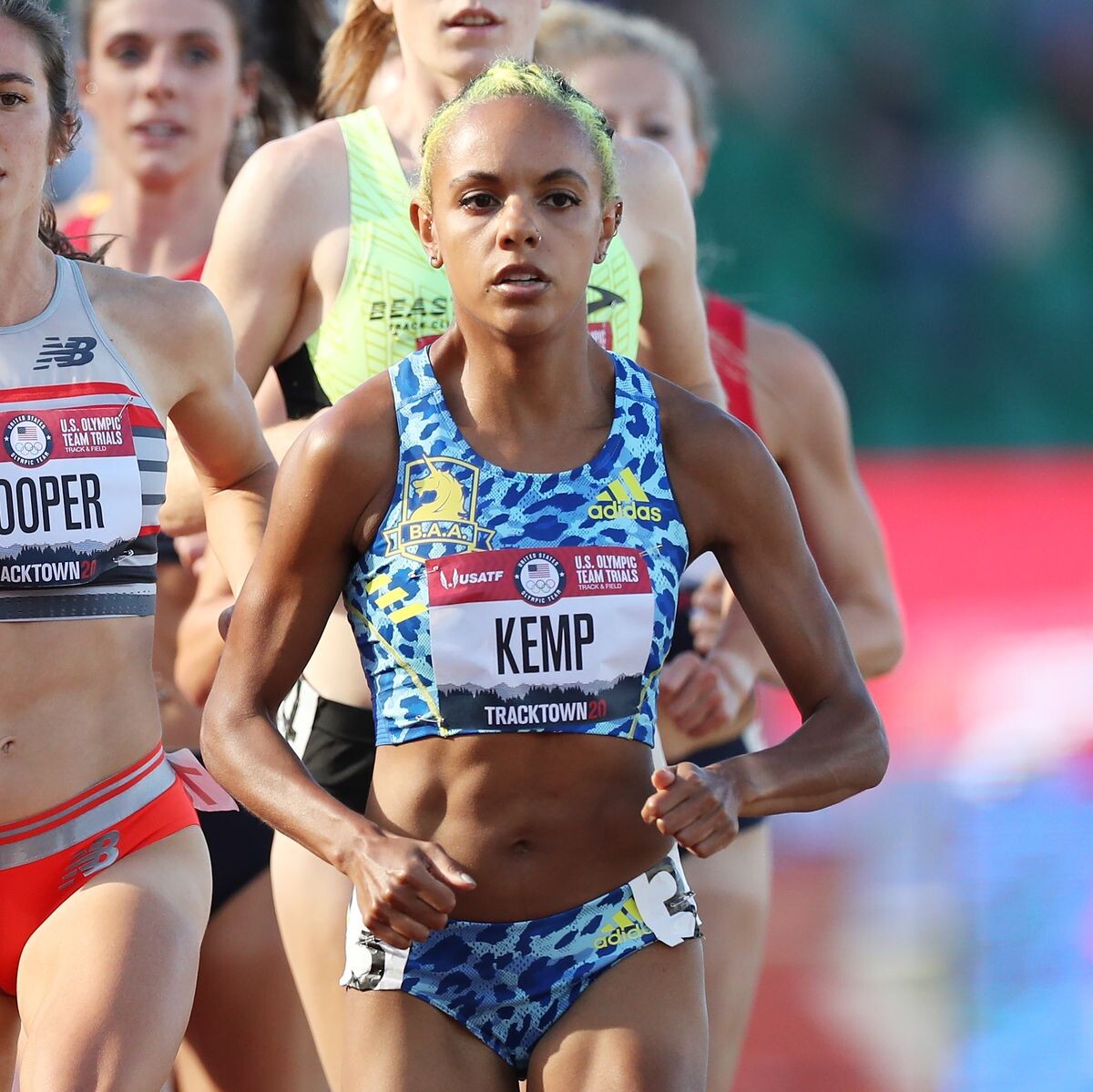
“I didn’t quite know how to tell him,” Kemp said. “It’s still a relatively new coaching relationship. How do I tell him I ran an extra 20 minutes and didn’t see the second half of the course I was supposed to see?”
Benninger, though, thought it was funny. So did Kemp. “He was super chill about it,” she said, and he told her, “Well, you got some extra volume. We’ll definitely go over directions more carefully next time.”
New beginnings
Early 2023 has brought many new roads for Kemp—some figurative, some literal. She decided not to re-sign with the B.A.A.’s High Performance Team at the end of last year. Now, in addition to the new race distance she’s trying, she has a new sponsorship deal with Brooks and a new training situation.
After Boston, she’ll move to Providence to be in person with Benninger’s group, which includes pros Marielle Hall, Helen Schlactenhaufen, and Brian Shrader (though the latter two train mainly in Boston). In addition, Benninger’s wife, Molly Huddle, who is coached by Ray Treacy, comes to a lot of their practices. Occasionally Emily Sisson, another Treacy athlete, will be in town. Kemp expects she’ll match up with Hall for most of her workouts.
It’s a big change from what she’s been doing, but Kemp felt like she needed it. She was a six-time All-American at North Carolina State University, and she improved on her college times at the B.A.A., running 15:10 for 5,000 meters on the track and 31:35 for 10,000. But she felt like she came up short at the biggest moments.
“I have yet to feel like I really have had that breakthrough race,” she said, “where all of my training and improvements have been reflected in a singular performance. I have had a lot of races the last couple of years where I got to the start line kind of fatigued. I don’t feel like it’s 100 percent reflective of how much I’ve improved.”
When she decided to leave the B.A.A., she didn’t have a training situation lined up for herself yet, and she was still talking to sponsors. So she got herself through the early days of marathon training by consulting with friends and a network of experienced marathoners, building up her mileage to 90 per week from the high 70s or low 80s she had been doing. It was a big jump for her, but she handled it well.
The only downside to marathon training is the constant hunger. Kemp is usually a sound sleeper, but she found herself waking up at 3 a.m. several nights in a row. Finally she realized she was hungry and started scarfing down a bowl of cereal. Then she’d go right back to sleep.
“You’re literally eating a bowl of cereal in the dark, and thinking, ‘What is my life right now?’” she said.
Whatever she was running—and eating—worked: In January, she finished seventh at the Houston Half Marathon in a PR of 1:10:14, averaging 5:22 per mile. With the performance, Kemp qualified for the 2024 Olympic Marathon Trials in Orlando, which she intends to run.
She said that Brooks felt like a natural fit as a sponsor, and the company didn’t mind if she wanted to stay on the East Coast instead of joining one of its two established training groups in Michigan or Seattle.
(03/03/2023) ⚡AMPby Sarah Lorge
Boston Marathon
Among the nation’s oldest athletic clubs, the B.A.A. was established in 1887, and, in 1896, more than half of the U.S. Olympic Team at the first modern games was composed of B.A.A. club members. The Olympic Games provided the inspiration for the first Boston Marathon, which culminated the B.A.A. Games on April 19, 1897. John J. McDermott emerged from a...
more...Dorcas Jepchirchir Tuitoek aims higher at Rome Ostia half marathon on Sunday
Dorcas Jepchirchir Tuitoek will be seeking another title in the Roma Ostia Half Marathon set for this Sunday in Rome, Italy.
Tuitoek has a personal best of 66:33, which she set at the 2019 Istanbul Half Marathon while finishing second.
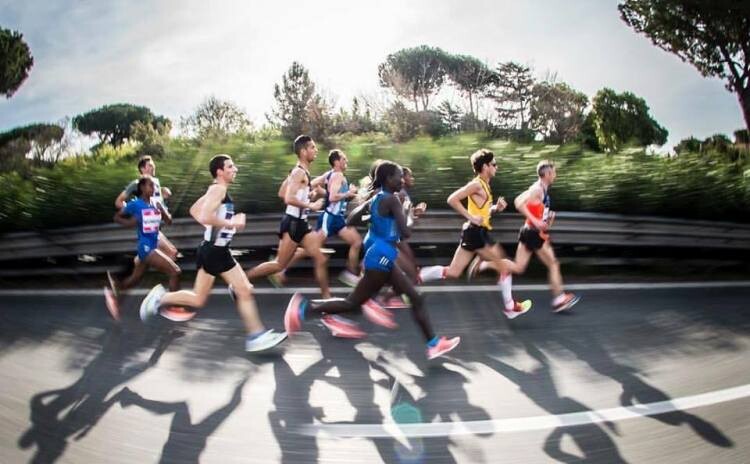
The Atlanta Half Marathon champion is confident of a podium finish as she seeks to lower her time in the Italian city.
“I am looking beyond this event because I want to use it as a springboard to one of the marathon major races later this year,” she said.
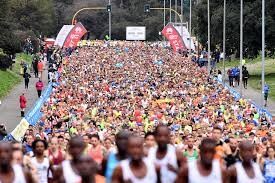
Tuitoek, who also won the Atlanta Half Marathon in 68:22, is optimistic of lowering her time as she prepares to venture into the full marathon," he added.
She said she is currently undergoing intensive training under Gianni Demadonna in Kapsabet and hopes to head to Rome with much fitness.
This will be her first race of the year on the road after competing in cross-country meetings across the country.
"I competed at the national cross country championships in Ruiru and I finished in position 12, which was good for me," she said.
In Rome, Tuitoek will be up against home girl Giovanna Epis among other top athletes.
The men's field will feature Kenya's Wesley Kibichii who has a personal best of 59:57 and Isaac Kemboi (60:11) among others.
However, the line-up includes top runners like Ethiopian Mogos Tuemay (60:11) and Italian citizen Danielle D’Onofrio (62:32).
(03/03/2023) ⚡AMPby Emmanuel Sabuni
Roma Ostia Half Marathon
Italy's most popular half marathon, this road race is a popular event for runners of all abilities. The Roma-Ostia Half Marathon is an annual half marathon road running event which takes place in the spring in Rome, Italy. The course begins in the EUR district of the city and follows a direct south-easterly route to the finish point near the...
more...Emma Coburn’s baked “fried” chicken sandwich
American Olympic medalist Emma Coburn knows a thing or two about fueling as an athlete. She has been a professional runner since 2013, and in that time she has won two world championships medals (one gold and one silver) and Olympic bronze. Without knowing how to properly fuel during training, Coburn’s resume might not be so colorful.
On top of her illustrious career as a pro, she has also written a cookbook, The Runner’s Kitchen, that shares her favorite recipes with fellow athletes. Here is one of her favorites, a baked “fried” chicken sandwich. Not sure how something can be baked and fried? Don’t worry, we’ll explain.
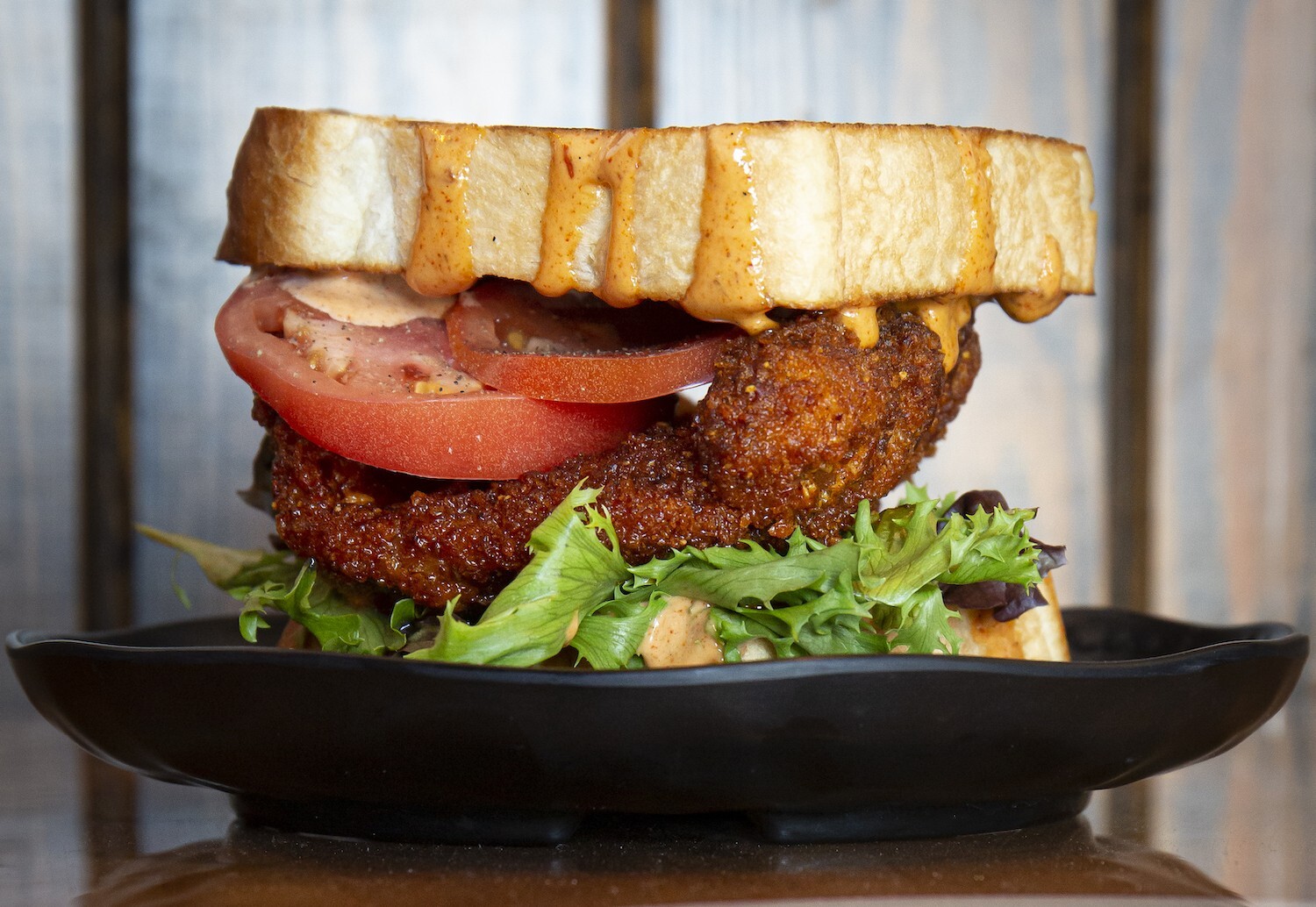
Ingredients
Coburn shared more than just the recipe for the chicken itself, adding directions for making pickled onions and a sauce to top the sandwich. She also notes that these recipes will serve “two hungry people or three to four light eaters.” For the chicken, you will need the following ingredients.

two chicken breasts
3/4 cup flour
1/2 tablespoon paprika
1/2 tablespoon chilli powder
1/2 tablespoon cayenne pepper
1 tablespoon creole seasoning
two eggs
3/4 cup panko breadcrumbs
brioche buns
For the pickled onion, grab these ingredients.
1/2 red onion
one cup white vinegar
1/4 cup warm water
two tablespoons salt
two tablespoons sugar
For a spicy sauce, use these:
1/4 cup plain yogurt
1/4 cup mayonnaise
two tablespoons sriracha sauce
Directions
Starting with the pickled onions, thinly slice your half red onion. Put your vinegar, water, sugar and salt in a jar, then shake until the salt and sugar are dissolved. Add the onion slices and close or cover the jar. For your sauce, combine the three ingredients and mix.
With the chicken, start by preheating your oven to 375 degrees. Slice the chicken so the pieces are around half an inch thick and divide into three separate sections. Next, pat your chicken dry with a paper towel.
In one bowl, combine the flour and spices, and in another bowl, beat your eggs. Have a third bowl set aside for your breadcrumbs. Toss your chicken slices into the first bowl of flour and spices, coating each piece with the mixture. Then, dip the chicken in the beaten egg mix. Put it back into the flour and spices once more before dipping it in the breadcrumbs, coating each piece. Place your chicken on a baking sheet and bake for 30 minutes (or longer if the chicken doesn’t fully cook in this time).
Once your chicken is ready, serve on brioche buns topped with your pickled onions and sauce. Coburn recommends adding a side of sweet potato fries or salad.
(03/03/2023) ⚡AMPby Running Magazine
Five times runners proved that age is just a number
We know that running is a sport for anyone, regardless of age, but it can still be quite surprising when senior citizens throw down amazing race results. The rest of us can only hope to be able to put our bodies through running races when we reach our 80s, 90s and beyond. There have been so many times that older athletes have wowed the running community, but here are five from the past few years that really impressed us.
The 93-year-old road runner

Canio Polosa of London, Ont., is the owner of multiple Canadian masters records in the M90 division. In 2021, then 93, Polosa broke the 5K record at a Halloween road race in London, where he ran 36:30. Just a few months later in April 2022, he ran another London race, this time a 10K, and although he was hoping to get anywhere under an hour and 20 minutes, he ran an amazing 1:14:04. This time was the 10K Canadian record, and he also beat the five-mile and 8K M90 records en route to the finish.
Running and jumping into the record books
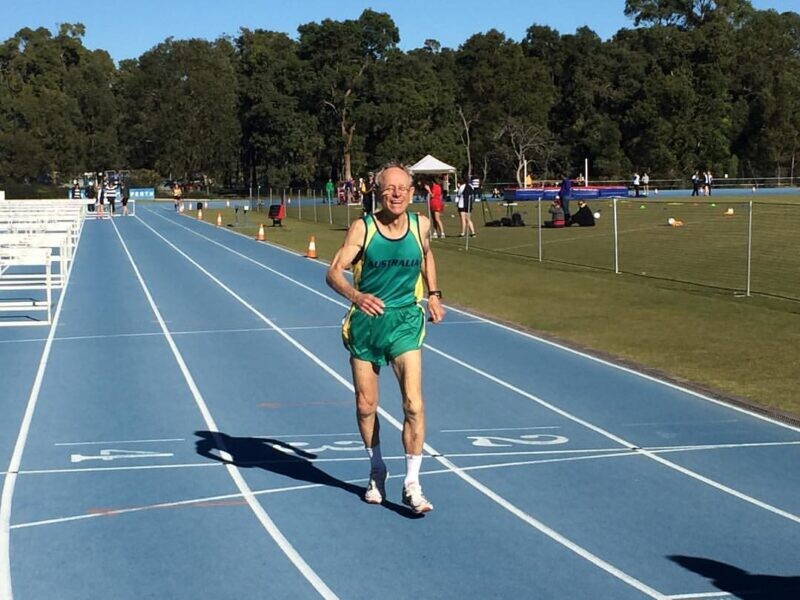
Canadian Carol Lafayette-Boyd was named 2022 World Masters Athlete of the year after breaking a whopping six world records in the W80 age division last year. She broke the outdoor 100m (16.23 seconds), 200m (34.90 seconds), long jump and triple jump records, as well as the indoor long jump and 60m dash. In her time as a masters athlete, Lafayette-Boyd has amassed an amazing 17 world records, and she doesn’t show any signs of slowing down.
A 90-year-old record holder
In the summer of 2022, Australian masters athlete David Carr turned 90, and in the following months, he broke five M90 world records on the track. Carr ran a 1,500m race in 7:32.95, a 3,000m in 16:20.96, the 5,000m in 29:47.83, a 10,000m in 62:48.93 and the 2,000m steeplechase in 12:50.43. All of these times are incredible, but to truly appreciate just how fast Carr is, one needs to look at his age-graded 1,500m result. The current 1,500m world record is 3:26.00, but Carr’s age-graded time works out to 3:16.00. He may not be a household name, but Carr is a track superstar, all the same.
Hurricane Hawkins
In 2021, American Julia “Hurricane” Hawkins became the first 105-year-old woman to race the 100m. She set a PB and world record of 1:02.95, although this was far from her first big result. Amazingly, Hawkins only started running when she turned 100, and she promptly began earning world records in the 100+ age division.
The battle of the 105-year-olds
Another 105-year-old woman recently broke Hawkins’ 100m world record. India’s Rambai ran the world record in June 2022 when she posted a time of 45.40 seconds. Rambai ran this time at the National Open Masters Athletics Championship in Vadodara, India, just a year after she began running competitively (that’s right–she started racing at 104). Not surprisingly, Rambai was the only runner in the 100-plus age division, but the lack of competition didn’t appear affect her motivation, and she smashed the previous world record by 17 seconds.
(03/03/2023) ⚡AMPby Ben Snider-McGrath
Japanese man runs 3:28 marathon in wooden sandals
Finishing a marathon is hard enough, but one Japanese runner pushed his limits at the 2023 Osaka Marathon, clocking a three-hour and 28-minute marathon while wearing traditional wooden Japanese geta sandals.
Takanobu Minoshima, a 47-year-old runner from Sapporo, averaged a pace of 4:56/km over 42.195 kilometres while wearing the wooden shoes and even had the word “Geta” as his name on his Osaka Marathon bib.
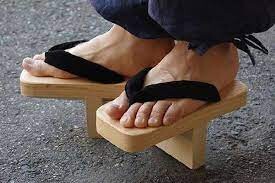
His final finishing time was 3:28:11 for 2,896th place (out of 10,000+ runners), which is only eight minutes shy of the 2023 Boston Marathon qualifying time of 3:20:00 for his M45 to 49 age group.
Geta are traditional Japanese sandals that are often paired with the yukata (robe) for informal occasions, such as summer festivals. The geta has a slab of wood attached to the foot with strings or ribbons and rests on a sturdy piece of wood (that’s a little higher than the maximum stack height allowed by World Athletics!). We have to hand it to him for being able to stay on his feet for an entire marathon while wearing these.

This isn’t the first time Minoshima has raced wearing geta. In 2019, he ran a 100K ultra race in 13 hours and 45 minutes at the Kamalai Shrine 100 in Taiwan. He has a marathon best of 2:59:20 from the Hokkaido Marathon in 2014, when he wore regular running shoes.
(03/02/2023) ⚡AMPby Running Magazine
The 2023 edition of the Lisbon half marathon, will feature a squad capable of record breaking times
In a statement, Maratona Clube de Portugal, responsible for organizing the race scheduled for March 12, says that Kenyan Rhonex Kipruto and Ethiopian Girmawit Gebrzihair “promise their best records ever in Lisbon”.
In addition to Kipruto, holder of the third best time ever (57.49 minutes), world record holder for the 10 kilometers and winner of the New York half marathon in 2022, the race in the Portuguese capital will feature 11 more athletes with times below the hour, including Rodgers Kwemoi (58.30), Hagos Gebrhiwet (58.55) and Sabastian Sawe (58.58).
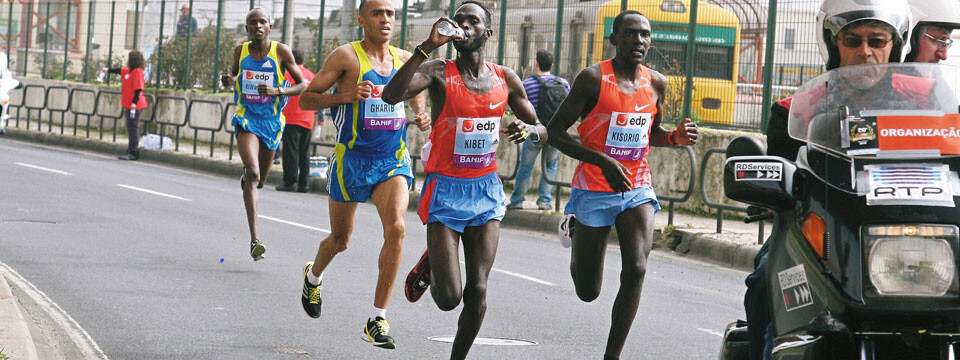
The Lisbon half marathon, which crosses the 25 de Abril Bridge, is the race that “holds” the world distance record (57.31 minutes), set by the Ugandan Jacob Kiplimo, in the 2021 edition.
In the women's race, in which the world record belongs to the Ethiopian Letesenbet Gidey (1:02.52 hours), the peloton will have three athletes with personal bests faster than the best time of the Lisbon race (1:06.06, by the Ethiopian Tsehay Gemechu), two of them within the historic top 10 in the distance.

The president of Maratona Clube de Portugal envisions “an exceptional race”: “We have a truly impressive group of athletes, both male and female, which could lead to the race record being beaten once again”.
Carlos Móia, considers that the fact that the limit number of registrations has already been reached – 15,000 in the half marathon and 15,000 in the 10 kilometer race - is “an evident sign of the confidence and relevance that the race assumes in the annual race calendar”.
(03/02/2023) ⚡AMPEDP HALF MARATHON OF LISBON
EDP Lisbon Half Marathonis an annual internationalhalf marathoncompetition which is contested every March inLisbon,Portugal. It carries World Athletics Gold Label Road Racestatus. The men's course record of 57:31 was set byJacob Kiplimoin 2021, which was the world record at the time. Kenyanrunners have been very successful in the competition, accounting for over half of the total winners, withTegla Loroupetaking the...
more...Canadian Cameron Levins will be seeking new national marathon record in Tokyo
Canada’s Cameron Levins is racing the Tokyo Marathon on Sunday, he will be looking to improve his own national record of 2:07:09, which he set last summer during the Eugene World Athletics Championships.
Asked if he will be going after the 2024 Paris Olympic entry standard of 2:08:10 or the 2023 Budapest World Athletics Championships standard of 2:09:40, he told Athletics Illustrated, “I think we’re waiting to see what the pace options are before making that decision, but certainly looking for a personal best and not just standard.”
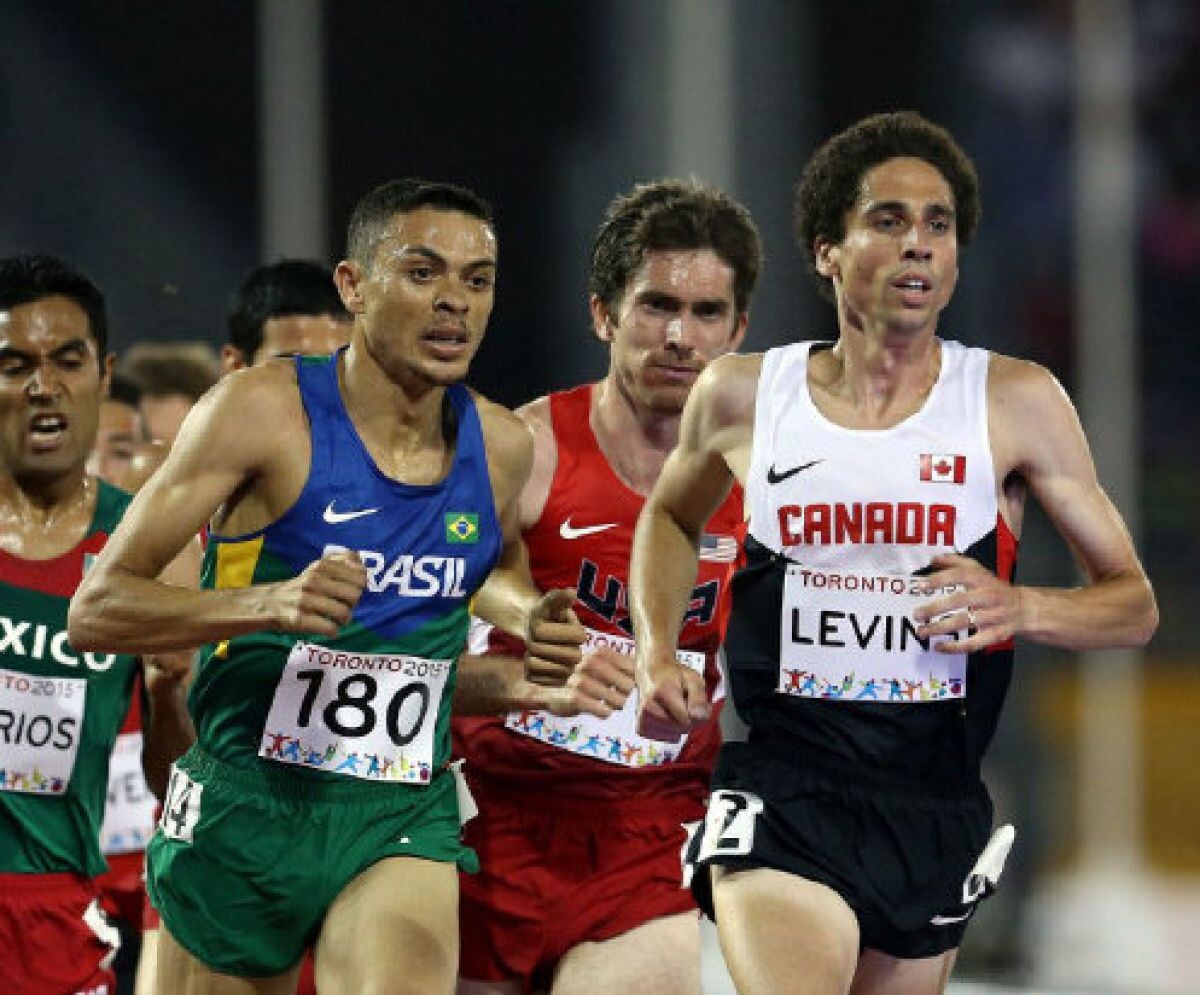
Levins set a new Canadian half-marathon record on February 12 at the First Half Half Marathon clocking a 60:18. He finished 4:03 ahead of his nearest competitor. Although that time, according to World Athletics’ points performance scale is almost, but not quite, as good as his marathon best, it was run in less than ideal conditions. For example, in Eugene, there was a highly competitive field to race with — to bring the best out of him. Additionally, in Vancouver, although not overly challenging, the weather was cool and windy. The general consensus is he could have run the First Half Half Marathon a little faster, yet. Perhaps right at the level of his national marathon record. So, we know from that performance he is in great shape.
Looking at his options in Tokyo, Levins has a fast course and runners looking for a fast time and prize money.

The field is led by Ethiopian Lemma Sisay who has run as fast as 2:03:36 back in 2019 at the Berlin Marathon. He has also run at least three other sub-2:07-marathons. As it has been four years since Sisay set his best, anyone of Kenyans Bernard Koech (2:04:09), CyBrian Kotut (2:04:47), Titus Kipruto (2:04:54), Ugandan Stehen Kissa (2:04:48), Ethiopian Deso Gelmisa (2:04:53) could challenge for the win. There are also several fast Japanese runners led by Kengo Suzuki with his 2:04:56. He holds the national record from Otsu, Japan two years ago. There are six others who have run 2:05 to 2:07 — right in Levins’ range.
The 24-year-old Kipruto finished second in the Amsterdam Marathon last October — less than five months ago. He was beaten only by Ethiopian Tsegaye Getachew by five seconds. Gelmiso, just 25 and Kipruto won the 2022 Valencia and Milano Marathons respectively. If the weather is ideal expect a couple of 2:03 marathons in Tokyo. Currently the forecast is trending in the right direction with projected highs of 13-16 degrees.
Prior to the 2020 Tokyo Olympic Games, Levins ran several marathons that ended in disappointment. These included the London Marathon in poor weather as well as Chandler, AZ, where he looked fresh at 32 kilometers into the race, running with the lead pack, only to fade to a 2:12:15 clocking. At the 11th hour, he boarded a plane for Fürstenfeld, Austria and ran a small marathon event just fast enough to qualify for the Olympics at 2:10:14. However, by the time he go to Sapporo, where the event was held, some 800 kilometers north of Tokyo, it was hot at 34 degrees celsius, and perhaps he had run too many marathons leading up. The standard was 2:11:30 at the time.
The 33-year-old Vancouver Island native has had big highs with breaking the Canadian marathon record three times, competing in two Olympic Games and at one time holding the national 10,000m record. Anything can and often does happen in a marathon event. Expect Levins to improve his own national marathon record and perhaps run 2:06 plus or minus a few seconds if all works out for him.
It was not long ago that the 43-year-old Canadian record was stuck at a modest 2:10:09 by Jerome Drayton from his run in Fukuoka, Japan in 1975. Excellent Canadian marathon runners Reid Coolsaet, Dylan Wykes, and Eric Gillis among others had led the Canadian Marathon resurgence. Levins has taken the mantle from there and has run with it to repeat records. The standard he has set and will likely continue to, will be a benchmark for up and coming Canadians to follow. Perhaps to put Canada back on the global marathon map.Levins recently signed with Asics as his new shoe sponsor. Until 2021, he was with HOKA and prior to that Nike with the now defunct Nike Oregon Project that was led by the now banned Alberto Salazar. Levins is now coached by fellow Vancouver Island runner Jim Finlayson.
(03/02/2023) ⚡AMPby Christopher Kelsall
Tokyo Marathon
The Tokyo Marathon is a world-renowned annual marathon held in Tokyo, Japan. As one of the prestigious Abbott World Marathon Majors, it attracts elite and amateur runners from around the globe. The race holds World Athletics Platinum Label status, recognizing its high competitive standards, top-tier organization, and international appeal. Sponsored by Tokyo Metro, the Tokyo Marathon has grown into one...
more...Steeplechaser Colleen Quigley’s homemade granola clusters are the perfect snack
This homemade granola may just become your new go-to snack.
You know how everyone’s talking about inflation these days? Well, if you like granola, you may have noticed how ridiculously expensive it’s gotten at the grocery store. Luckily, U.S. Olympic steeplechaser Colleen Quigley has a quick, easy and delicious DIY granola recipe that you’ll love, and that will save you money. She calls it Chef Colleen’s Collagen Clusters, and they’re apt to become your favorite homemade snack.
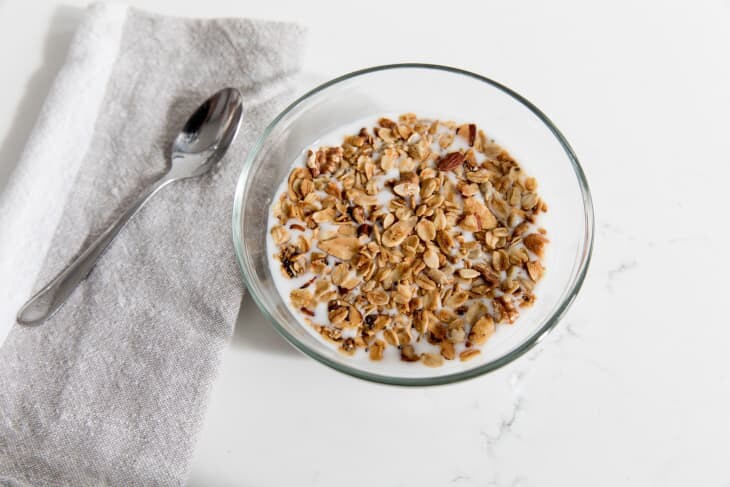
A passion for food
Quigley, who recently made her debut in elite triathlon, shared her granola recipe on Instagram, where she’s been known to post many of her “Chef Colleen” creations. In her days as a collegiate runner, Quigley went to Florida State University, where she studied dietetics, which focuses on the science of nutrition. As she previously told Canadian Running, she isn’t a registered dietitian, but “nutrition is a passion” of hers. “I have applied everything I learned into what I do now as a professional runner,” she said. “I can really see firsthand how important it is to fuel yourself as an athlete.”

Fueling yourself as a runner comes down to more than your three square meals every day (although those are very important), and if you’re working out regularly, you’ll need snacks to keep you energized and ready to go for every run and training session. Granola is a great snack for runners for several reasons. First, it’s an easy food you can eat while you’re on the go. Second, it’s a good source of protein that doesn’t require much work (unlike a protein shake or a full meal).
Recipe
3 cups of rolled oats
1.5 cups of chopped raw nuts and/or seeds (Quigley says to add whatever you like)
1 teaspoon of salt
5 tablespoons of collagen peptides (or any protein powder you prefer)
1/2 cup of melted coconut oil
1/4 cup date syrup, maple syrup or honey
Directions
In a large bowl, mix your oats, nuts and seeds, salt and collagen/protein powder
Add your coconut oil and syrup/honey
Spread granola evenly on baking sheet or roll into balls and place on sheet
Bake at 350 degrees for 20 minutes, stirring every five to eight minutes
Let cool and break into pieces (or enjoy granola balls, if you opted to roll them)
Enjoy!
(03/02/2023) ⚡AMP
by Ben Snider-McGrath
NHL star P.K. Subban wants to know why winter running is so great, the only way to fully understand winter running is by trying it
Recently, former Canadian NHL star P.K. Subban tweeted a classic running fail video in which a runner slips on an icy road, seconds after telling a reporter why winter running is so great. There’s no denying that this is a brutal yet hilarious video, but Subban posted it with two questions: “Why?” and “What’s the upside?”
Why?

To answer Subban’s question: runners run because we enjoy it. Yes, it’s hard and it can be painful at times, but if we didn’t like to run, we wouldn’t do it. Asking a runner why they run is like asking a chef why they cook or an artist why they paint. In each of those cases, you’ll get some variation of the same answer—“I like what I do.”
It’s addictive
When you first started running, you may have questioned why you decided to try it out. In fact, you may still ask yourself that from time to time. But soon enough, you likely found yourself craving a run. It’s a truly addictive sport, but if you tell non-runners that they’ll come to love it if they stick with it, most of them probably won’t believe you.

Post-race food and drinks
There’s nothing quite like food and drinks after a race. After running a long way, even something as simple as an apple can be the most delicious thing you’ve ever tasted. Until you’ve completed a race (or any other kind of endurance event) you can’t really know how amazing a post-race meal can be.
Self-competition
As a runner, you know how great it is to compete with yourself. When most runners enter a race, they aren’t aiming to cross the finish line in first place, and the only people they’re really trying to beat is past versions of themselves. If you tell a non-runner that you like racing yourself and trying to beat your past times and results, they’ll just give you a funny look and change the subject.
It’s fun
If you’ve ever told a non-runner that you run because it’s fun, they may have laughed in your face. Running used to be a punishment in gym class, and many people still think of it in that way. At the end of the day, all that matters is that you think the sport is fun. You’re not going to convince your non-runner friends that running is fun, just like they won’t convince you that it’s not, so we might as well just try to co-exist.
(03/01/2023) ⚡AMPby Ben Snider-McGrath
2023 Kaiser Permanente Napa Valley Marathon & Half at Full Capacity as Runners Gear Up for Race Weekend
The 2023 Kaiser Permanente Napa Valley Marathon & Half Marathon has officially sold out, with runners from around the world gearing up for the highly anticipated race. The event, scheduled for March 5th, has drawn runners of all abilities who are ready to tackle the scenic courses through California’s beautiful wine country.
The Napa Valley Marathon is a celebration of running, health, and wellness. The point-to-point race will feature several runners looking for their Olympic Marathon Trials qualifying time, including last year’s female champion and course record holder, Ann Centner (2:38:29). Others to watch include Peter Gilmore, Napa Valley Marathon’s 2009 champion who is now a top-level masters runner. This year’s field also includes wheelchair athlete Rob Balucas, who was injured in a biking accident in 2015 and became paralyzed. Rob hopes to qualify for the Boston Marathon.
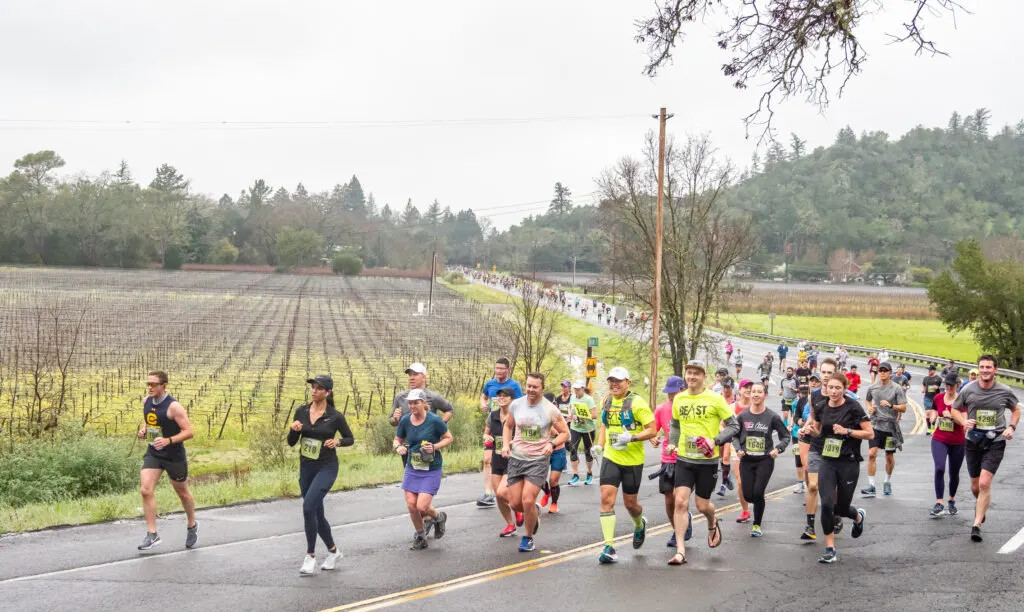
Local runner Jonathan Pascual is a five-time finisher of the Napa Valley Marathon and is returning to the race this year after a seven-year absence due to health issues. Jonathan was diagnosed with stage IV cancer and had to put his running on hold. But this year, he is ready to tackle the course once again.
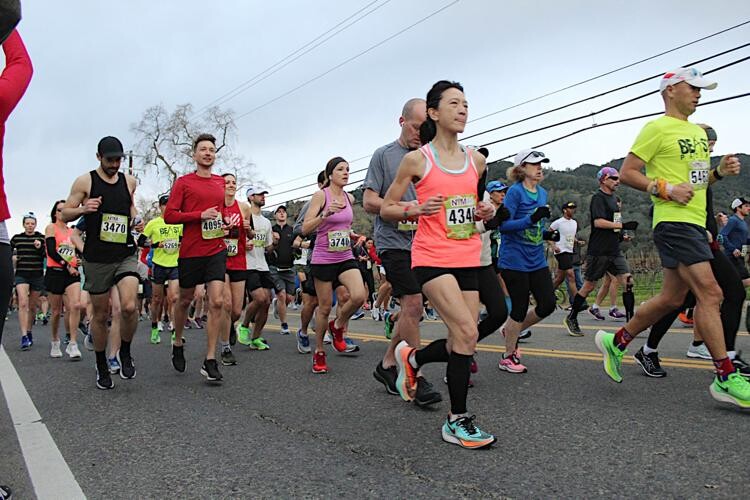
“It was through nutrition and my diligence in exercise that I could do a comeback running race in December 2022. I knew then that with the cancer treatments and continued training, I can keep getting stronger and fitter,” Jonathan said. “ I have accepted that I will no longer be the athlete I was once nor could I perform the way that I used to. So I decided that these are times of discovery. The challenge is to figure out what my mind and body can do athletically”.
According to Race Director, Michelle La Sala, “Whether runners are looking for a personal best, coming to celebrate a girl’s weekend, or seeking out a beautiful and inspiring course to achieve a goal, the Napa Valley Marathon offers it all. One of the largest sporting events in the valley and with proceeds supporting the local community, we are thrilled at the continued growth and notoriety this race brings. On behalf of the Napa Valley Marathon, Inc. board of directors and President Jonathan Williams, we look forward to welcoming runners to Napa and showing them a wonderful weekend!”
For more information about the 44th annual Napa Valley Marathon & Half Marathon, visit the event’s website at www.napavalleymarathon.org.
(03/01/2023) ⚡AMPby Running USA
Kaiser Napa Valley Marathon
As one of California's top tourist destinations, Napa Valley has been home to this race for decades. When it comes to scenic, it just doesn't get better than Napa in the spring. The narrow valley is covered in grape vines that stretch high up the hillsides on either side. The colors are crisp green, blue and yellow at that time...
more...Nine things only new runners will understand
We’ve all been a new runner at one point in our lives. The hardest part about being a new runner is that running feels impossible, right? It’s not! The truth is with a little patience, persistence and determination, anyone can become a runner. Here are 10 things only new runners understand.
1. How impossible it feels to run a single mile.
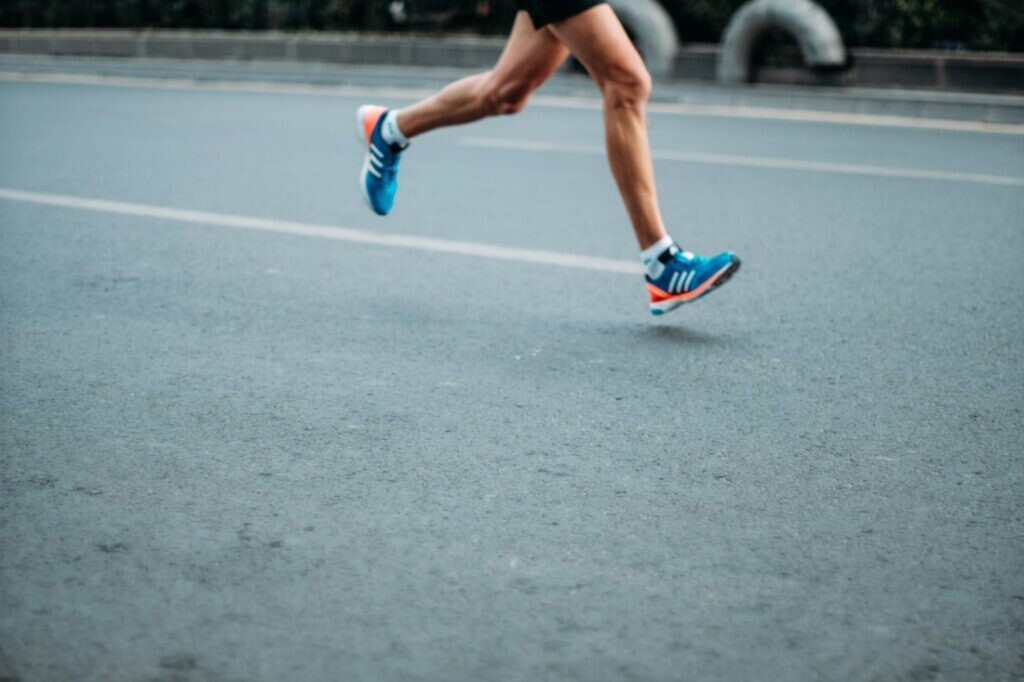
Don’t let the distance intimidate you! Think of each run as an opportunity to prove to yourself that you are capable of a lot more than you give yourself credit for.
2. How annoyed you feel every time another runner says they “only” ran 10 miles.
“Just 10 miles! I can’t even run three! WAIT! YOU RAN HOW FAST AND YOU’RE DISAPPOINTED?” smh

3. Registering for your very first race is one of the scariest days of your life.
Yes, that was your life that just flashed before your eyes. But don’t panic! It feels impossible today but that’s why you have a training plan! One day at a time!
4. The struggle that is trying to breath and run.
Endurance is built over time and funny enough, you’ll learn to love the feeling you get when your lungs are on fire while you’re gasping for breath.
5. Trying to figure out where to run.
Not only is running 3 miles incredibly intimidating but trying to figure out where to run 3 miles is an even bigger struggle! Do you try to drive the distance in the car first? Map it out on google? Play it by ear?
6. Trying to find the “right” pair of running shoes.
THERE ARE TOO MANY OPTIONS!
7. Feeling self conscious.
Good news! No one looks good when they run, so try not to stress about people judging you in public. I used to run at night so no one would see me. Now I embrace the fact that I look ridiculous when I run because we all do! Confidence is a muscle that will develop over time.
8. The pain!
Sore muscles, blisters, knee pain, hip pain, side stitches, boredom induced headaches…should I keep going?
9. Being really, really, really, really, really, really, painfully slow.
You’re not a slow runner. You’re a runner. NEVER be ashamed of your pace. You’re running and that’s all that matters! I know it’s easier said than done but your pace will improve over time.
Being a new runner isn’t easy but you’re only a new runner once so enjoy it! Celebrate every painful step because today’s impossible is tomorrow’s normal! You’re doing something incredible so keep fighting to put your strongest foot forward. Until next time, #RunSelfieRepeat.
(03/01/2023) ⚡AMPby Women´s Running
Seven reasons every runner should cross-train
Cross-training is a great tool for runners, but a lot of us don’t do it nearly enough (or at all). We get it, you’re a runner, so why would you use other sports to train for your next 10K? Well, there are actually quite a few reasons to cross-train, from injury prevention to general enjoyment, strengthening and more.
If you’re not already cross-training on a weekly basis, here are seven reasons to change that and add some new workouts to your schedule.
1.- Full-body workouts
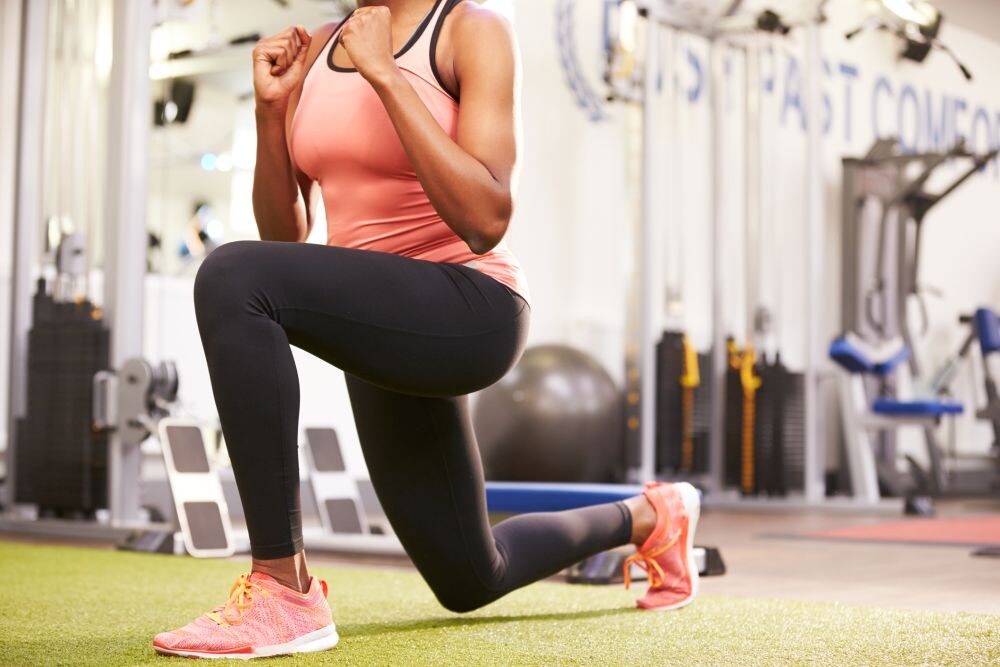
Running is a great workout, but it mostly affects your cardio and lower body. Adding different types of cross-training (swimming, strength work in the gym or kayaking, just as a few examples) will give you the chance to show the rest of your body some love. Just because you’re a runner doesn’t mean you shouldn’t aim to be fit overall, so try some full-body workouts next time you’re cross-training.
2.- Injury prevention
Cross-training is a great way to stave off injuries. Strengthening your muscles through lifting and bodyweight exercises will lessen your chances of getting hurt during your regular run training. You can also try low-impact workouts like swimming or cycling, which will help to maintain or improve your cardio fitness while also making you a stronger athlete in general.
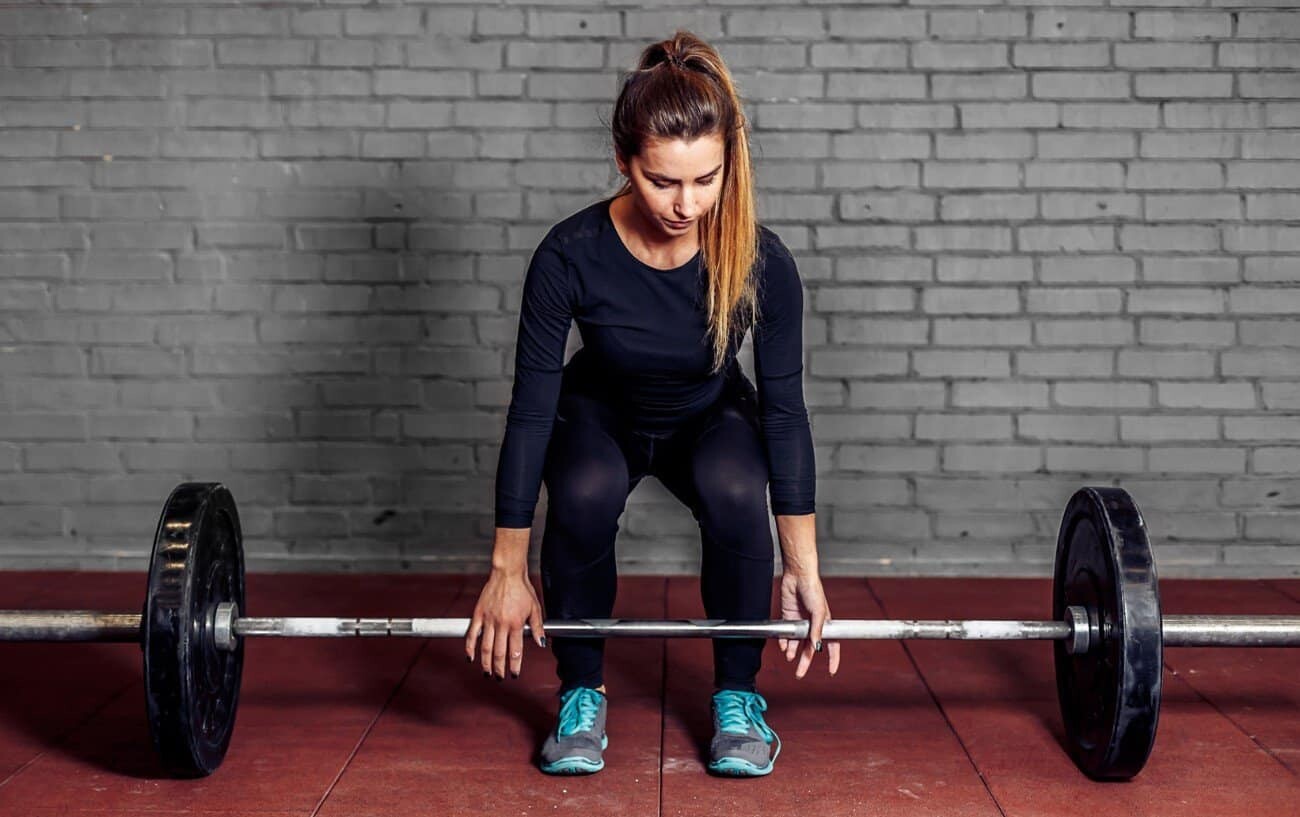
3.- Variety
Even the people who are the most in love with running will find the sport a bit boring from time to time. A great way to break out of that boredom is to mix things up in training. Cross-training will give your mind a much-needed break from the potential monotony of running one or two times a week. Try hopping on the elliptical or the stair-climber at the gym, or, if you have access, try snowshoeing or cross-country skiing, or hop in the pool for a break from the monotony of running.
4.- Active recovery
Everyone should include rest days in their training schedule. However, if you find you need a bit more time to recover after certain workouts but don’t want to take another day off, then cross-training is a great way to fit in some active recovery. This way you’ll continue to work on your overall fitness while still giving your body a break from the beating it can sometimes take during runs.
5.- No over-training
This aligns closely with injury prevention and active recovery, but if you include variety in your training, you’ll lower the chances of over-training and getting hurt. You don’t have to run for every workout, and if you do, there’s a good chance you’ll end up injured at some point. Commit to your training, but don’t overdo it with too much running. Instead, try something else every now and then.
6.- Good for injured training
Cross-training is not only good for injury prevention, but it’s also a great option for runners who are currently injured. You might not be able to run right now, but you can still work some training in, whether that’s on a bike, in the pool (swimming or pool-running), in the gym or anywhere else.
7.- Off-season work
It’s never a bad idea to give yourself an off-season, even if that’s just two weeks of no running at the end of the year. This is a chance for your body to recover from the previous months of hard work, and a break will likely benefit you mentally, too. Of course, after three or four days of no running, you’ll probably be itching to get back out there. Instead, try some cross-training to scratch that itch while still giving your mind and body their well-deserved breaks.
(03/01/2023) ⚡AMPby Ben Snider-McGrath
Betty Lindberg sets world 5k record for age 98
At 98 years old, Betty Lindberg continues to demonstrate that age is merely a number. This past Saturday, Lindberg, the world age-group record holder in the 5K, completed the Publix Atlanta 5K in a blazing 59 minutes, 6 seconds, an accomplishment that topped her age group at the USATF Masters 5K Championships. Lindberg, who walked for the duration of the race, clocked an 11-minute per kilometer pace.
Lindberg was greeted with flashing cameras and applause from fellow runners as she crossed the finish line. Still, the nonagenarian was oblivious to the fanfare as the first thing she did after crossing the timing mat was, of course, stop her watch.
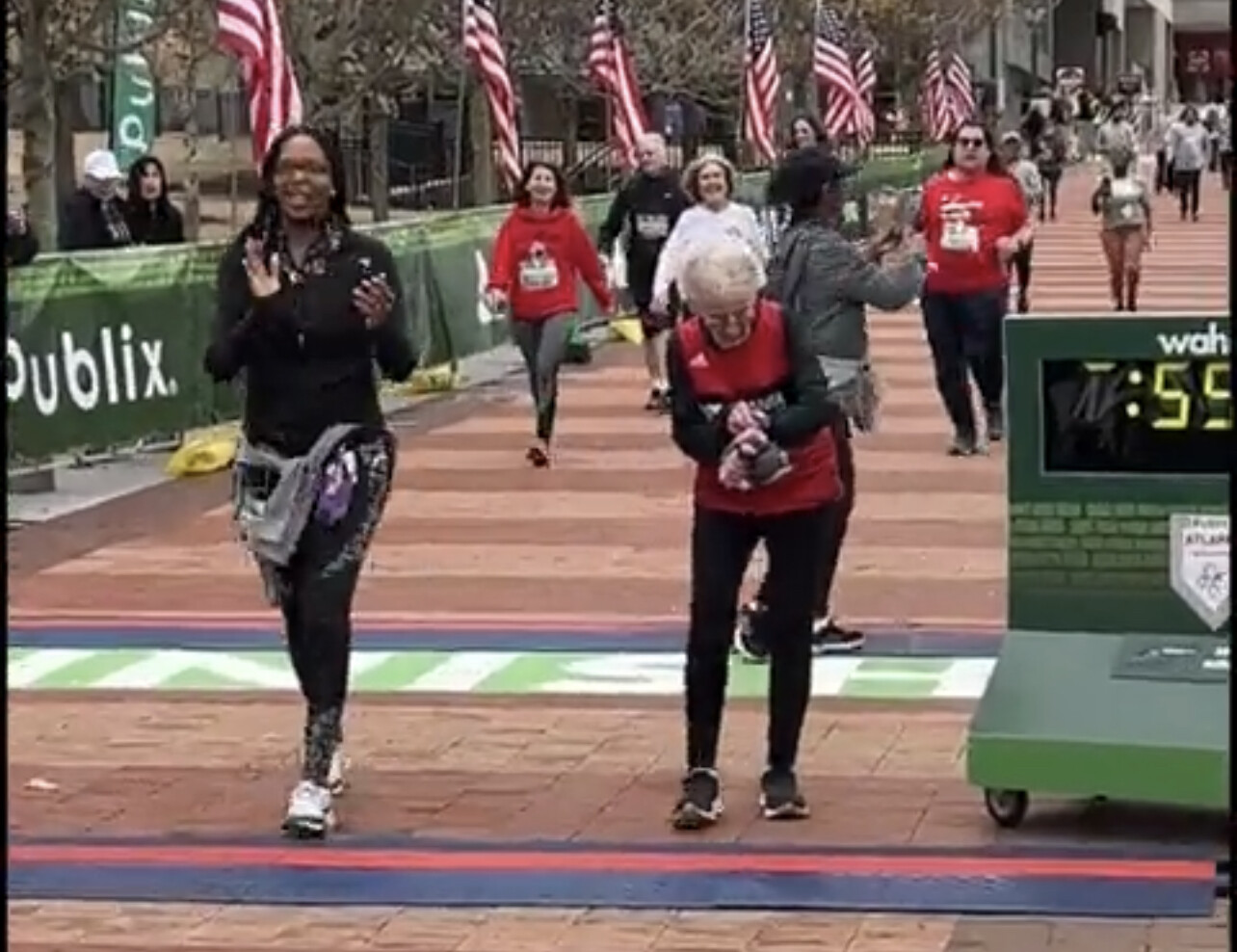
Last year, the Atlanta native made headlines when she crushed the previous 5K world record for her age group by more than 30 minutes, running a time of 55:48. That record, set in 2017 by 96-year-old Betty Ashley, was 1:28:36. (If you are a Betty between the ages of 95-99, you have a decent shot at toppling a record.) She told local media at that race she thought the record was achievable but was amazed at her record-breaking speed. “I simply stroll, as quick as I can,” Lindberg told the Atlanta Journal-Constitution.
Lindberg has been making local headlines for years with her racing exploits. She began running in the Atlanta Journal-Constitution Peachtree Road Race, an annual 10K, after driving her children to the race’s starting line in 1988 and feeling inspired by the runners there. “I was watching all these people come running by, and I said, ‘I can do that,’” she told WXIAlast year.
“I always say I’m never going to do it again,” Lindberg, then 97, told the news outlet in 2022. “I guess I just don’t know any better. As soon as I get across that finish line, all the aches and pains just disappear.” Since her first race in 1989, she has only missed one Peachtree Road Race.
At 91, Lindberg broke the world record in the 800m for women over 90 at an All Comers Track and Field Meet hosted by the Atlanta Track Club. Her time of 6:57.56 outdid the previous record of 6:59.18 set in 2001.
Lindberg works with a personal trainer three times a week to stay in top racing form while still getting in runs around her neighborhood regularly.
With Lindberg’s inspiring story, she serves as a reminder that age should never keep anyone from running. Take it from Lindberg herself, who told Runner’s World last year: “At 97, why are you supposed to do so poorly?”
(02/28/2023) ⚡AMPby Runner’s World
Five times non-running sports stars smashed foot races
Have you ever wondered if your favorite athletes in other sports could make it as elite runners? They’re at the top of their own sports and they’re clearly athletically gifted, so it wouldn’t be the biggest surprise if they could transition into running. Well, we can’t say for sure which athletes could have had success on the track or road if they’d dedicated their careers to running, but thanks to a few races over the years, we’ve been able to see a few sports stars in action.
Here are the top five times athletes from other sports crushed it in running races.
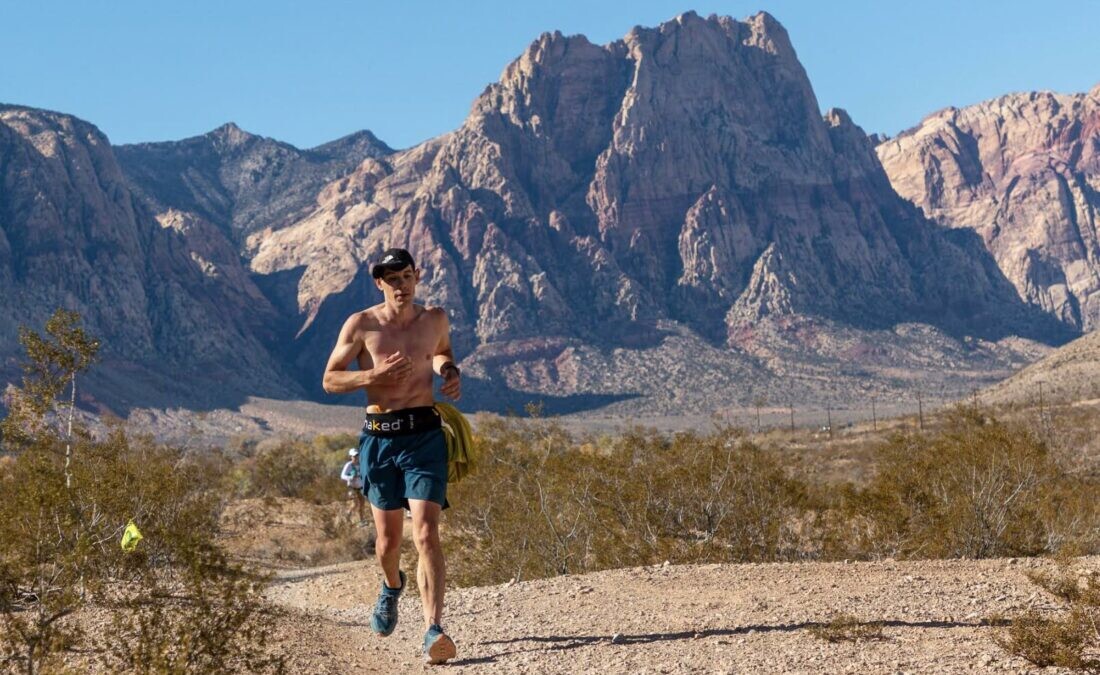
Arjen Robben
In November, former Dutch soccer star Arjen Robben ran the Zevenheuvelenloop, a popular 15K race in Nijmegen, Netherlands. Robben played for some of the top clubs in Europe, including Real Madrid and Bayern Munich, and he made it to the World Cup Final in 2010 with the Dutch national team. In Nijmegen, he ran the 15K course in 55:01, a time that works out to a pace of 3:40 per kilometer. As a player, Robben was known for his speed on the pitch (in 2014, he reached a top speed of 37 kilometers per hour during a World Cup match), but few people knew he could lay down such an impressive result on the roads.

Wayne Gretzky
In 1982, Wayne Gretzky (you might also know him as the best hockey player of all time) ran an exhibition race in Sweden alongside Pelé, Sugar Ray Leonard and Björn Borg—some of his fellow sports stars of the day. The race was 60m, and right from the gun, there was no doubt that it was Gretzky’s to win. He blasted off of the starting blocks and flew away from his competitors, eventually crossing the line in 7.24 seconds. (Granted, he was considerably youner than his competiors at the time.)
Alex Honnold
Alex Honnold is one of the world’s most famous climbers, thanks mainly to his 2017 free solo (meaning he climbed without ropes) ascent of Yosemite’s El Capitan and the subsequent Oscar-winning film, Free Solo, which documented his climb. It turns out that Honnold is not just a rockstar climber, as he proved he can run pretty quickly (and far) when he wants to. In November, he ran the Red Rock Canyon 50K Ultra near Las Vegas, racing to a sixth-place result in five hours and 23 minutes.
Therese Johaug
Norwegian cross-country skier Therese Johaug has the most impressive transition to running on this list, thanks to a couple of 10,000m races she ran in 2019 and 2021. Johaug is a six-time Olympic medalist (four of them gold) and a 19-time world championship medalist (with a whopping 14 gold). She entered the 2019 Norwegian 10,000m championship on a whim (after the race, she told reporters she hadn’t run on a track in 11 years) and ended up winning the title in a championship record of 32:20.86. That time was the fifth-fastest result in Norwegian history, but Johaug didn’t stop there. She ran another 10,000m in 2021 and improved her PB to 31:32.88, which is the fourth-best on Norway’s all-time list.
Chris Froome
British cycling champion Chris Froome may not have run an actual race, but in the 2016 Tour de France, he did resort to running the course for a stretch following a crash. Froome had a kilometer to go in that day’s stage when he collided with a motorcycle. His bike was wrecked and couldn’t have gotten him to the finish, so he turned and ran uphill until his team caught up and gave him a new ride. Froome lost the stage that day, but he won the Tour de France overall, thanks in part to his on-the-spot decision to run.
(02/28/2023) ⚡AMPby Ben Snider-McGrath
Vienna City Marathon set for April 23 2023
The men’s elite race of the Vienna City Marathon promises to present an interesting mix of athletes with different time goals on 23rd April. While there will be a group of Africans who aim to break the long standing 2:05:41 course record for a number of other runners the qualifying time for the World Championships this summer in Budapest is a major goal. 2:09:40 is the standard for the global championships and Norway’s Sondre Moen will be among those targeting this mark in Vienna.
Organizers of Austria’s biggest one-day sporting spectacle expect to register up to 35,000 entries for their event, including races at shorter distances staged parallel to the marathon. With such a figure the 40th edition of the Vienna City Marathon (VCM) will almost reach the dimensions of pre-pandemic years. Entry for the VCM, which is a World Athletics Elite Label Road Race and the only one in Austria that features such a high standard, is still possible at: www.vienna-marathon.com

There are hopes that the jubilee edition will be crowned by a course record. It was back in 2014 when Ethiopia’s Getu Feleke clocked 2:05:41. An athlete who could be capable of such a performance is Samwel Mailu, who ran his debut in last year’s Frankfurt Marathon although he was only entered into the race as a pacemaker. However the Kenyan carried on after leading for 30k and managed a fine 2:07:19 debut. He was runner-up in warm weather conditions. While Mailu will be running in Vienna for the first time fellow-Kenyan Charles Ndiema returns to the Vienna City Marathon. He finished fourth here a year ago when he clocked his PB of 2:08:12. At least two other athletes are expected to join a leading group which targets the course record: Kenya’s Elvis Cheboi and Abe Gashahun of Ethiopia have run very fast half marathons of 59:14 and 59:46 respectively. While Cheboi will run his marathon debut in Vienna Gashahun will be eager to improve his marathon PB of 2:09:25.
After a period with injuries and below par performances Sondre Moen intends to bounce back at the Vienna City Marathon. The main goal for the Norwegian record holder, who ran a European record of 2:05:48 when sensationally winning the Fukuoka Marathon in 2017, will be to qualify for the World Championships at the Vienna City Marathon. “I hope for a positive race in Vienna - physically as well as mentally“, said the 32 year-old Scandinavian. “I plan to run a controlled race with a negative split. Last year was one to forget because of injuries. Now I want to have a good race experience again.“
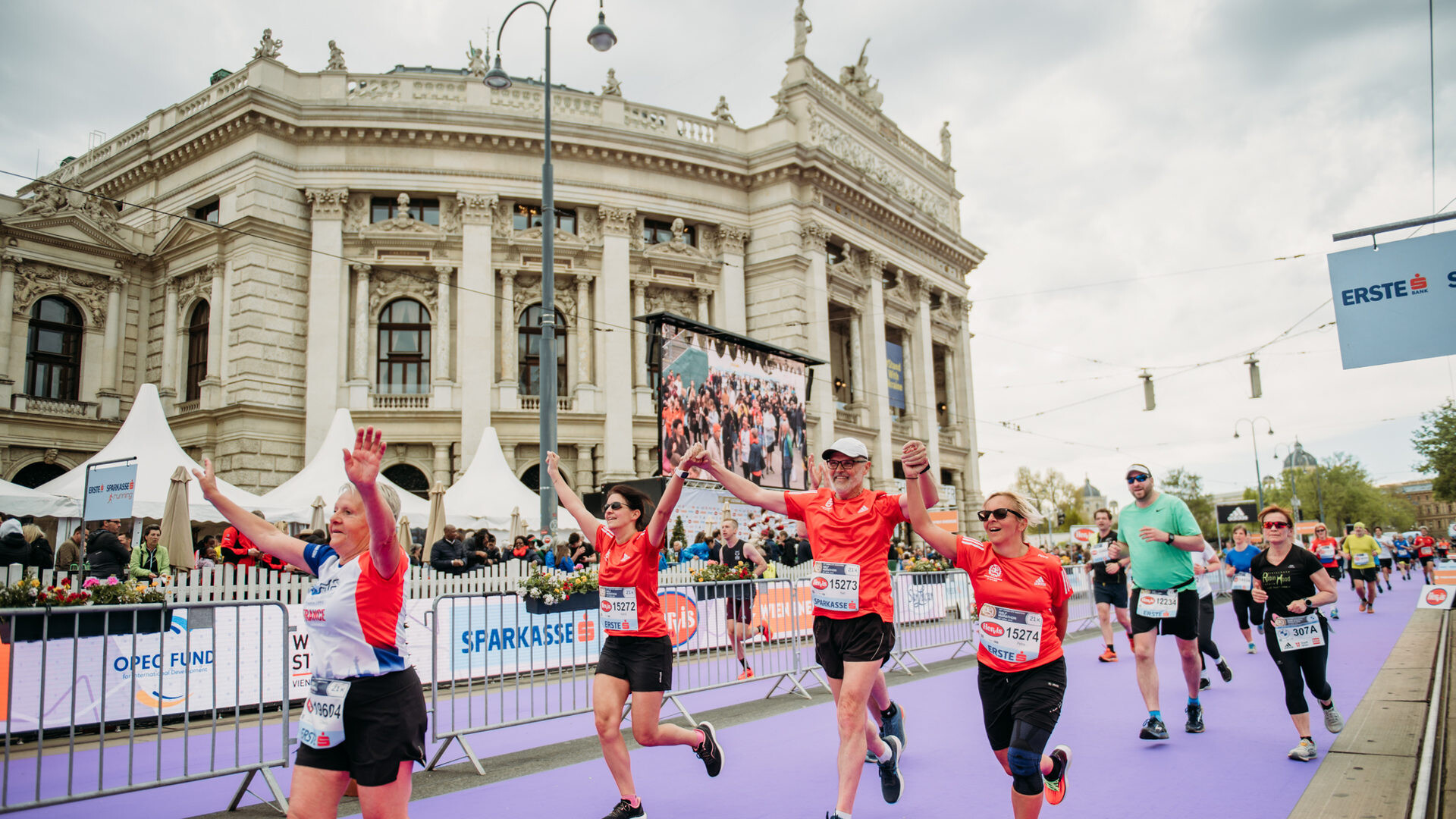
Another non-African runner who opted for the Vienna City Marathon to achieve the 2:09:40 qualifying time for the World Championships is Ser-Od Bat-Ochir from Mongolia. While the 41 year-old multiple national record holder ran the Mongolian marathon record of 2:08:50 back in 2014 in Fukuoka he broke 2:10 again in Otsu, Japan, two years ago where he ran 2:09:26. Ser-Od Bat-Ochir, who lives in Japan with his family and is sponsored by the Shin Nihon Jusetsu company, has already participated at ten World Championships. He now wants to improve this record by qualifying for his eleventh start. Last year he finished 26th in Eugene. Ser-Od Bat-Ochir also has been an Olympic marathon runner five times, first competing at the Games in Athens in 2004. „I opted for Vienna because the race is known for producing fast times and the level of the elite field will suit me,“ said the Mongolian.
Andreas Vojta could be among others who are expected to join Sondre Moen and Ser-Od Bat-Ochir in the chase for the World Championships’ qualifying time. There are high hopes in Vienna that the 33 year-old will establish himself as a top Austrian marathon runner on 23rd April. “I want to be 100 percent ready when I will at the starting line. And I am looking for a time of 2:10,“ said Andreas Vojta. The former middle distance runner, who competed in the 1,500 m at the London 2012 Olympics and at two outdoor World Championships, has an eye on the 2:09:40 standard as well. While he finished last year’s Vienna City Marathon in 2:23:21 after running as a pacemaker this will be his proper elite marathon debut.
(02/28/2023) ⚡AMP
by David Monti
Vienna City Marathon
More than 41,000 runners from over 110 nations take part in the Vienna City Marathon, cheered on by hundreds of thousands of spectators. From the start at UN City to the magnificent finish on the Heldenplatz, the excitement will never miss a beat. In recent years the Vienna City Marathon has succeeded in creating a unique position as a marathon...
more...Gerda Steyn hopes for a fourth win at Two Oceans
With 50 days to go to the “world’s most scenic race”, the Totalsports Two Oceans Marathon (TTOM) is shaping up to be an elite fest with a stellar field.
Once again, any athlete who breaks the record in the Men’s or Women’s Ultra Marathon Race can look forward to a record incentive of ZAR 250,000 (EUR 12,800) in cash.
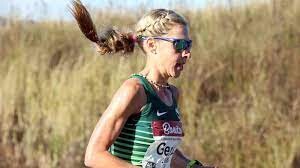
With prize money for the Totalsports Two Oceans Ultra Marathon at ZAR 250,000, any record-breaker could look forward to a massive ZAR 500,000 pay day on 15 April 2023.
Nkosikhona “Pitbull” Mhlakwana, who made a sensational Totalsports Two Oceans Marathon debut last year, lived up to his nickname showing tremendous tenacity finishing in a superb second place behind Ethiopia’s Endale Belachew, with Sboniso Sikhakhane coming in third.
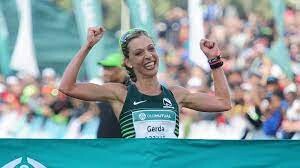
As expected, the 30-year-old considers himself to be a bit stronger and wiser, and determined to do one better this year.
“My main goal is to improve my position from last year,” says Mhlakwana.
The Hollywood Athletic club athlete says he picked up invaluable experience last year and now knows what to expect.
Another epic battle for supremacy is expected this year in the women’s Ultra. Gerda Steyn and ASICS athlete, Irvette van Zyl, who both shattered Frith van der Merwe’s longstanding women’s 56km record of 3:30:36 set in 1989, have confirmed they will line up again this year.
Steyn (3:29:42) became the first woman to run the grueling route in sub 3:30. The 32-year-old returns this year in a bid to be crowned champion for an unprecedented fourth consecutive time, while running as the current record-holder.
The three-time champion, who will be running in her permanent blue number, 6067, will, however, not have it all her own way, with the 34-year-old Van Zyl (3:30:31) finishing just a few seconds behind her last year. The purists can rest assured that Van Zyl will come out guns blazing and ready for another classic battle with Steyn.
Steyn says she is very excited to be preparing for the Totalsports Two Oceans Marathon again.
“This will be my fifth time running the race, and I am really hoping for a fourth win after taking the title three times in a row now. Last year was such a highlight for me. I am just hoping to repeat that experience and that win. The preparations until now have been going well, which makes me even more excited for the race,” she says.
With 50 days to go before Race Day, Steyn feels the next three to four weeks will be crucial to her preparations.
“Another very exciting aspect of this year’s Totalsports Two Oceans Marathon is that it will be the first time that I will be running in my permanent number in any race.
“Usually, one has to complete 10 Ultra Marathons, but I managed to win the race three times, therefore earned a blue number. This brings a very special touch for me. At the moment I am preparing for the Two Oceans in Johannesburg. The energy level and excitement is at an all-time high," adds Steyn before wishing all runners everything of the best with the final stretch of preparations.
If excitement levels are high for the Ultra on the Saturday, the battle for supremacy in the Half Marathon on Sunday, 16 April, will be even higher. The likes of previous winners Stephen Mokoka, Elroy Gelant, as well as Precious Mashele from the Boxer Athletic Clubs, have all confirmed their entries. Moses Tarakinyu from Zimbabwe is back to defend his title with Entsika’s Desmond Mokgobu also looking to improve on his third place from last year.
Last year’s winner, Fortunate Chidzivo, will not be lining up to defend her title in the women’s Half Marathon this year, which leaves the race wide open for a new champion to be crowned.
(02/28/2023) ⚡AMPby AIMS
Two Oceans Marathon
Cape Town’s most prestigious race, the 56km Old Mutual Two Oceans Ultra Marathon, takes athletes on a spectacular course around the Cape Peninsula. It is often voted the most breathtaking course in the world. The event is run under the auspices of the IAAF, Athletics South Africa (ASA) and Western Province Athletics (WPA). ...
more...British man runs 70+ consecutive marathons with his dogs
During the past two months, a British man has taken running with his dog a step further (literally). Aaron Robinson of London and his two border collies, Inca and River, have completed a mind-boggling 72 consecutive marathons together.
The trio sets out from their home in east London at 3 a.m. to run a marathon loop around nearby parks and woodlands, before Robinson heads to work. Robinson told the Daily Mail that each marathon takes around five hours.

Robinson and his dogs have broken the previous human/dog Guinness world record for consecutive marathons, which was 62. Since breaking the record, Robinson has faced a lot of heat online for putting this mileage on his dogs, but defended himself: “Since border collies are working dogs, if they weren’t pets they would be used to working on a farm all day, so they’re very used to running and working hard, and actually the cruel thing is just to keep them inside,” says Robinson. “They love it.”
During his journey, the 40-year-old dog owner and marathoner has been fundraising for the charity he works for, Hope for Justice, which aims to tackle human trafficking and modern slavery in London.
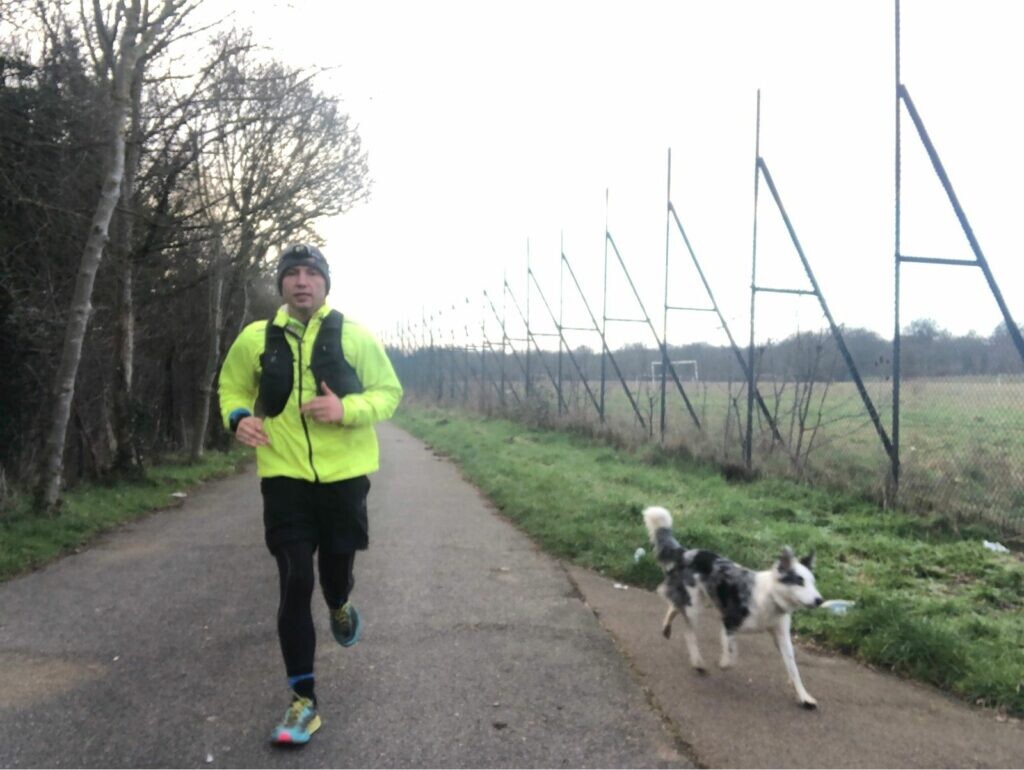
Border collies are known to be athletic and exceptional runners that can easily outpace their owners if given a chance. The number of kilometres a dog can run can vary depending on the dog’s breed, health, attention span and training.
Robinson said in another article that the marathons have become hard work, adding, “It’s quite hard to get enough sleep, get enough calories in and then go to work afterwards—you don’t really recover 100 per cent before the next one.”
Robinson has not decided when he will stop his challenge, and plans to continue to run a marathon every day.
(02/28/2023) ⚡AMPby Marley Dickinson
Ethiopian runner breaks women-only world 50K record in South Africa
Ethiopia’s Emane Seifu Hayile broke the women-only 50K record at a race in South Africa on Sunday, running 3:00:29. Competing in the Nedbank Runified Breaking Barriers Ultramarathon in Gqeberha, a coastal South African city, Hayile shaved almost four full minutes off the previous women-only world record. She was less than a minute off American Des Linden‘s 50K women’s mixed-gender race world record of 2:59:54 from 2021.
Women-only races mean that there are no men in the field. Because of the potential benefit that female runners can receive while pacing off male athletes, World Athletics recognizes two types of records for road races, making it possible for Hayile’s 50K record to co-exist with the one belonging to Linden, which she ran alongside male pacers.
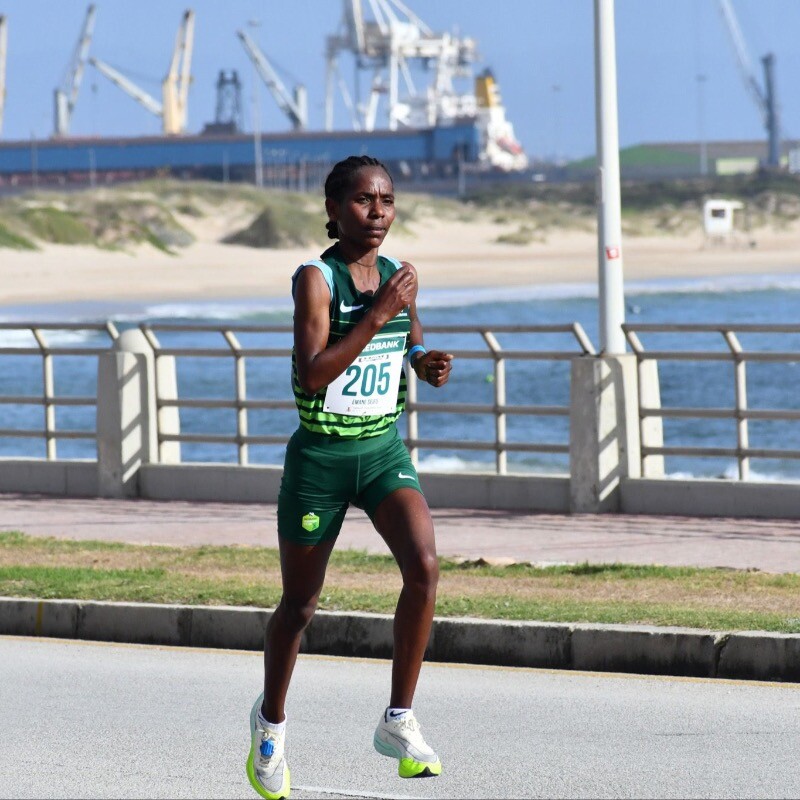
Despite running in a women-only race, Hayile came extremely close to claiming the outright 50K world record, finishing mere seconds behind Linden’s time. She ran with two fellow Ethiopians and a Swedish athlete in the opening stages of the race, passing through 10K in just over 36 minutes and 15K in 54. At around 20K, Hayile and her compatriots dropped the Swedish runner and carried on in a three-way battle. At the halfway mark, the trio clocked a split of 1:30:28, just shy of sub-three-hour pace.
Over the next 10K or so, Hayile dropped her two remaining challengers, and by the 40K checkpoint she was almost a minute ahead of second place. She clocked a 2:32 marathon and managed to accelerate as she neared the finish, crossing the line just north of three hours. Hayile won the race by six minutes and bettered the women-only record by four minutes.
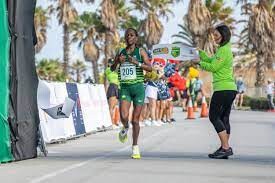
“I am lost for words and don’t know how to describe it,” Hayile told World Athletics after the race. “All in all, it was an exciting event. I’m very happy.”
In the men’s race, South Africa’s Tete Dijana ran a course record of 2:39:04. This result is the second-fastest 50K of all time, sitting just 20 seconds behind American CJ Albertson‘s world record of 2:38:44, which he ran in Oct. 2022.
(02/27/2023) ⚡AMPby Ben Snider-McGrath
Marathoners: test your aerobic fitness with this moderate distance workout
There’s truly nothing like marathon training–putting your life on hold for 10 to 16 weeks to train for a three- to four-hour race. What makes the marathon intriguing is the uncertainty, and whether you can finish in the time you set out for. You can do everything right to prepare for race day, but you can’t control the events that transpire on the course–weather, fuelling, an unfamiliar course, etc. The best thing you can do is set yourself up for success by knowing your mental and physical capabilities. In workouts, you want to be sure you are running enough volume in workouts to build mileage while benefiting from aerobic gains.
It’s essential to understand that the distance is almost entirely aerobic; your heart rate (HR) will stay well below your maximum for almost the entire race, unless you find yourself in a sprint finish. This means you don’t need to do extremely fast workouts.

Workout:
Five reps of 3K at goal marathon pace or faster, with 3 mins jog rest between reps

The purpose of this workout is to simulate race day and to determine where you at in terms of your aerobic fitness. Start each of the five reps at your goal marathon pace, and subtly increase your pace on the third to fifth reps. Treat the rest as an upbeat jog, allowing your body to recover, but not completely slowing down.
This is a workout you should do in the middle of your training block–let’s say six to eight weeks out from race day. If you are training for a 3:30 marathon, you should aim to hit each 3K rep at 15:00 or faster and make sure your jog isn’t slower than 6:00/km.
The five by 3K workout can also be used for half-marathoners—but instead of doing the workout at marathon pace, half-marathoners would do it at their goal HMP. The entire workout should come out to around 20 km in volume.
Completing this workout should give you an idea of where you are in your training before your upcoming race. If you can easily hit the paces on each rep via short rest, you shouldn’t have a problem tackling more mileage or harder workouts, but if you fall off the pace, you may want to reconsider your time goal.
(02/27/2023) ⚡AMPby Running Magazine
After 113 straight ultramarathons, Candice Burt still isn’t done
American ultrarunner and race director Candice Burt completed a 50K on Sunday morning. She did the same thing on Saturday, and also on Friday, and for 110 days before that. In November, Burt, who hails from Boulder, Colo., decided to shoot for the Guinness World Record for most consecutive ultramarathons.
The previous record was 23 days, a total Burt surpassed about three months ago, and she’s still going, with a whopping 113 consecutive ultramarathons to date.

When Burt started her ultramarathon record attempt, the number to beat was 11 days. The total has reportedly been changed on multiple occasions since Burt set out to break the record, and it currently sits at 23 days on the Guinness World Records site. The record Burt was chasing and has since beaten is listed as a female and non-binary mark, but she has also smashed the male record of 21 days.
As Burt noted on her website, she can’t recall exactly what sparked her desire to chase this record, but she said it could have been after she saw ultrarunner Jacky Hunt-Broersma run 104 marathons in a row in 2022, or Alyssa Clark, who ran 95 straight marathons in 2020.

Burt added that it may have been her own previous hiking and ultrarunning feats that convinced her she could complete a challenge as big as an ultramarathon streak. But it looks like she could keep going for a while.
While Burt has now produced an incredible streak of more than 100 days, she wrote that she wasn’t even sure if she could make it to the record. “From the very start of considering the streak I just wanted to be open to doing it for as long as my body would hold up,” she wrote. “I wasn’t sure if that would even be the record-breaking 23 days, but I wanted to try.” Despite this uncertainty, she said that her goal was to go “much, much bigger” than 23 days, and even early in this journey, a result in the triple digits was on her radar.
Burt is the race director of popular ultras like the Moab 240 and Bigfoot 200.
(02/27/2023) ⚡AMPby Ben Snider-McGrath
Courtney Dauwalter dominates Transgrancanaria in record-setting fashion
American ultrarunning star Courtney Dauwalter proved why she’s the athlete to beat on the ultramarathon scene after an incredible performance at the Transgrancanaria in Spain’s Canary Islands on Saturday. Dauwalter crossed the finish line of the 128K course in 14:40:39, a course record and almost two full hours ahead of second-place finisher (and Canadian) Jazmine Lowther. The Transgrancanaria marked the start of the 2023 Spartan Trail World Championships series.
Dauwalter’s dominance
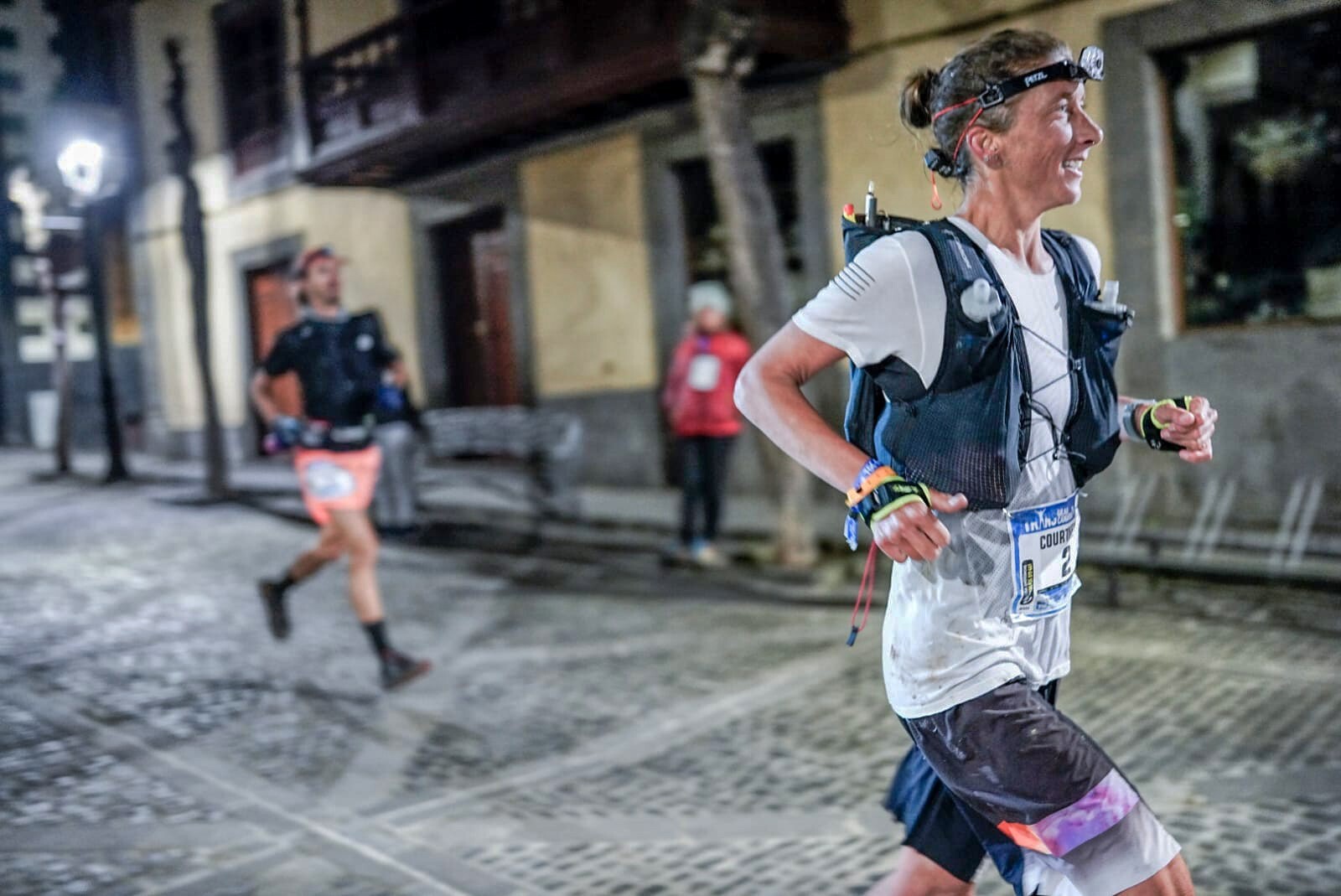
Everyone in the trail and ultrarunning communities knows that Dauwalter is an all-time great, but it’s still awe-inspiring when she shows up to hotly contested races and dominates her competitors. As listed on the trail and ultrarunning results database UltraSignup, Dauwalter entered the Transgrancanaria on a 14-race win streak that stretches all the way back to March 2021. (The last time she failed to reach the top step of the podium came at the Barkley Marathons.) She added yet another win to her resume on Saturday, extending that amazing streak to 15 and counting.
The Transgrancanaria is held on Gran Canaria, one of the Canary Islands, and it takes athletes along an arduous 128K course that features more than 7,000m of elevation gain. Dauwalter started the race chasing Lowther and Spain’s Claudia Tremps, who led for the opening stages of the run. About a quarter of the way into the race, Dauwalter took control of the field and moved into first place. From that point on, she never looked back, leaving Lowther and Tremps to battle it out for second place.
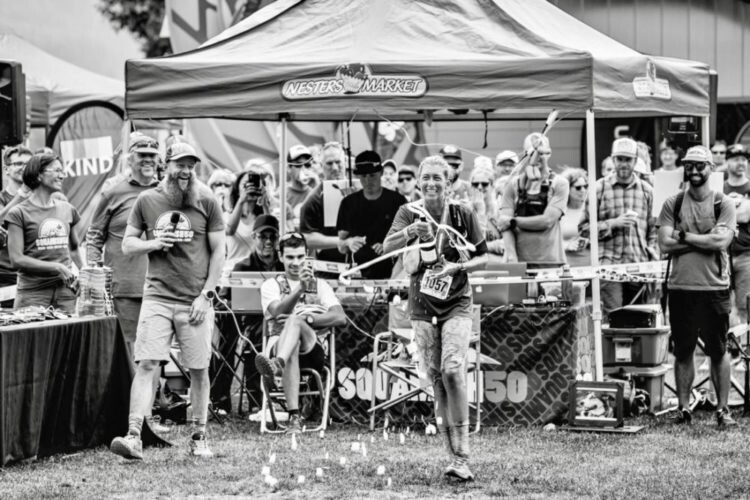
Dauwalter’s relentless attack on the course worked out to an average pace of 6:53 per kilometer, a blazing speed to hold in a race as long and as difficult as the Transgrancanaria. More than 90 minutes behind her, the race for second was quite close. Lowther and Tremps ended up just seven minutes apart, with the Canadian crossing the line in 16:26:41 and the Spaniard stopping the clock in 16:33:34.
In the men’s race, Spain’s Andreu Simon won in 13:39:33, followed by Portugal’s Miguel Arsénio (13:44:37) and American Tyler Green (14:06:46).
(02/27/2023) ⚡AMP
New Mom and Elite Runner Molly Huddle is Ready to Take on the NYC Half
Molly Huddle admits making time for running is considerably more challenging since giving birth to a baby girl last April, but she’s excited to be back racing at a high level as a healthy and fit mother.
The 38-year-old two-time U.S. Olympian ran so well at the Houston Half Marathon on January 15, she’s optimistic about racing a late spring marathon. Next up, Huddle will be racing in the deep women’s elite field at the United Airlines NYC Half on March 19 for the first time since taking her third consecutive victory in the event in 2017.
Huddle began to gradually increase her training late last summer under the guidance of longtime coach Ray Treacy and ran a couple of moderately fast 10Ks and a half marathon last fall. But then she had a big breakthrough when she ran 1:10:01 in Houston. Even though that was well off the 1:07:25 PR she recorded while setting an American record in 2018, it was still an impressive effort.

“I wasn’t sure if I’d get back to even doing that, so that was good,” Huddle said. “Sometimes it’s good to just start 100 percent over and slowly build back. I think that was the only way I was gonna do it. I haven’t really been tested at a level that would be like trying to PR or qualify for a U.S. team, so we’ll see how it goes. But I think there’s a lot out there. I mean, just because you’re not making the Olympic team, you can still do a lot in the sport.”
Huddle said she generally felt good while running about 40 miles a week through eight months of her pregnancy, but then backed off and did whatever she could manage in the final month before Josephine was born on April 26. After giving birth, Huddle took extra time to recover until she felt like she could run consistently, but she also consulted with a pelvic floor specialist to make sure she wouldn’t risk injury by incorporating too much training intensity too soon.
While she’s earnestly back to training at a high level, she admits she’s still managing the physical challenges of breastfeeding, as well as the new time constraints as she and her partner, Kurt Benninger, the head cross country coach and assistant track coach at Brown University, juggle their schedules to maintain their professional lives while prioritizing their efforts to care for their daughter.
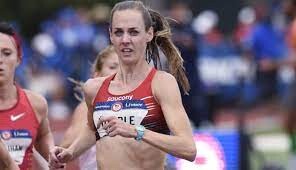
Huddle is grateful for the continued support from her longtime sponsor Saucony, as well as the increased honest public and social media conversations among women athletes becoming mothers. She says she’s taken cues, inspiration and advice from fellow elite-runner moms Aliphine Tuliamuk, Faith Kipygeon and Sara Vaughn, among others.
“It’s just a long timeline, but it’s been great to see other women do it,” Huddle says. “It takes some time and some, you know, intentional exercises and some pacing yourself, but then once you get the green light after, you know, a certain amount of months, I feel like you can do everything you were doing before.”
Huddle won the NYC Half in 2015, 2016, and 2017,with her winning time of 1:07:41 from 2016 setting an event record that stood until last year. She’ll line up against Ethiopia’s two-time Olympian Senbere Teferi, who last year broke Huddle’s event record while winning in 1:07:35. She is also a two-time world championships silver medalist and the 5K world-record holder (14:29) for a women-only race.
Other Notable Runners for the NYC Half
Two-time Olympic medalist and seven-time world championships medalist Hellen Obiri of Kenya, three-time Olympian and four-time European Championships medalist Eilish McColgan of Scotland, and two-time U.S. Olympian and 2018 Boston Marathon champion Des Linden will also toe the line in New York. Other top Americans include Dakotah Lindwurm, Erika Kemp, Maggie Montoya, Annie Frisbie and Jeralyn Poe.
Huddle hasn’t announced which marathon she’ll run in late April or early May. Her last effort at 26.2 miles was four years ago this spring, when, despite having had an off day in London, she finished 12th place in a new PR of 2:26:33. She was considered one of the favorites to finish in the top three at the 2020 U.S. Olympic Trials Marathon in Atlanta three years ago this week, but dropped out near mile 20, partially because she was still struggling with an Achilles injury.
(02/27/2023) ⚡AMPby Brian Metzler, Melanie Mitchell
United Airlines NYC Half-Marathon
The United Airlines NYC Half takes runners from around the city and the globe on a 13.1-mile tour of NYC. Led by a talent-packed roster of American and international elites, runners will stop traffic in the Big Apple this March! Runners will begin their journey on Prospect Park’s Center Drive before taking the race onto Brooklyn’s streets. For the third...
more...Thomson and Tuliamuk came out on top at USATF Half marathon championships
FORT WORTH, TX — The racing strategies were different, but the end result was the same for Jacob Thomson and Aliphine Tuliamuk Sunday morning in Fort Worth, Texas, as both runners claimed victory at the USATF Half Marathon Championships.
On-demand race videos and coverage of the USATF Half Marathon Championships hosted by the Cowtown Marathon, the second stop on the 2023 USATF Running Circuit.
A conservative early pace in the men’s race kept together the entire starting field, as Olympian Jared Ward jumping to the lead and taking on the pacing duties. He was joined up front by fellow Saucony pro Brian Shrader, as the 18-man lead pack passed through 5 km in 15:23. Just past the 5 km split, Thomson decided to push the pace, jumping to the lead and opening up a nearly five second gap. Thomson would continue to string the field out, running 30 seconds faster for the next 5 km split, as the Under Armour pro came through 10 km in 30:16.
As Thomson came through 10 km, defending champion Leonard Korir, 2022 runner-up Futsum Zienasellassie, Shrader, and Abbabiya Simbassa led the pack, bridging the divide and catching up to Thomson. The quickening of pace diminished the lead group, leaving a pack of 10 with half the race to go.
As mile 10 came about, Shrader jumped to the lead and started to push the pace. The pack of 10 strung out again, with only Thomson, Korir, Zienasellassie, and Simbassa able to maintain contact. For the next three miles, the five-man pack ran stride for stride, each feeling out when the right time to make a push to the finish would be. With one final turn before the finish, Thomson made the decisive move, surging ahead, using the momentum from the final turn to propel himself into the lead.
Thomson locked his eyes on the finish, pumping his arms wildly, and in the end was able to fend off the field to claim his first USATF title in 1:02:38. A stride behind Thomson, Korir and Zienasellassie battled to the finish for the second year in a row, with Korir able to withstand the kick of Zienasellassie, placing second in 1:02:39.
Zienasellassie carried his momentum from his USATF Marathon Championships victory in December to earn another top three USATF Running Circuit finish, finishing with the same time of Korir in 1:02:39. Simbassa came home fourth overall in 1:02:41, placing just ahead of Shrader, who hung on to take fifth in 1:02:43. Of note, Thomson, Korir, and Shrader will meet again next Saturday on the streets of Jacksonville, Florida, as all three are entered in the USATF 15 km Championships. Scott Fauble finished sixth in 1:02:49, while Tyler McCandless also broke the 63-minute barrier with his seventh-place finish of 1:02:52. Colin Bennie finished eighth in 1:03:08, Colin Mickow took home ninth place in 1:03:22, and Matt McDonald claimed tenth in 1:03:43, all earning points towards the USATF Running Circuit overall standings.
Unlike the conservative pace of the men’s early miles, the women’s field got off the start line and immediately hit an honest pace. HOKA Northern Arizona elite teammates Lauren Paquette and Tuliamuk jumped to the front, with Paquette in particular pushing the pace.
As Paquette led the way through the first 5 km, passing through the split in 16:31, she and Tuliamuk built an early ten second lead over the rest of the field. That lead would grow to 50 seconds over the next 5 km, as the duo came through 10 km in 32:45. Paquette did much of the pace setting over the next 5 km, with Tuliamuk just off her shoulder, both coming through 15 km in 49:16, now over a minute and a half clear of the chase pack.
At this point in the race, Tuliamuk took over the lead, and while for a moment it looked as if the two would continue to run stride for stride, Tuliamuk’s move to the front pushed the pace just enough to where Paquette started to fall off the pace and Tuliamuk built a few second lead over her teammate over the next mile.
Tuliamuk continued to push, building her lead to 12 seconds with one mile to go. As Tuliamuk came down the final straightaway, she glanced over her shoulder, then charged ahead to cross the finish line with a smile on her face, claiming her seventh USATF title in 1:09:36. Behind Tuliamuk, Paquette held on and finished a fantastic race in second place in 1:09:51.
The two teammates embraced at the finish line and then watched the rest of the top women race to the finish. Veteran Nell Rojas pulled away from the chase pack of four women over the final two miles of the race, separating herself to easily cross the finish in third place, clocking 1:11:08. Molly Grabill earned a fourth-place finish in 1:11:16, while Jessa Hanson took fifth in 1:11:26. Tuliamuk’s and Paquette’s other teammate in the race, Paige Wood, finished sixth overall in 1:11:32. Rounding out the top ten finishers, Katja Goldring scored a seventh-place finish in 1:12:36. Olympian Molly Seidel finished eighth in 1:13:07, while Bridget Belyeu and Lindsey Bradley finished ninth and tenth in 1:15:05 and 1:15:12.
The USATF Running Circuit resumes next Saturday, March 4, as the USATF 15 km Championships take place in Jacksonville, Florida, with the Gate River Run hosting the third stop on the circuit
(02/26/2023) ⚡AMPTurn Your Running Shoes into Spiked Winter Weapons
If you live in a region where winter conditions-snow, ice, slush-make it tough to run outdoors because of slippery footing, you can invest in enhanced traction so you can keep training consistently. While you can sometimes get by running through snow and slush just by wearing trail running shoes with knobby lugs, there are three ways to improve your running shoes for snowy and icy wintry surfaces, ranging from affordable to relatively expensive.
DIY Running Shoe Spikes for Winter Traction
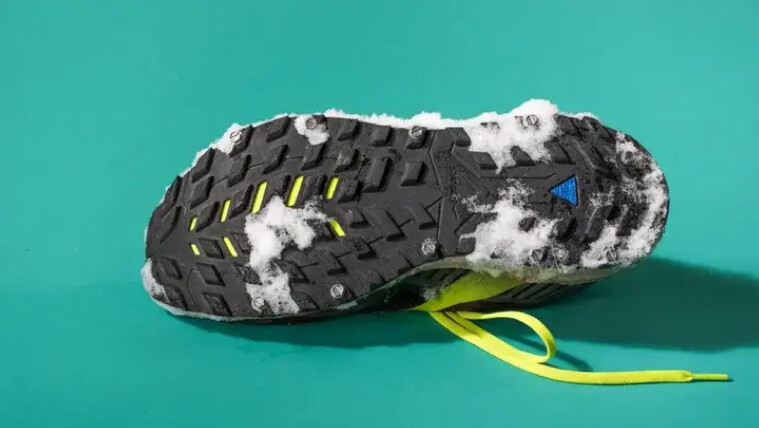

For about five dollars, you can modify your existing shoes for better traction on ice. An old pair of trainers can get a second life as your winter running shoes simply by inserting metal screws around the perimeter of the outsole to create custom spiked shoes.
How to screw spikes into your running shoes
Go to your local hardware store or home improvement center and buy a small box of -inch #6 hex head sheet metal screws (get at least 8 for each shoe).
Mark out where you'll insert the screws around the shoe. It's best to place them only in the perimeter of the shoe, even though some maximally cushioned shoes have a thick enough midsole that would keep them from poking the bottom of your feet.
Use a 1/16" diameter drill bit to drill starter holes for the screws, or start the process by pushing a nail or thick pin or needle into the first layer of the outsole.
Once the screw is started, use a (powered or manual) screwdriver to submerge the screw into the shoe so the flange is flush with the outsole.
For more aggressive traction, consider getting an Ice Spike kit for about $20-$25, or a La Sportiva Hobnails kit for $59.
It's important to note that none of these DIY options are perfect solutions for everyday winter running, because those screws can fall out or get torn out. But they can usually get you through the season, and that's all most runners really need. However, if you're looking for a hardier solution, try getting a pair of dedicated winter running shoes.
Over Spikes for Winter Running
Like snow chains for your car, after-market over spikes pull over your shoes for better grip. Winter running spikes offer improved traction, though they can feel slighty awkward under your feet, especially on harder surfaces. That's because there is a bit of a disruption of the foot-to-ground proprioceptive connection.
The Yaktrax Pro ($35) is best for running on snowy roads. It provides traction from metal wire coiled around a stretchy elastomer frame that criss-crosses the bottom of the shoe.
Black Diamond's Distance Spike ($99) is great on snowy roads or trails. The spikes are essentially a running-specific crampon device that includes a series of five aggressive metal claws connected by a small metal chain under the shoe and an elastic rubberized frame that is secured over the top of the shoe.
If deeper snow is on the way, try Kahtoola MICROspikes ($75). Almost identical to the Black Diamond product, the Kahtoola MICROspikes are slightly beefier and heavier. Kahtoola also makes a multi-purpose EXOspikes ($63) and a favorite for hard-packed snow, Kahtoola NANOspikes ($50). The Kahtoolas are the best models we've tested, but each is slightly different in its design, so research carefully to identify the best winter running spikes for the conditions you're facing.
Winter Running Shoes for Snow and Ice
Dedicated spiked shoes are best for runners who often find themselves on icy and snowy roads, bike paths and trails. They may be overkill for standard trail usage, however. Though they'll run pretty well on mostly dirt trails, these winter spiked shoes can actually be slippery on trails with a lot of rocks.
There are a few brands that make these specialty winter running shoes, with some of the top models being the Norda 001 G+ Spike ($270), Salomon Spikecross 5 Gore-Tex ($185) and IceBug Pytho6 ($190).
Each of those are rugged trail running shoes that have been enhanced with traction from tiny, carbide tipped metal spikes embedded in the outsole. They're moderately expensive, but if you're only running in them 25 to 50 times every winter, they'll definitely last for many seasons.
(02/26/2023) ⚡AMPby Trail Runner Magazine
Napoli City Half Marathon recap
Napoli City Half Marathon
To the Ethiopian world champion Edris and the Polish Mach the highest step on the podium of the 10th Napoli City Half Marathon
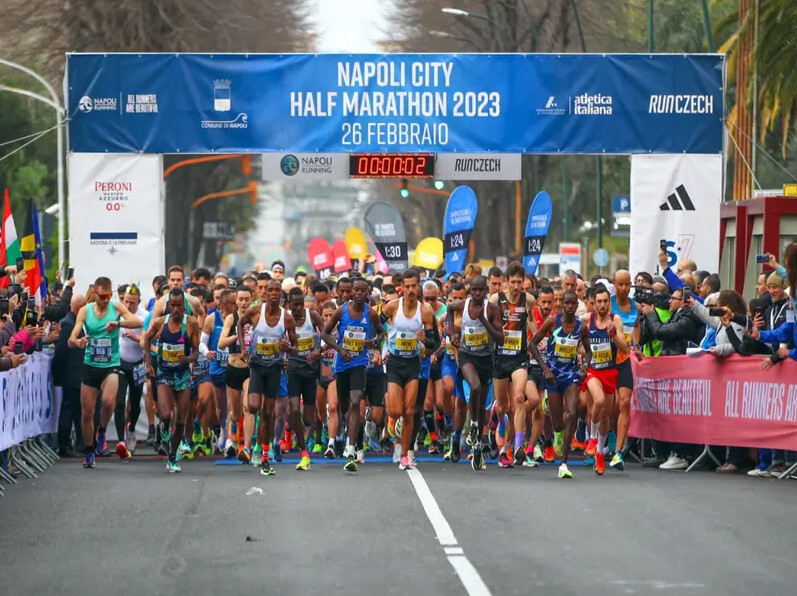
The climate did not betray expectations, it was a perfect day for the almost 5 thousand athletes engaged in the 10th Napoli City Half Marathon that highlighted the beauties of the city even more. From the charm of the Caracciolo seafront with the backdrop of Vesuvius and Capri to the passage on the very fast Corso Umberto before skirting the Maschio Angioino and returning to the finish line at the Sport Expo at the Mostra d'Oltremare, the logistics venue of the event.
In the middle of the fun and the spectacle for everyone there is also the real race, that of the big names who here at the Napoli City Half Marathon came to write their own in the golden register.
MEN'S RACE – Race that immediately decreed the winners who were at a 2’57” pace up to the 10th km, a trio consisting of the Ethiopian Muktar Edris, the Frenchman Mehdi Frére and the Kenyan Dennis Kibet Kitiyo. World champion Edris' first attack at the passage of the 13th km where Kitiyo passed with 23” delay leaving Frére to deal with Edris who did not disregard the anticipations. Confirmed, in fact, the victory of the Ethiopian Edris who cuts the finish line in 1h00’27” (2’51”/km) with a 16” advantage over the Frenchman Mehdi Frére, second in 1h00’43”. More detached the Kenyan Kitiyo who closes his work in 1h02’31” improving last year’s ninth position.
Even in the race of the Azzurri the positions were immediately frozen with Nekagenet Crippa (CS Army) who immediately ran for the highest step of the Italian podium, a goal centered with the time of 1h03’00” (2’59”/km) that earned him the sixth absolute position. They competed shoulder to shoulder up to the 13th km Stefano La Rosa (CS Carabinieri), Giuseppe Gerratana (CS Aeronautica Militare) and, slightly more detached, Xavier Chevrier (Atl. Valli Bergamasche Leffe). The Rosa then amounted a slightly higher pace that earned him the finish line in 1h04’35” with a few seconds in advance on Gerratana who with in 1h04’48 completes the blue podium.
“I am very pleased with the route I am doing being full load of miles for the marathon. I missed the final a little and I also suffered the wind. Now I still have three weeks before the Acea Run Rome The Marathon on March 19 and I am sure that my coach Piero Incalza will lead me to be ready for that date,” said Nekagenet Crippa, first Italian.
WOMEN'S RACE - The women's race was more eventful with the Bulgarian Militsa Mircheva who immediately put herself in the lead passing at the 10th km in 33’31" (3'21" / km) with a detachment of 14" on the pursuers, made up of the blue Anna Arnaudo (Battaglio CUS Torino Atl) and Rebecca Gear change at the 13th km where the Mircheva is tallonata by the Mach and at only 3” resists the Lonedo. The race ignites but to pop it up, with only one second of advantage, it is Mach who cut the finish line in 1h12’34” (3’26”/km) tallonata by Mircheva, second in 1h12’35” after a compelling final sprint. Third overall and first Italian Rebecca Lonedo (GS Fiamme Oro Padova) in 1h14’05” immediately followed by Federica Sugamiele (Caivano Runners) in 1h14’10”. More detached is the other blue Anna Arnaudo (Battaglio CUS Torino Atl) who closes the Italian podium with the time of 1h15’02".
“I really liked the route and also the result, even though the stopwatch didn’t satisfy me. I come from a training period in South Africa where I trained well, now I point at the Stramilano and then at the Italian Championships 10000m", said Rebecca Lonedo, first Italian on the podium.
"We are very pleased with how the event took place’ – said the President of Napoli Running Carlo Capalbo. “Naple presented itself dressed in an extraordinary light, and I am not referring to its beauty but to the fact that the people took to the streets and opened their hearts warmly hugging almost 5 thousand runners, this is the measure of our success. We will grow more and more, we will continue from here to look at the Naples that is projected among the world capitals of podiums," he added. ‘I thank everyone who ran, applauded, worked on this event, especially the volunteers who manage an immense amount of work, always with a smile,’ he concluded.
“We are really happy, we had a greater turnout than last year, this means that Naples is ready to grow more and more. The city responded positively, so many people were on the way to support the athletes, it is nice to give the whole world an image of sporty Naples, inclusive Naples - said the Sports Councillor Emanuela Ferrante -. We hope to have more and more participants and an even faster path that can still give us the glory of a new record.”
(02/26/2023) ⚡AMP
Napoli City Half Marathon
The Napoli City Half Marathon is the most growing running event in Italy. The race, certified by IAAF / AIMS/ European Athletics, is held inoptimal conditions with an average temperature of 10 ° C. From thewaterfront to the Castel dell'Ovo, the Teatro San Carlo to the Piazzadel Plebiscito, the course will lead you through the most fascinatingareas of the city,...
more...10th edition of the 10k FACSA Castelló report
This morning the tenth edition of the 10k FACSA Castelló race was held, in which the presence of elite athletes and the interest of international runners in visiting the city and improving their times stood out. The test has started at 9:00 am and has had a high density of participants who have achieved times under 28 minutes.
The Kenyan athlete Hillary Kiproech has been the first to cross the finish line with an impressive mark of 27:23, although she has not managed to surpass the test record reached in 2022 by Ronald Kwemoi (27:16).The podium was completed by Patrick Kabirech, also a Kenyan, in second place, with a time of 27:26, advancing practically together throughout the race, and Kenyan David Kimaiyo in third place, with the same time of 27:26.
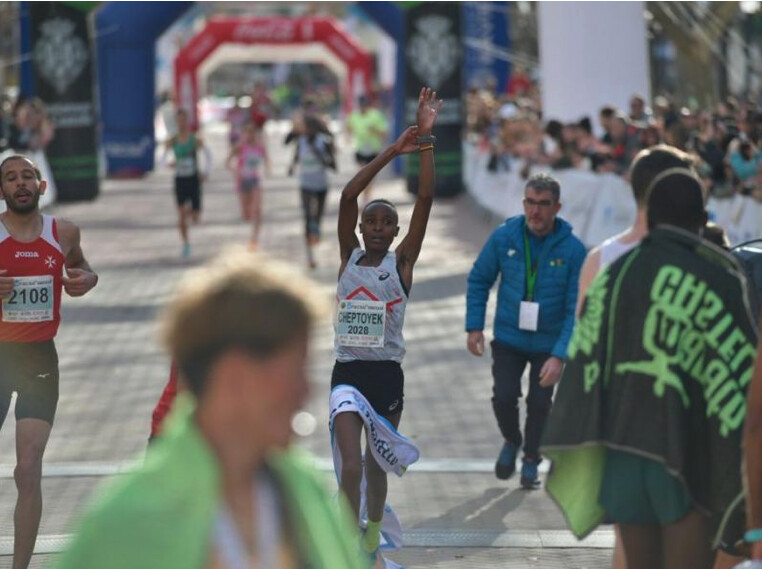
As for the men's category, it should be noted that the German record has been broken thanks to Amanal Petros, fourth classified, with a time of 27:32.In the women's category, the Ugandan athlete Joy Cheptoyek has managed to stop the clock at 30:50, but she has not been able to surpass the record time of Yalemzerf Yahualaw, who set the world record last year (29:14) and therefore , the test record.
The second classified was the Kenyan Edith Jepchumba, with a time of 30:53, and in third place was the Japanese Rino Goshima, stopping the clock at 30:55 and thus establishing a new Japanese record.
Regarding the regional classification of this edition, the winners in the men's category have been Rubén Belloví (30:55), Pablo Alba (30:59) and Guillem Segura (31:04), while in the women's category they have been Vanessa Romero (35:07), Bárbara Ramón (35:31) and Carmen Amaro (37:45).
As for the athletes from Castellón, those who have climbed to the podium are Rubén Belloví (30:55) and Pablo Alba (30:59), and in third place, Alejandro Benages (32:26), while in the female category, the first three positions have been occupied by Nuria Conejos (38:41), Patricia Cabedo (39:58) and Lorena Martínez (40:27).
It is important to note that in this edition, the 10k FACSA Castelló has achieved international recognition, the World Athletics Road Race Label, like its older sister, the bp Castelló marathon, which has revalidated it. Both races are a worldwide benchmark and have attracted more than 3,100 athletes in this edition.
The excellent results obtained in recent years are largely a consequence of the redesign of a circuit that is increasingly faster, straighter and flatter. These results reflect the upward trajectory of the sporting event.
(02/26/2023) ⚡AMP10k Facsa Castello
The 10K FACSA Castelló is one of Spain’s fastest and most prestigious road races, drawing elite and amateur runners from around the world. Held in Castellón de la Plana, this race has grown exponentially, earning a reputation for its flat, high-speed course and exceptional organization. It holds a World Athletics Road Race Label, placing it among the top road races...
more...A Record-Breaking Day at the Osaka Marathon
With five 180˚ turnaround points and serious hills in its last 12 km the Osaka Marathon course isn't the fastest around, but that didn't hold back record-breaking runs in both the women's and men's races. Great conditions, 5˚~7˚C, light clouds and very light winds definitely helped.
The women's race went steadily on 2:22 pace, an early group of six shaking down to just four, Japan's Momoko Watanabe (Tenmaya), favorite Vivian Kiplagat (Kenya) and Ethiopian duo Helen Bekele Tola and Beyenu Degefa, by 30 km with Australian a few seconds behind. Bekele made the winning break, pulling away to win in a course record 2:22:16. Watanabe, who came into the race with a best of only 2:30:42 PB, led Degefa in the home straight but lost out in the last kick. Degefa was 2nd in 2:23:07 and Watanabe 2:23:08 for 3rd, clearing the 2:24:00 auto-qualifying standard for MGC Race Olympic marathon trials qualification.
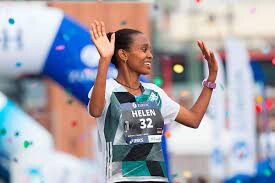
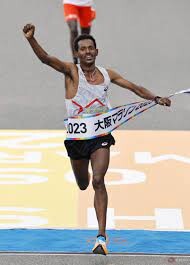
Only getting faster with age, the 43-year-old Weightman ran Kiplagat down for 4th in 2:23:15, beating her PB from last fall's Berlin Marathon by 45 seconds. Weightman is also entered to run next weekend's Tokyo Marathon. Misaki Nishida (Edion) and Yuri Karasawa (Kyudenko) also caught Kiplagat, Nishida taking 5th in a PB 2:25:51 to qualify for the Olympic trials and Karasawa running 2:27:27 in her debut but missing qualification by 27 seconds. The pre-race favorite, Kiplagat fell to 7th in 2:28:44.
The shinkansen effect was in full effect in the equally well-paced men's race, a quartet led by Tomoki Ota (Toyota) running with almost zero variation through 25 km in 1:15:00 and pulling along a pack of almost 50. After Ota stopped at 25 km the pacing over the next 5 km was a bit shakier, but after hitting 30 km in 1:30:13 and the remaining pacers dropping out Eritrean Merhawi Kesete initiated a series of attacks that saw six different athletes take the lead over the hilliest section of the course. Among them was former Toyo University Hakone Ekiden star Kazuya Nishiyama (Toyota), who made moves to the front twice while on 2:06 pace in his debut.
With 5 km to go Ugandan Victor Kiplangat threw off his hat and surged, pulling South African Stephen Mokoka, Tanzanian Alphonce Felix Simbu and #1-ranked Ethiopian Hailemaryam Kiros with him. Behind them a chase trio of Nishiyama and fellow first-timers Charles Kamau (NTN) and Yohei Ikeda(Kao) congealed, all three of them sub-61 half marathoners and on the cusp of hanging on to a 2:06 debut. Kiplangat, 2:05:09 in Hamburg last fall, did all the work up front, shaking off Mokoka and Simbu but unable to get rid of 2:04:41 man Kiros.
With just 200 m to go Kiros surged, taking the win in a 2:06:01 CR with Kiplangat just 2 seconds back. Simbu was 3rd in 2:06:19, but behind him Kamau closed hard to run down Mokoka for 4th, 2:06:37 in his debut to the veteran Mokoka's 2:06:42. Mokoka had a near-miss on the South African NR, finishing just 9 seconds off Gert Thys' 2:06:33 at the 1999 Tokyo International Marathon.
Both only 24 years old, Nishiyama and the Toshinari Takaoka-coached Ikeda were next in 2:06:45 and 2:06:53, each of them well under the old debut marathon NR of 2:07:31 set by last year's Osaka winner Gaku Hoshi. With Nishiyama having dominated Hakone's First Stage at Toyo and Ikeda having been the top Japanese finisher on its most competitive stage his fourth year the relationship between Hakone success and later marathon performance is clearer than ever. 2021 Olympic team alternate Shohei Otsuka (Kyudenko), another Hakone stage winner, closed hard to take 8th in 2:06:57 and make it three Japanese men under 2:07.
Already qualified for the Olympic marathon trials after a 2:11:41 debut for 2nd at August's Hokkaido Marathon, Yugo Kashiwa (Toyo Univ.) ran the 2nd-fastest collegiate time ever, 2:08:11, for 20th. Like Mokoka, Mongolian Jamsran Olonbayar came painfully short of the Mongolian NR, missing Ser-Od Bat-Ochir's 2:08:50 record by just 8 seconds at 2:08:58 for 29th. Tokyo Olympian Yuma Hattori (Toyota) had his best race since the 2019 trials, finishing 34th in 2:09:47, but will have to try again before the end-of-May deadline to hit a trials qualifier. Further back, visually-impaired T11 WR holder Shinya Wada broke his own best with a new world record of 2:24:29.
Including Nishiyama and Ikeda a total of nine men qualified for October's MGC Race Olympic marathon trials, along with Watanabe and Nishida in the women's race. The top 18 went under 2:08 and top 29 under 2:09, both bettering the numbers at the legendary 2021 Lake Biwa Marathon where 15 men were sub-2:08 and 28 sub-2:09. But this year's Osaka came up short of Lake Biwa's depth further down, with only 35 men sub-2:10 versus 42 at Lake Biwa. But with over 50 men on the entry list at Tokyo next week having run sub-2:10 in the last three years the stage is set for something even wilder there.
(02/26/2023) ⚡AMPby Brett Larner, Japan Running News
Osaka Marathon
Let’s run for fun in the shadow of Osaka Castle, the symbol of the city!This is a fun running event, which welcomes international runners from all corners of the global alongside families, friends and Japanese runners; all running together through the colored leaves of Osaka Castle Park on a crisp autumn morning. The fun and pleasure of running is universal! ...
more...Runners set world, state records at Publix Atlanta Marathon
ATLANTA — With nearly 8,000 participants, world and state records were set in the Publix Atlanta Marathon weekend. From distances of 50 meters to 26.2 miles, runners of all ages shattered records.
On Sunday, during the half marathon, Kenyans Nicholas Kosimbei and Dorcas Tuitoek made history. Kosimbei ran the fastest half marathon ever in Georgia shattering the previous mark of 1:03:59 and finishing more than two minutes ahead of his nearest rival with a time of 1:00:36.Tuitoek also shattered the record with a time of 1:08:22 in the women's half marathon race just seven seconds under the Georgia state record set by Molly Seidel last year, who went on to win a bronze medal in the Olympic Games marathon.
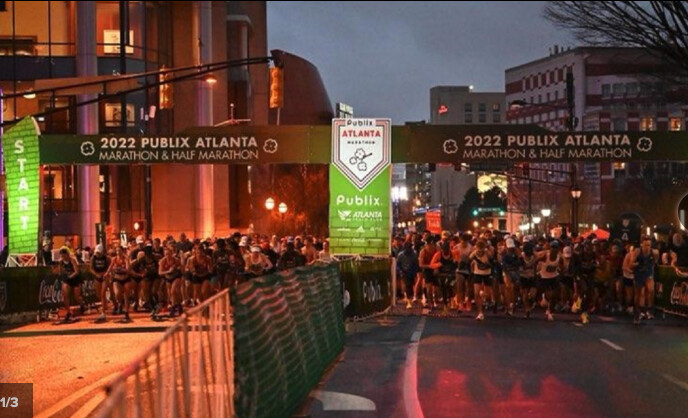
Additionally, Matt McDonald of Cambridge, Massachusetts, finished 6th overall in the half marathon at 1:05:32 and Dakotah Lindwurm of Eagan, Minnesota, finished with a time of 1:12:27. Chris Nasser of Atlanta won the Push Assist Division at 1:17:14.
“It’s fun to run by so many of my old spots,” McDonald said. “Almost every mile, I had some memory of some good time in that neighborhood, whether it was Georgia Tech where I did my Ph.D. or Piedmont Park where I did all my workouts.”
Shlomo Fishman of Silver Spring, Maryland, finished in 1st place in the Atlanta Publix Marathon with a time of 2:37:32.
“At Mile 18, I just decided I needed to get out of the rain,” Fishman said, who ran a personal best in his first marathon victory. “So, I picked it up a little bit and just went for it.”
In the women's marathon race, Amanda Furrer of Bethlehem, Pennsylvania, finished in 1st place with a time of 3:02:47, despite starting in Wave C, eight minutes behind the first non-elite runners. “I was alone for a while, so the cyclist on the course just started telling everyone my name. So people kept cheering for me. It was awesome!” Furrer said.
On Saturday, the 5K was won by Luke Mortensen, 39, of Athens, at 16:11 and Ellen Flood, 24, of Atlanta, at 17:25. Flood is also a former Georgia Tech runner.
Atlanta Track Club also hosted the USATF 5km Masters Championships, with 225 athletes ages 40 and over competing for both overall and age-group titles. Bryan Lindsey, 41, of Zionsville, Indiana, and Jessica Hruska, also 41, of Dubuque, Iowa won the overall titles. A world record was set by 97-year-old Betty Lindberg of Atlanta, a legend of the Atlanta Track Club. Her time of 55:48 set a world age-group record winning her 95+ division and destroying the previous mark by more than 30 minutes.
The 3K Atlanta Publix Kids Marathon was won by 13-year-old Nuriel Shimoni Stoil of Atlanta and 14-year-old Valeria Zambrano of Marietta.
(02/26/2023) ⚡AMPPublix Georgia Marathon
The Publix Georgia Marathon & Half Marathon is the perfect opportunity to visit the city of Atlanta. Atlanta's ONLY marathon, the event is a must do for adventure marathoners looking to cover all 50 states. A true Southeast tradition, you'll experience the spirit of the city as you travel through four college campuses, ten welcoming neighborhoods and dozens of iconic...
more...Smash your spring 5K with this 15/30 interval session
With the spring racing season around the corner, there are less than six weeks to squeeze in speed workouts before race day. If you’re training for a 5K, there’s no better way to prepare yourself to run fast than adding short fartlek interval sessions to your training regimen.
Fartlek (interval) training involves frequent changes in speed and effort, where the total distance and time are structured or random to get you comfortable with a range of paces.
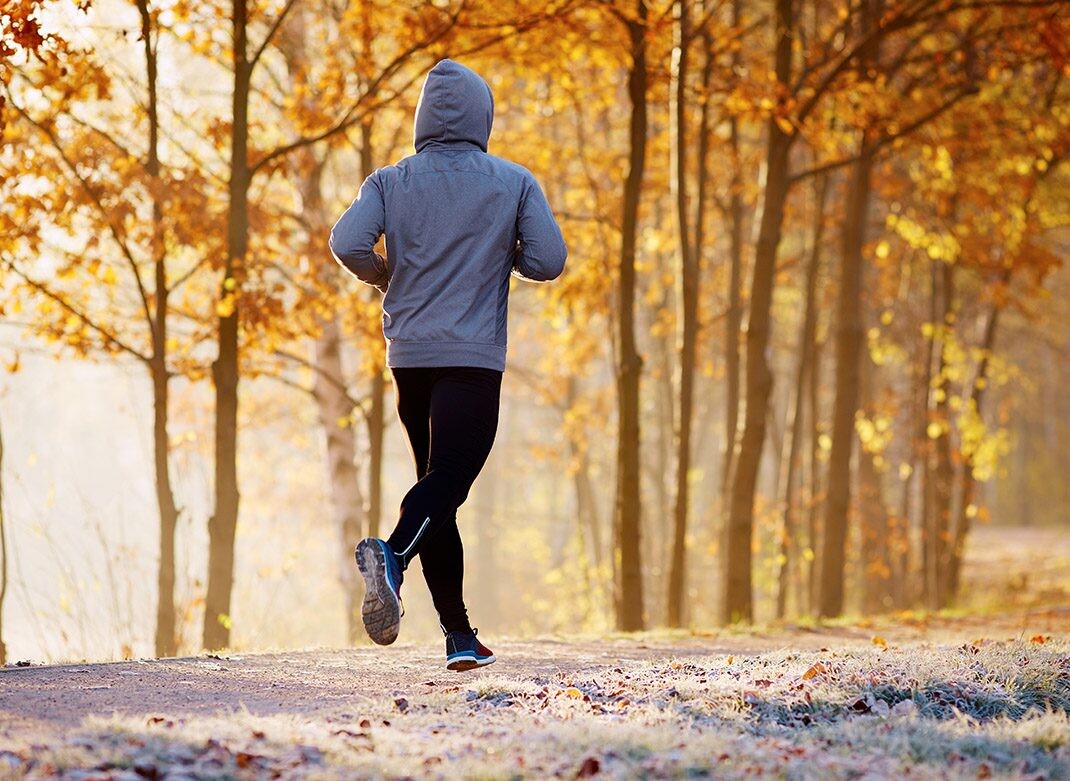
Short interval sessions are great for runners training for a 5K, or generally looking to improve their speed and racing tactics. The constant change of pace simulates the ups and downs of a 5K or mid-distance track race, helping you get comfortable with changing speeds on a dime.
The workout
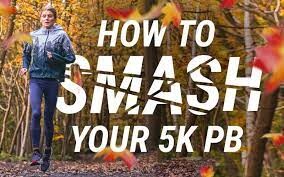
15 to 20 reps of 15 seconds fast, 30 seconds float jog (continuous)
Each 15-second rep should be done at a comfortably-fast pace (at 5K pace or faster)—and the 30-second float should be done at a half marathon/marathon pace, a little faster than you would do easy runs.
The purpose of this workout is to train your body to become more familiar with faster paces on shorter, faster recovery. If training for your first 5K, aim for 15 reps and make sure you start slow. If you need to walk between reps, it’s a sign that you are pushing too hard during the 15-fast or 30-float.
An experienced 5K runner should aim for between 20 and 25 reps to simulate the pace changes of the race. Another great thing about this workout is that it can be done on any surface (road, track or trail), or the treadmill.
Adding one or two fartlek interval workouts to your weekly training regimen will quickly improve your speed and endurance, helping prepare your body and mind for faster efforts on race day.
(02/25/2023) ⚡AMPby Marley Dickinson
Cam Levins has signed with Asics
It is official–Canada’s fastest marathoner, Cam Levins, has signed a sponsorship deal with the Japanese sporting brand Asics.
The 2:07 marathoner spent the entire 2022 season unsponsored, after leaving Hoka in late-2021. His fourth-place finish in the men’s marathon at the 2022 World Athletics Championships was the highest finish by a Canadian in the men’s marathon at a major championship in the IAAF/World Athletics era.
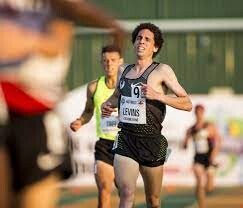
Levins’s time of 2:07:09 shattered his previous Canadian marathon record of 2:09:25 from the 2018 Toronto Waterfront Marathon.
The 33-year-old continued his string of solid performances earlier this month when he smashed the Canadian half marathon record by 42 seconds at the Vancouver First Half, running 60:18. This was the first time a Canadian runner has gone under the 61-minute mark over 21.1 kilometers.
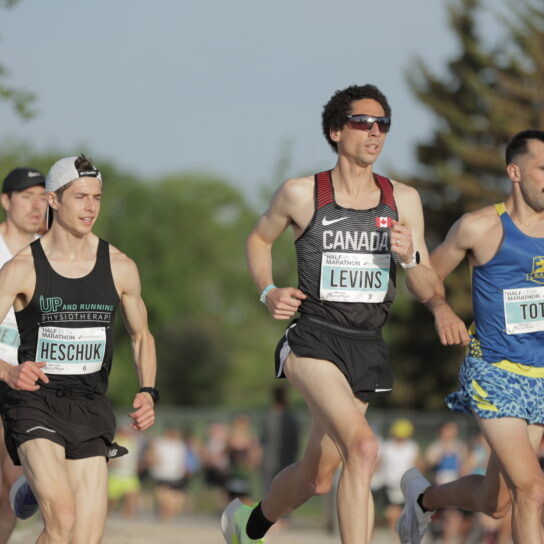
Levins is on the elite list for the 2023 Tokyo Marathon on March 5, and indicated to Kate Van Buskirk on Canadian Running’s The Shakeout Podcast that he’s “ready for something really special there.”
“I am excited to head back to Japan for another opportunity to compete in a major marathon,” Levins said on Instagram.
The last time Levins was in Japan, it was for the 2020 Olympic marathon in Sapporo, where he ended up finishing a disappointing 72nd. “The Olympics were a low point for me,” Levins said in an August 2022 interview. “I felt I was right there, but I realized I was so far behind the best in the world.”
The men’s field for Tokyo features nine sub-2:05 runners, including 2022 Amsterdam champion Tsegay Getachew; London 2021 champion Sisay Lemma and his former training partner and Japanese 5,000m (and formerly, marathon) record holder, Suguru Osako.
Levins currently lives and trains in the Portland, Ore. area, and is coached by Victoria’s Jim Finlayson.
(02/25/2023) ⚡AMP
by Marley Dickinson
5 one-liners to use on runners
Runners are complex individuals. One of the best ways to get to know a runner you’d like to date is by doing the thing they love with them. But how do you break the ice? There are plenty of cheesy running lines out there, but you need to make sure your icebreaker is 1) clever, and 2) effective.
If you are on dating apps, it’s easy to get excited when you come across someone who shares your hobby. Asking a runner, “What are you training for?” or “What’s your Strava?” can seem too forward. Instead, try any of these running-inspired one-liners to spark your sense of humour and showcase your knowledge of the sport.
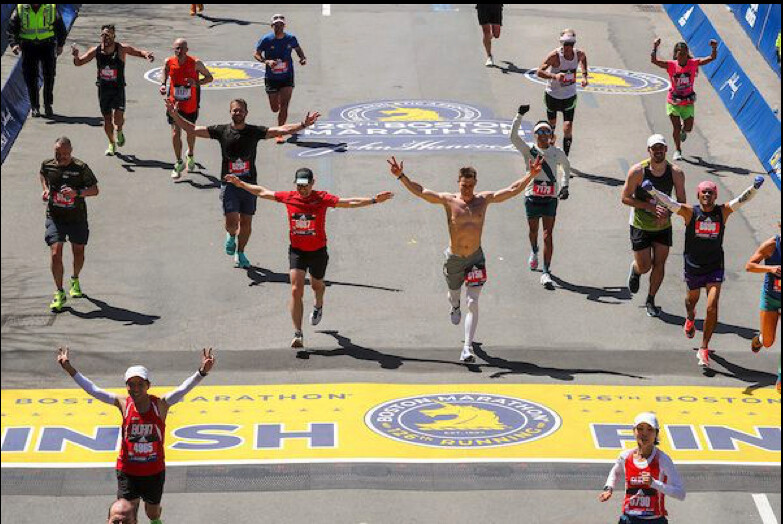
Is your middle name Garmin? Because you make my heart race!
Simple. Witty. What more could you ask?
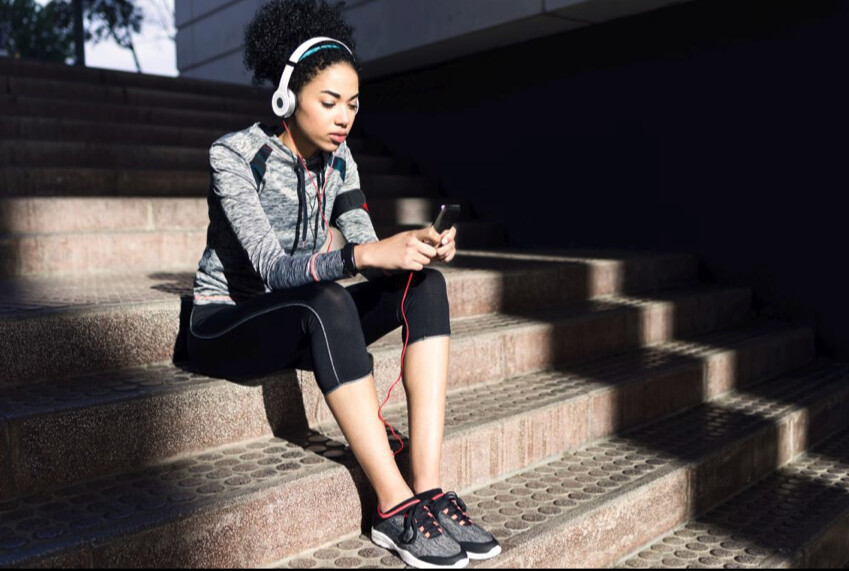
Roses are red, violets are blue. Do you mind if I come on a run with you?
Who doesn’t love a good rhyme–or a running partner? According to Women’s Health, any fitness challenge between two parties is great for emotional bonding, attraction and motivation. Plus, you get to help each other chase training goals.
Is this a speed workout? Because you just took my breath away!
It might be a bit on the cheesy side, but in our eyes, it’s a 10.
You must be a marathoner, because you’ve been running through my mind all day!
This line could also work on ultrarunners–but they’re likely still out there.
Your PB isn’t the only number I’m interested in.
A personal best can last a year or two, but nowadays, a phone number can last forever… unless they change it.
(02/25/2023) ⚡AMPby Running Magazine
These Phrases May Be a Tipoff for Poor Mental Health in Athletes
New research finds that your self-talk could be an indication of emotional challenges.
A recent study published in the journal Psychology of Sport and Exercise found a connection between athletes with internal irrational beliefs, as shown by negative self-talk, and increased anxiety and depressive symptoms.
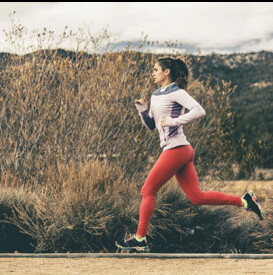
Negative thoughts about sport can also become habitual, which can hinder self-confidence and lead to other mental health struggles.
Experts offer ways for runners to address these negative thought patterns.
Ample research has connected regular exercise with mental health benefits—for example, a study in The Lancet notes that those who work out consistently had fewer days of poor mental health compared to those who don't exercise. However, that doesn’t mean athletes are immune to emotional difficulties.
New research published in the journal Psychology of Sport and Exercise suggests athletes may have unique stressors, including concern about injury risk and anxiety about competitions. To determine how issues like these affect self-confidence, researchers looked at more than 400 athletes across a variety of sports, including a breadth of ages and experience levels.
They found that athletes’ belief systems, and especially beliefs that seemed irrational, were connected to lower self-confidence with increased incidence of anxiety and depressive symptoms. Researchers identified these beliefs through phrases such as “others think I’m not good at what I do, that shows I’m worthless,” or “my position on this team isn’t secure,” or “I’ll never make it.”
When negative self-talk like this becomes habitual, it creates a foundation of self-doubt that skews more thoughts in a negative direction, according to lead author Paul Mansell, Ph.D.(c), researcher at the school of sport, exercise, and rehabilitation sciences at the University of Birmingham in the U.K.
“This creates a maladaptive thought process that begins with irrational beliefs and leads to automatic, negative thoughts that may undermine an athlete’s self-confidence,” he told Runner's World. “This can lead to psychological distress and depression symptoms.”
Becoming more aware of these thoughts can be a step toward identifying mental health challenges, he added. Being able to pivot toward a more rational, self-supportive stream of thoughts can not only be protective in terms of reducing anxiety and depression risk, it can also give an athlete a stronger sense of control, said Mansell.
One starting point to address these thoughts: Envision all the resources available to you—teammates, trainer, coach, therapist, friends, family, and so on—that help you cope with the demands of stressful situations.
It’s also helpful to remember that more positive small talk may actually change your brain chemistry, according to Loretta Graziano Breuning, Ph.D., author of Habits of a Happy Brain. Although she wasn't involved in the recent research, Breuning has studied the way negative self-talk affects hormone regulation.
“When people default to negative thinking, that can increase your level of cortisol, the hormone responsible for stress response,” she told Runner's World. “When cortisol increases, it lowers hormones related to calmness and joy, like dopamine and serotonin. Over time, this becomes an automatic response.”
The mind gets into patterns, she added, and it does take effort to shift in a different direction. She suggested writing down thoughts centering around your exercise or competition performance, because seeing them in such a concrete form can be surprising.
“In many cases, people may not realize how negative they’ve become until it’s right there in front of them,” said Breuning. “Consciously and deliberately changing the way you talk to yourself is an important step not just for your sports performance, but also for your mental health overall.”
(02/25/2023) ⚡AMPby Runner’s World
Hellah Sidibe Runs Frustration into the Ground
The former soccer phenom was burnt out and angry. Then he started running every day, no matter what.
Hellah Sidibe shared his story with producer Sarah Vitak for an episode of The Daily Rally podcast. It was edited for length and clarity.
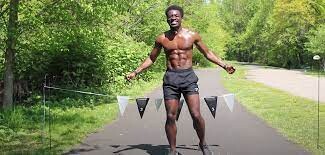
I went into this dark area in life where I was just mad. Why is this happening to me?
It all came down to, all right, I’m pissed at everything, but let me stop making excuses. Just look at myself, and just deal with what I can handle, what I’m in control of. That’s how it started.
My full name is Hellah Sidibe, but I have a nickname: Hellah Good. I got that nickname back in college. I played Division I soccer. Every time I would take the ball and start sprinting down the line, they’d just say, oh, he’s Hellah good.
Growing up in Mali, West Africa, soccer was the number one sport. We just loved playing, and we loved watching the top players on TV. We were trying to play like them: we were trying to score goals and celebrate the way they do.
We lived in an area where there’s dirt, so we would use our feet to trace and make marks. You would literally make the whole soccer field. In order to still see the line, we would go into our kitchens. When we make food, we make food with wood and charcoal. Everybody would fill that up in a can from their house and bring it to the field. The path that we created with our feet, we’d spray that chalky gray-white powder along those lines so it looked like the white soccer lines.
We’d pick teams. Say: you’re Brazil, you’re Argentina. We’d always take the South American teams because they were the best in the world at the time, when I was young. We would pick players, and we would be like, you’re Thierry Henry, you’re Luís Figo. I’d say, I’m Ronaldo Nazário. Sometimes you’d just paint their numbers on your back, on your bare skin.
We would recruit our own team within the neighborhood. The next neighborhood was within a five-minute walk, and we’d go play them. Their neighborhood we would call allez, which is away. And there was no pressure. We did it because we wanted to, and no one was yelling at us.
When I came to the U.S., it got a little competitive. There started being consequences. If you didn’t do something right, the punishment was: let’s make you run. So I got to college, and it added more to that because I was playing under a coach. His mindset was that we might not be the most skillful team in the country, but we’re gonna be the fittest team in the country. It was to a point in that sometimes the track team would joke around and say, are you guys with the UMass track team or the soccer team? Because whenever they went by the field, they’d see us just huffing and puffing.
So I started hating running. I would cramp up in my calves, my lungs would be burning, and my hamstrings would be on fire. I started having a fear of it. It wasn’t a fear where I hated the game, but it was fear of going to practice for that specific reason. You’re getting yelled at like it’s not enough, even though you feel like you’re giving your absolute best.
Out of almost 400 players, I was one of 20 picked up to face the US youth national team. All of those teams were after me: phone calls from teams, telling me, we want this player. We like his skillset. I was approached by Sporting Kansas City my senior year, and they were one of the top teams in the MLS and won the MLS Cup the year that I finished college.
I was told: you’re gonna get picked up in the draft.
There were domestic roster spots and international roster spot at the time. I don’t know if that’s changed; I haven’t really looked into it. It was the rule that only eight international players could be picked up per team, and the rest had to be domestic players.
The assistant coach at Sporting Kansas City was like, hey Hellah, I’m sorry to tell you this, but the reality is right now. We’d rather have a young player that is a U.S. citizen that’s not as talented as you, but we can develop them and we don’t have to worry about the paperwork side of it. But also we can pick up a big European player that can sell jerseys and tickets that can take the spot. Versus, I’m somebody who hasn’t made a name for himself.
He was just telling me the reality. It wasn’t even his decision.
Just seeing that—it is frustrating, and it’s tough. Your goal is to play the game that you love, and it’s getting pulled away from you.
I just started hating everything. I’m not a doctor, but I do think there was some depression looking back. When you’re in that spot, nothing matters. Someone could smile at you or could even want to hug you, and you want nothing to do with that.
It was a looking-at-myself-in-a-mirror moment. What can you do with yourself right now? What are you in control of? I literally had that conversation with myself. Being an athlete, you always fall back on your physical ability because it makes you feel a certain way mentally. You like challenging yourself. You like competing on the field.
I was just like, what are you gonna do now? You tell yourself you’re going to go to the gym every day for a week, and you can’t even last three days. Do something, and hold yourself accountable for once. Be consistent.
So that is what led me in 2017 to when I said, what is a fear of mine that I wanna face? And running was the first thing that hit my mind.
It was a two-week goal of ten minutes a day within the first week. I didn’t care about distance. It was time. I would just start my watch, and then after ten minutes I’d be done, so I’d be just over a mile.
The ten-minute goal wasn’t because I couldn’t do more than ten minutes; it was just attainable. I just knew that it wasn’t so much where I was going to hate it.
That didn’t last more than a week. Even within the first week, I was going as far as four miles, which is way longer than ten minutes. But I would get lost in it. It wasn’t about pace or distance or anything. It was about just being out there in the present moment.
I ran every day for two weeks. And then I said, I don’t want to get ahead of myself, but I can see myself doing this for the rest of my life. Let me do it every day for a year.
And now we’re here, running every day for 1,989 consecutive days. About to hit 2,000 consecutive days. And running across the U.S., doing a hundred-mile race, and still loving it like day one.
When things aren’t necessarily working out in life, it does mean it’s the end of you. It just means that it’s preparing you for something even greater. You just have to focus on what you can control and keep putting one foot in front of the other. Right now, I would not trade this for anything. Nope, I would not.
Hellah Sidibe is a runner, speaker, and content creator. He has run for more than 2,000 consecutive days. In 2021, he ran across the United States. In September of 2022, he competed in the Leadville Trail 100 Ultra Marathon. You can learn more about him at hellahgood.com.
(02/25/2023) ⚡AMPby Outside On Line
I Cold Plunged Every Day For a Month—Here’s What I Learned
One yoga teacher immersed herself in freezing water for 31 days. Here's her advice for how you can do it, too.
For the month of January, Finocchiaro subjected herself to a daily cold plunge in the ocean and chronicled her efforts on TikTok. She had started practicing regular cold water immersions at the beginning of the pandemic, inspired by the Wim Hof method, as a way to help manage her seasonal depression. She saw her mental energy increase with each plunge.
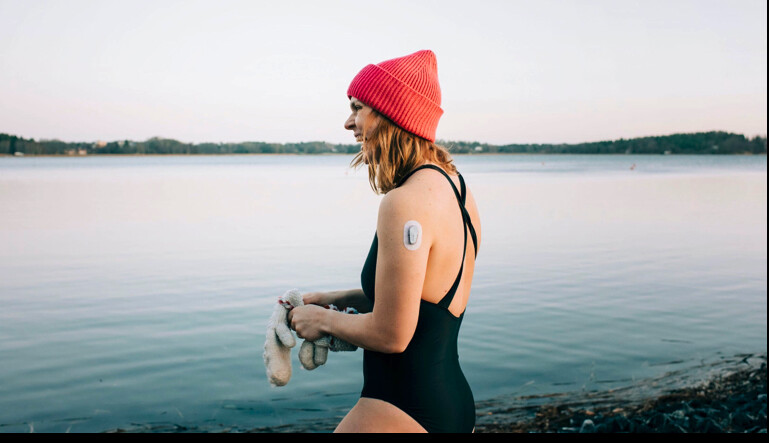
This winter, as a byproduct of her anxiety and the stress of being a small business owner, she saw her mood drop even more. “As soon as you turn your passion into your career, it’s not as easy to relax during a yoga class,” she says. “So, I’ve had to turn to other coping mechanisms for my anxiety and depression.”
In an attempt to better her mental health, Finocchiaro decided to embark on a monthlong challenge of doing a cold plunge every day. She headed to the ocean most early mornings for her immersion although sometimes squeezed her plunges in during the afternoon due to her work schedule. Once on the dock or sand, she would ditch her warm puffer jacket, strip down to a bathing suit, and wade into frigid waters.
For the yoga teacher and studio owner, it’s a part of her day when she’s focused on doing something for herself.
Her elevated mood kept her coming back to the water—even on the coldest days. “Once you’re done with a plunge, you have all this energy,” she says. “For me, it clears my mind and gives me the energy to get through the rest of the day.” Throughout the month of January, she found herself able to forego that afternoon cup of coffee, revitalized instead by her quick dip.
Chris Minson, a professor of human physiology at the University of Oregon, conducts research on thermoregulation—the impact that extreme heat and cold have on the body. While most of his studies focus on the benefits of heat, he says there’s some evidence that a euphoric feeling may follow an acute cold immersion. However, he says more research needs to be conducted on the topic in order to find out more about how long these feelings can last and the mechanisms behind them.
The impact of the freeze may go beyond that feeling of joy. In a new study that has yet to be released to the public, he and his team of researchers found that when looking at a positive-negative affect (i.e. how good you feel about things versus how bad you feel about things), people felt less negative following a brief cold water immersion, he says.
Not ready to subject yourself to a cold plunge? You may be able to reap similar benefits from extreme heat immersion, such as a sauna or hot tub. Evidence suggests that even one session of heat therapy a week reduces rates of depression, Minson says. Ultimately, it’s about find the right kind of temperature treatment for your body.
With her her month-long challenge behind her, Finocchiaro says she’ll still continue to regularly plunge, even if it isn’t every day. “I’m not trying to prove something,” she says. “For me, it’s about connecting to nature and getting outside even when it’s 30 degrees and snowing or raining. It’s about embracing the winter.”
It’s also about introducing others to the joy of cold immersion. During her monthlong commitment, she started leading community plunges with her students after her Saturday yoga class, a practice she plans to continue throughout the winter.
Cold plunging isn’t nearly as simple as a summer dip. Following are a few things to keep in mind if you’re thinking about heading out for an icy immersion.
Your front dive may be gorgeous, but you’ll want to forgo it when entering cold water. Minson says if you immediately immerse your head in freezing water, you’ll experience an instinctive “gasping response,” which causes you to try to breathe in a lot of air. When this occurs in deep water, the possibility of drowning increases. Instead, slowly wade into the water.
While you may be excited (or nervous!) for your cold immersion, Finocchiaro says it’s essential to remain calm in order to avoid hyperventilating. For her, that means moving into the water with presence and ease. “My first few times, I ran in and was so excited, but then I started hyperventilating and couldn’t get myself to calm down,” she says. She alleviated that by walking in slowly and mindfully, drawing on the very same breathwork that she teaches. A meditation practice can also be beneficial in grounding you in the present moment.
Finocchiaro recommends getting used to the concept of a freezing plunge by testing out a cold shower. Even just tacking on a few initial seconds of cold to the beginning or end of your daily rinse can help you acclimate to the frigid temperatures of a cold plunge. If you don’t have access to a body of water, a regular cold shower can also replace a plunge.
Minson encourages his students to try the cold shower challenge by foregoing the typical hot shower for an icy one. While many of the students stop taking the cold showers after the challenge, a few report that they continue for the sense of elation after the ritual.
Your cold plunge doesn’t have to be (and shouldn’t) be lengthy. Finocchiaro says she’ll typically stay in the water for no more than a minute or 90 seconds. It won’t take long for you to feel the affects.
(02/25/2023) ⚡AMPby Outside On Line
How to Achieve Your Running Goals? Become an Aerobic Monster.
OlympYou’re a busy person who wants to optimize every minute of training to achieve your goals.
I can help you. I’ve coached Olympians, national- and world-record holders, and national and NCAA champions. Each reached the pinnacle of the sport by making the most of the miles they ran while avoiding injury and burnout. To do that, you need to understand the demands racing requires of your body and train effectively to adapt your body to meet those demands.
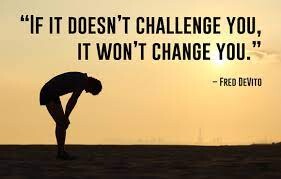
The races that most runners train for are almost entirely aerobic events. Yes, even the mile or the 5K. To succeed at those distances, you need to be able to sustain a hard pace for several minutes, and often for more than an hour.
You need to be an aerobic monster.
I like to explain this idea by talking about a common race goal. Many of the women I coached collegiately wanted to break 5:00 in the mile. I would ask: “Can you run 75 seconds for one lap of the track? Of course you can, pretty easily. How about 2:30 for two laps? Yes, but it’s starting to get hard. How about 3:45 for three laps? Now that’s getting really hard. Could you then run a fourth lap in less than 75 seconds? Almost certainly not right now.”My point was that a short segment at your desired race pace isn’t a big deal. (If it is, you probably need a less ambitious goal.) If a reasonable goal for you is to break 20:00 for the 5K, then running 400 meters in 1:36 or 800 meters in 3:12 won’t be a major strain. You have the basic speed to run that pace comfortably. It’s sustaining the pace that’s the challenge. Being able to do that requires training that builds your high-end aerobic capacity. That’s what I mean by being an aerobic monster.
So, what does this mean in practical terms? Mileage isn’t everything, but most runners will become stronger aerobically by carefully and gradually increasing the volume of running they can handle. Increasing your mileage from year to year while still being able to hit your times in workouts and races will improve your VO2 max (ability to pump a lot of blood to working muscles), lactate threshold (ability to clear lactate and therefore not have to slow), and running economy (amount of oxygen needed to hold a certain pace).
By “handle” mileage increases, I mean being able to run at something more than a crawl without getting hurt or worn down. A little extra soreness or tightness is common at a newly higher mileage. A sharp new pain, soreness, tightness that doesn’t go away once you’re warmed up, is a warning sign. Similarly, if your goal is to run 6:00-per-mile pace for a 10K, but you’re so tired from upping your mileage that you struggle to run a 6:00 mile in training, you’re overdoing it. And if you’re no longer a coherent person during the rest of your day, with no energy for your real-world responsibilities, you’re definitely running too much (says the guy who in college studied standing up because he would fall asleep immediately if he read sitting down).
But there’s more to being an aerobic monster than simply how much you run. Take two runners who average 40 miles per week. One might run almost the same distance every day at about the same medium-effort pace. He’ll be a decent aerobic athlete. Another’s week might include a long run, a tempo run, and some shorter recovery days. She’ll be an aerobic monster.
Long runs and tempo runs are key to building your ability to hold a strong pace. I’d much rather have you run 12 miles on Sunday and four miles on Monday than eight miles each day. Tempo runs are especially effective at raising your lactate threshold, the point at which your effort goes from aerobic to anaerobic, causing you to slow in the next few minutes if you tried to keep holding a given pace. A steady diet of tempo runs will make you able to run aerobically at a faster pace and will lengthen the time you can hold that faster pace. A bonus: As you become more of an aerobic monster, your everyday runs will get faster at the same effort level, leading to that much more of a training effect.
To get an idea of what this all means in practice, consider the training of Heather MacLean, an Olympian I coach who was ranked ninth in the world in 2022 at 1500 meters.
Heather’s longest race lasts just four minutes. Yet much of her training before her peak racing season could be confused for that of a 5K or 10K specialist. For most of the year, she does a weekly long run and regular tempo workouts. Why? Because the same principle that was true for the collegiate runners who wanted to break 5:00 for the mile is true for Heather to break 4:00 for 1500 meters. (Her best is 3:58.)
The average pace to do so—64 seconds per 400 meters—isn’t a challenge for her to hold for one lap. What she needs is the ability to run the first three laps of the three-and-three-quarter-lap race aerobically, so that she can sprint against the best in the world in the final 300 meters. How did she get there? In large part, not by running all-out 400-meter repeats twice a week, but by the steady accumulation of long runs and tempo runs for months on end.In a typical year, one of Heather’s main targets is the outdoor U.S. championship in late June or early July. On that schedule, it’s only in April and May that her workouts start to look more like what you might expect for a world-class miler. But even then, she still does a good long run most weeks, and many of her track workouts include long repeats at 5K race pace. If she doesn’t have a tune-up race in a given week, she’ll usually do a tempo run. All of these elements preserve the aerobic monster status she built in the previous several months
You’ll know you’re becoming an aerobic monster when your training starts feeling more doable. You’ll find you’re finishing your long runs at a good pace, rather than hanging on and hoping they’ll end soon. On hard sessions, you’ll definitely be working hard, but you’ll feel stronger while doing so, and you’ll recover more quickly between repeats. You’ll simply feel more capable than before; any given run won’t seem to take as much out of you.ian and veteran elite coach Mark Coogan's central advice on making the most of your miles
(02/25/2023) ⚡AMPby Outside On Line





